As the next-door neighbor to nationally-acclaimed golf paradise Olympia Fields Country Club, it’s easy to understand how Flossmoor Country Club gets forgotten when discussing Chicago’s best golf courses. The 1899 Herbert Tweedie design was the first championship golf course south of the city and remains one of the finest championship courses in all of Chicagoland.
The history
Tweedie was one of Chicago’s golf trailblazers. He grew up in England, at Royal Liverpool Golf Club (Hoylake), where he had strong amateur record as a junior before moving to Chicago in the 1880s. Upon arrival in America, he met C.B. Macdonald and served as an instrumental resource when Macdonald laid out the original site for Chicago Golf Club. Following Chicago Golf, Tweedie became Chicago’s preeminent architect, designing Glen View Club in 1897 and Midlothian Country Club in 1898 before his work at Flossmoor was completed in 1899.
Flossmoor evolved a good deal over the years, and had significant work done by Greenskeeper Harry Collis in the 1910s. With Collis’s reworking of several greens and agronomic expertise, Flossmoor joined an esteemed list championship golf courses in the U.S. As noted by Golden Age great Robert Hunter, Flossmoor was considered one of the country’s elite golf courses, “I am printing below a table of American courses of the first class giving the yardage in each case.”
Club – Yardage
The National – 6,163
Midwick – 6,300
Brookline – 6,350
Los Angeles – 6,390
Engineers’ – 6,400
Myopia – 6,400
Essex County – 6,410
Garden City – 6,417
Mayfield – 6,440
Pine Valley – 6,446
San Francisco – 6,462
Flossmoor – 6,475
Detroit – 6,502
Merion – 6,515
Inverness – 6,569
Ojai – 6,625
Lido – 6,693
Oakmont – 6,707
The Club was host to various championships in its early days, including the Western Amateur and Western Open. It entered the national spotlight when it hosted the 1920 PGA Championship and 1923 U.S. Amateur. The list of players who competed at Flossmoor is long and illustrious – Alex Smith, Willie Anderson, Chick Evans, Bobby Jones, Francis Ouimet, Robert Gardner, Jim Barnes, to name just a few.
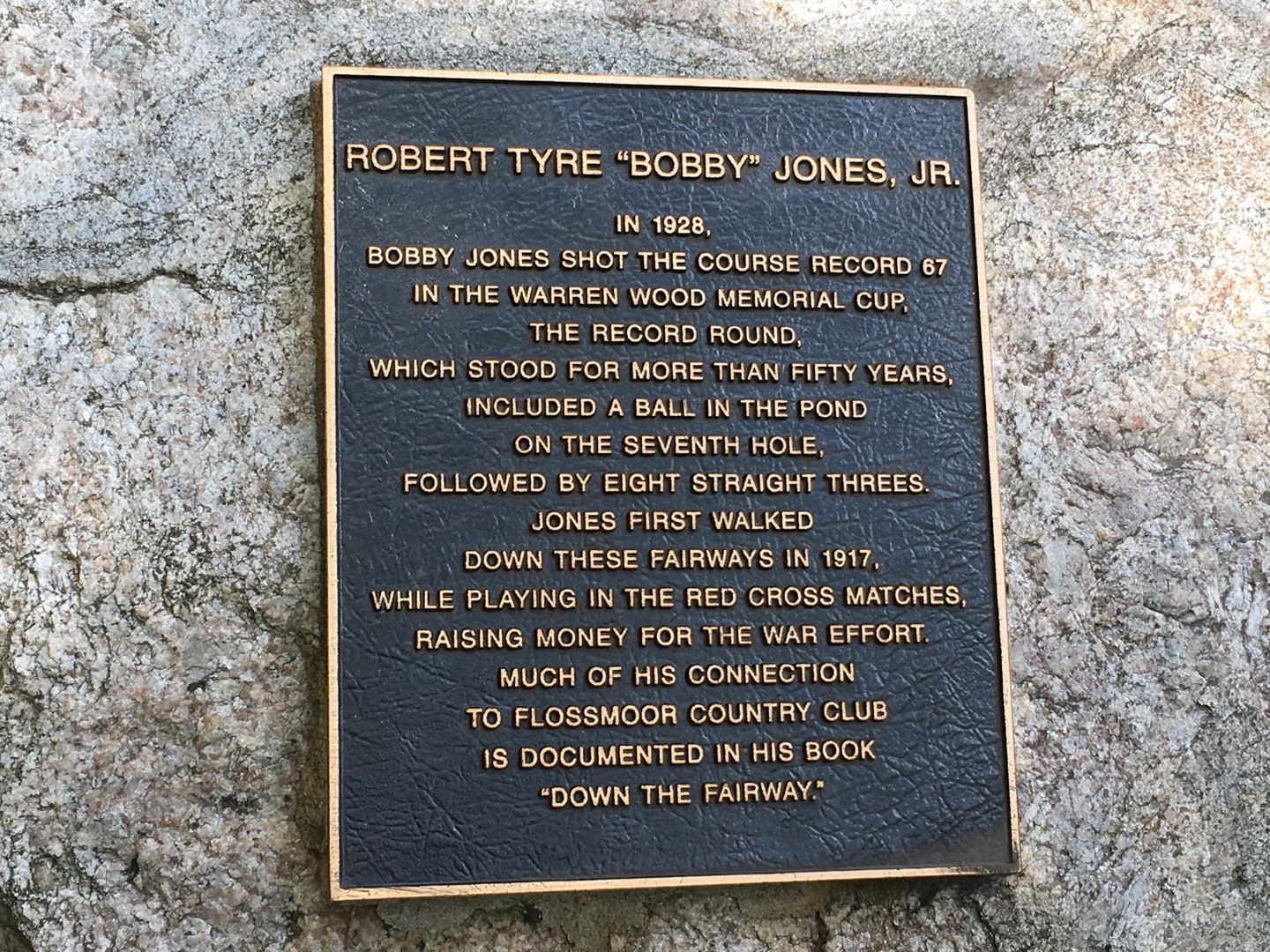
But while Flossmoor was hosting major championships, its new neighbor Olympia Fields Country Club was building one of the country’s finest golf facilities boasting four courses by 1925, and becoming Chicago South Suburbs’ best golf club. It inevitably cast a shadow over Flossmoor, as well the other clubs in the crowded golf neighborhood – Ravisloe, Idlewild and Calumet.
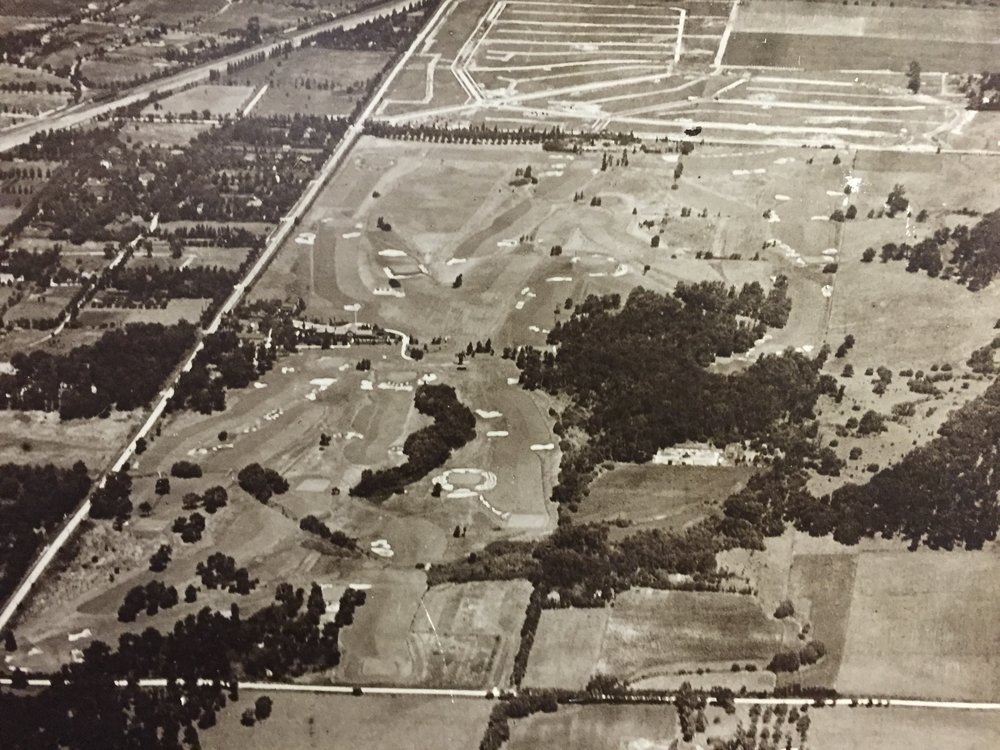
An early layout of Flossmoor - Photo Credit: Ian Gilley @igilley
The course
Flossmoor is a course that takes many plays to truly grasp. With every round my appreciation for the golf course’s architecture and the strategy needed to score well grows. Its topography is a tale of two nines. The front is relatively flat, while the back nine moves to the more dramatic piece of the property with almost every hole featuring a significant rise or drop. Like its neighbor Olympia Fields’s North Course, Flossmoor possesses world-class par-4s including the 3rd, 6th, 15th and 17th.
Flossmoor’s single strongest feature is its incredible green complexes – some of the most strategic and challenging that to be found anywhere. The great variety in size and slope stand out, and they require players to be on the correct side of the hole to make an aggressive stroke. The challenging green complexes dictate the necessity for good ball-striking as approaching from the fairway is necessary in order to control distance and spin on the approach shot.
As was the case with many courses of the era, Flossmoor became overgrown with trees, its bunkers eroded badly, and the greens shrunk. In the mid-2000s, the club hired Ray Hearn to work with Superintendent Bob Lively on polishing up their gem. Hearn’s work is best described as a combination of restoration and renovation. He did a remarkable job restoring the greens and removing thousands of trees (although a great many could still go). He changed 3 holes, and completely revamped the bunkering.
While the tee shots generally have wide corridors, Hearn did a great job moving fairway bunkers to account for modern technology, and shrink landing areas for longer players. The updates won Flossmoor the 2009 award for Renovation of the Year and returned the course to its former status as one of the area’s finest championship tests.
Although the repositioning of bunkers returned strategy to the holes, Hearn’s choice of style has been polarizing. He seems to have drawn upon the more artful shaping of the “Eleanor’s Teeth” bunker that fronts the 16th green and spells the word “JAIL”. Purists would have rather seen him return to the course to its original simpler bunker style as evidenced in the aerial above, but Hearn made a conscious choice to go in a different direction. In a 2012 interview on GolfClubAtlas, Hearn explains his rationale:
“Coming up with this bunker style took a lot of thought and time…I paid tribute to Mr. Tweedie’s routing and his wonderful green complexes, but had a difficult time researching his bunker style…I got out a shovel and a soil probe and went on an archeological dig, searching for both old bunkers and lost green edges…During the time the course was built (1899 and 1900), both construction and maintenance equipment were very limited, so I took the liberty to dream a bit. As I was impressed with Mr. Tweedie’s routing and green design, I decided to elevate the strategic and aesthetic significance of the bunkers. I labored over this decision for weeks, often lying awake at night thinking of all the options. I finally decided on an irregular-edge bunker style. My rationale was that Tweedie’s routing and green complexes were so well done that the course deserved great bunkers. I believed these remodeled bunkers would emulate a more classical look and feel.”
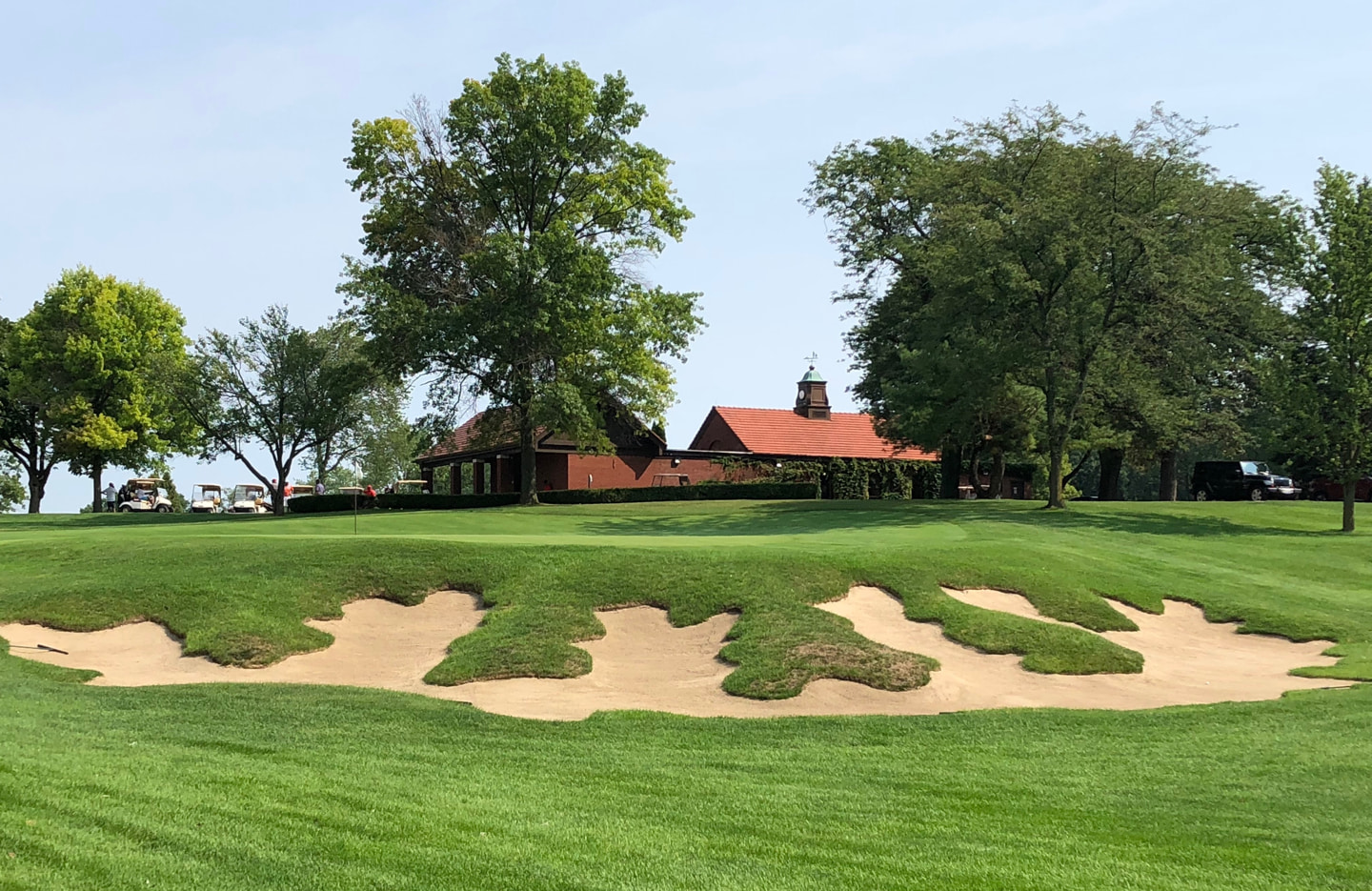
The Eleanor's Teeth bunker on Flossmoor's 16th.
Love ’em or hate ’em, the bunkers at Flossmoor are certainly distinctive, especially in comparison to other courses in the area. In combination with the routing, the greens, and the fantastic stretch of golf on the back nine, Flossmoor is a must play for lovers of classic architecture.
HOLE #1 – 499 yards – par 5
The course kicks off with the short par-5 which offers up one of the few good birdie opportunities. The tee shot is made difficult by fairway bunkers on the right and left that pinch the fairway at 290 yards. A tee shot that finds the fairway will give a player a chance to go for the green, while one that misses will likely lead to a layup. The hole is made tricky by the large green that severely slopes away from the player and from left to right. The slope makes it tough to hold the green on a long second shot, and wreaks havoc on any third shots that come from the rough and lack spin.
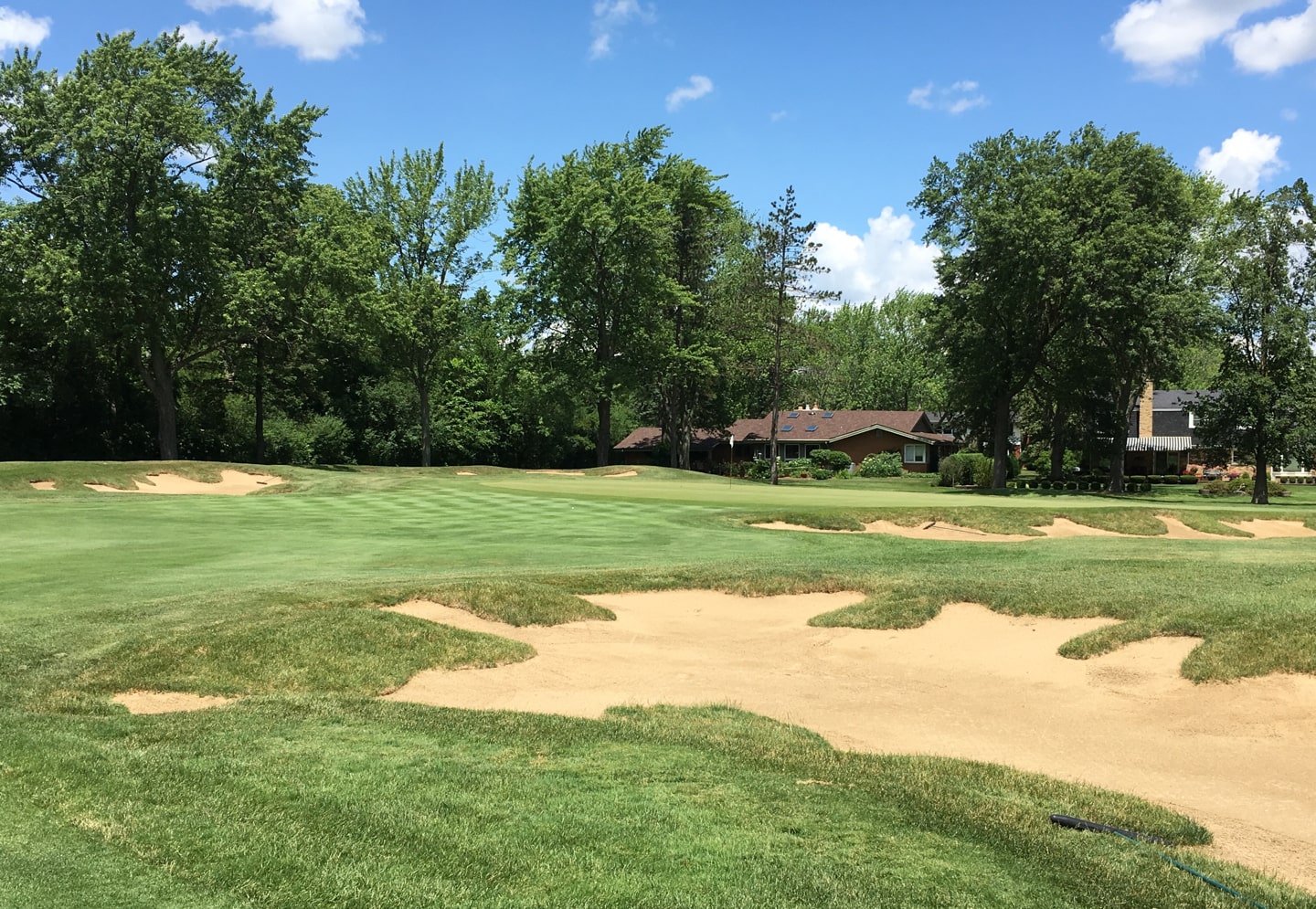
Short of the 1st green, which runs away
HOLE #2 – 213 yards – par 3
The 2nd hole is the first of Flossmoor’s four par-3s, each of which tests a different aspect of a player’s iron game. The long 2nd favors a right to left shot shape, and requires a long-iron. The green slopes severely back-to-front and is angled slightly to the left, making the best place to miss short of the green, leaving a simple uphill chip.
-
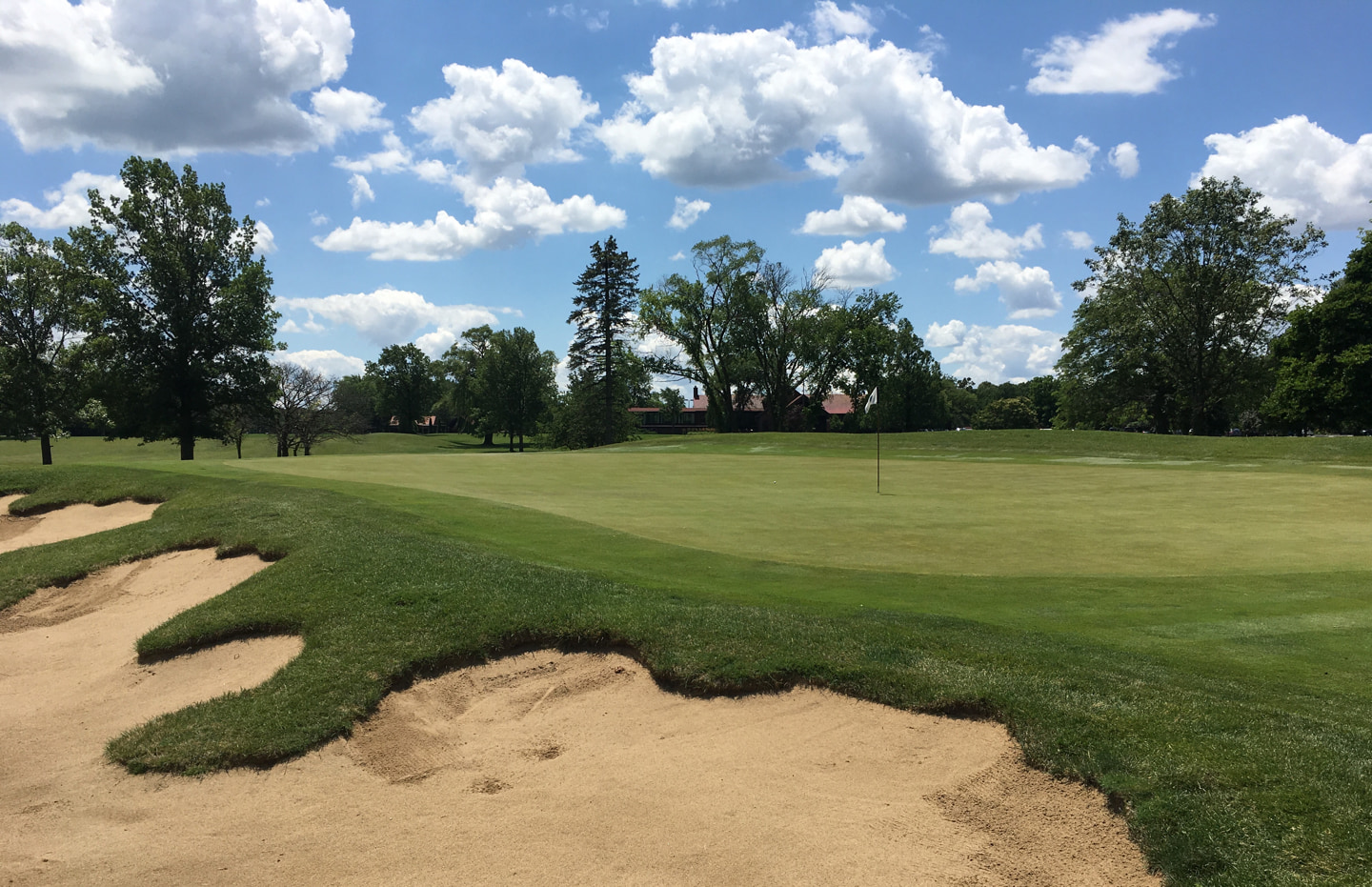
Bunker guarding the left side of Flossmoor's 2nd
-
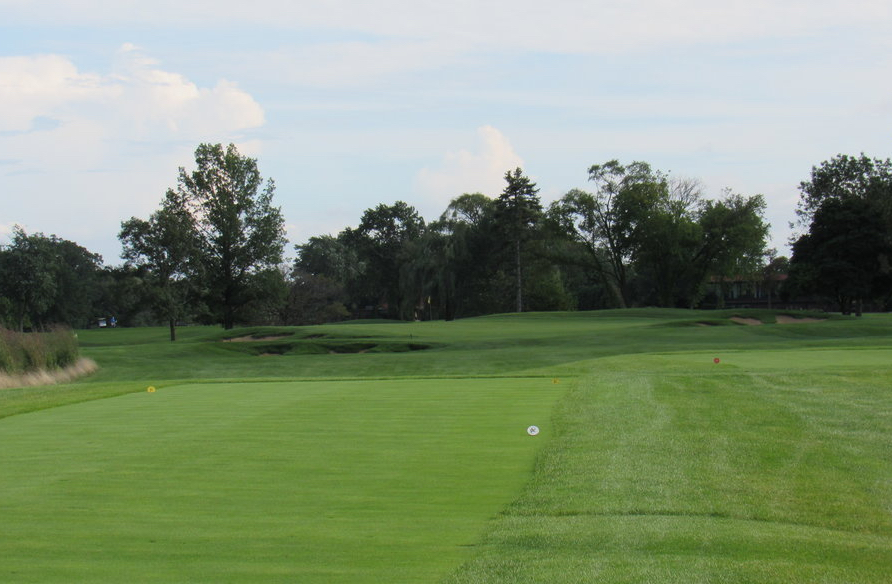
An early test of long iron play
-
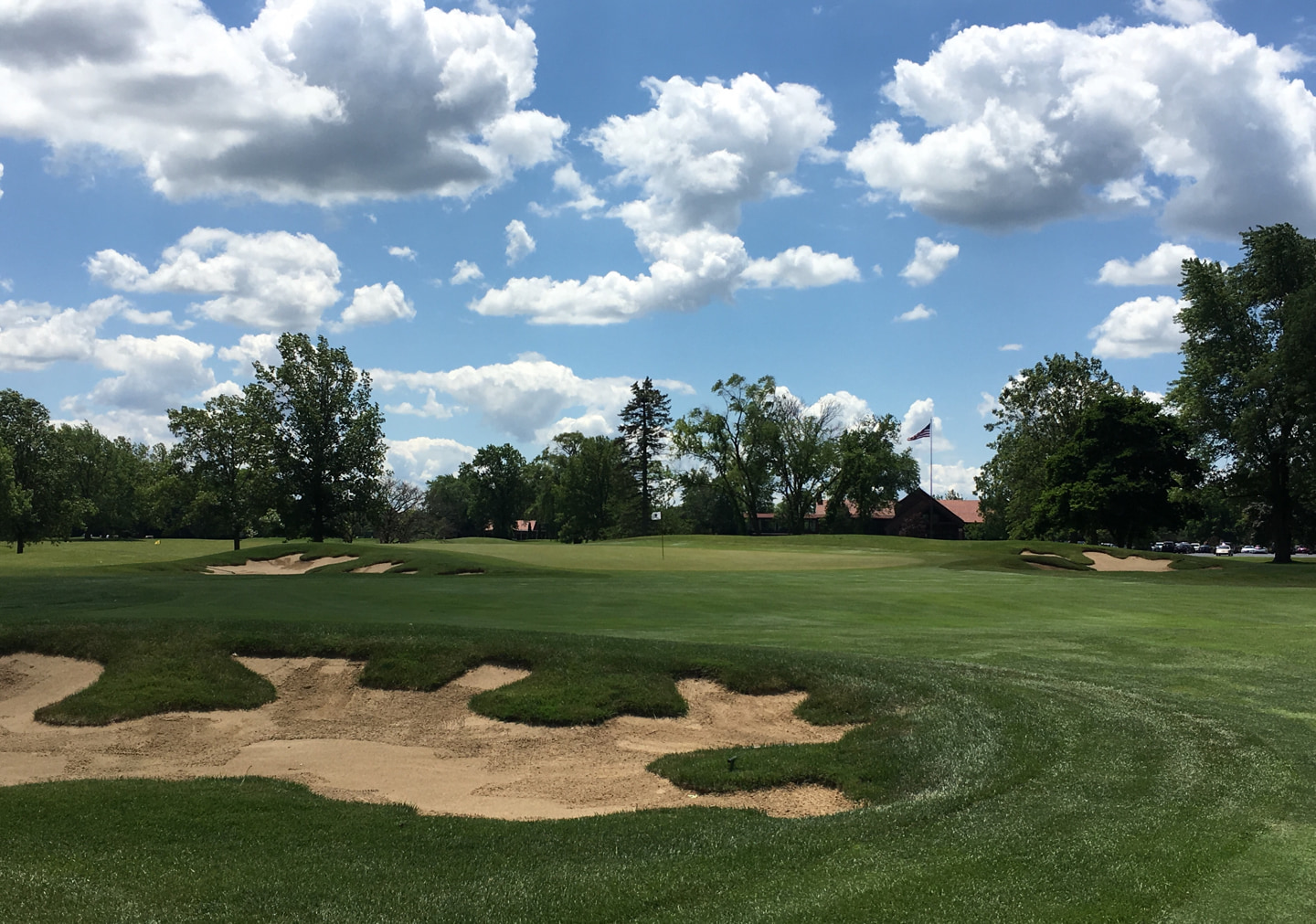
A forebunker adds to the visual deception
-
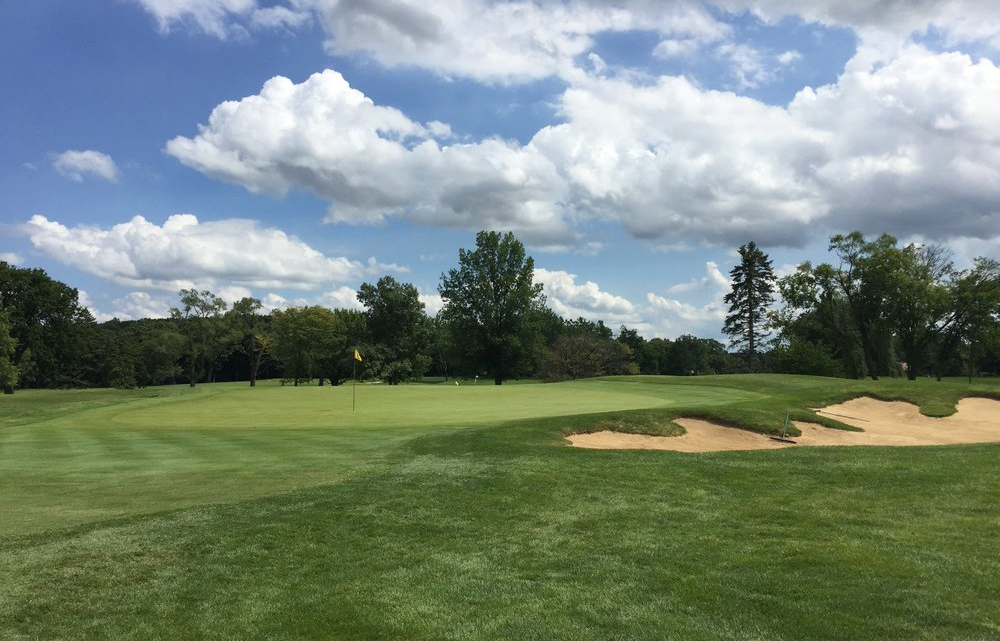
The 2nd gree with its challenging contours - Photo Credit: Ian Gilley
HOLE #3 – 434 yards – par 4
Up next is the first of Flossmoor’s many great par-4s. The fairway at the 3rd is bisected by a small creek that runs diagonally and sits at roughly 265 yards from the back tees. Long-hitters can carry it, especially with a helping south wind. Laying up short of the creek will leave a mid to long iron approach to a magnificent green complex. The green viciously slopes from right to left with a subtle back to front slope. Any putt or chip shot from right of the hole is extremely difficult, making the ideal place to miss the green short and left.
-
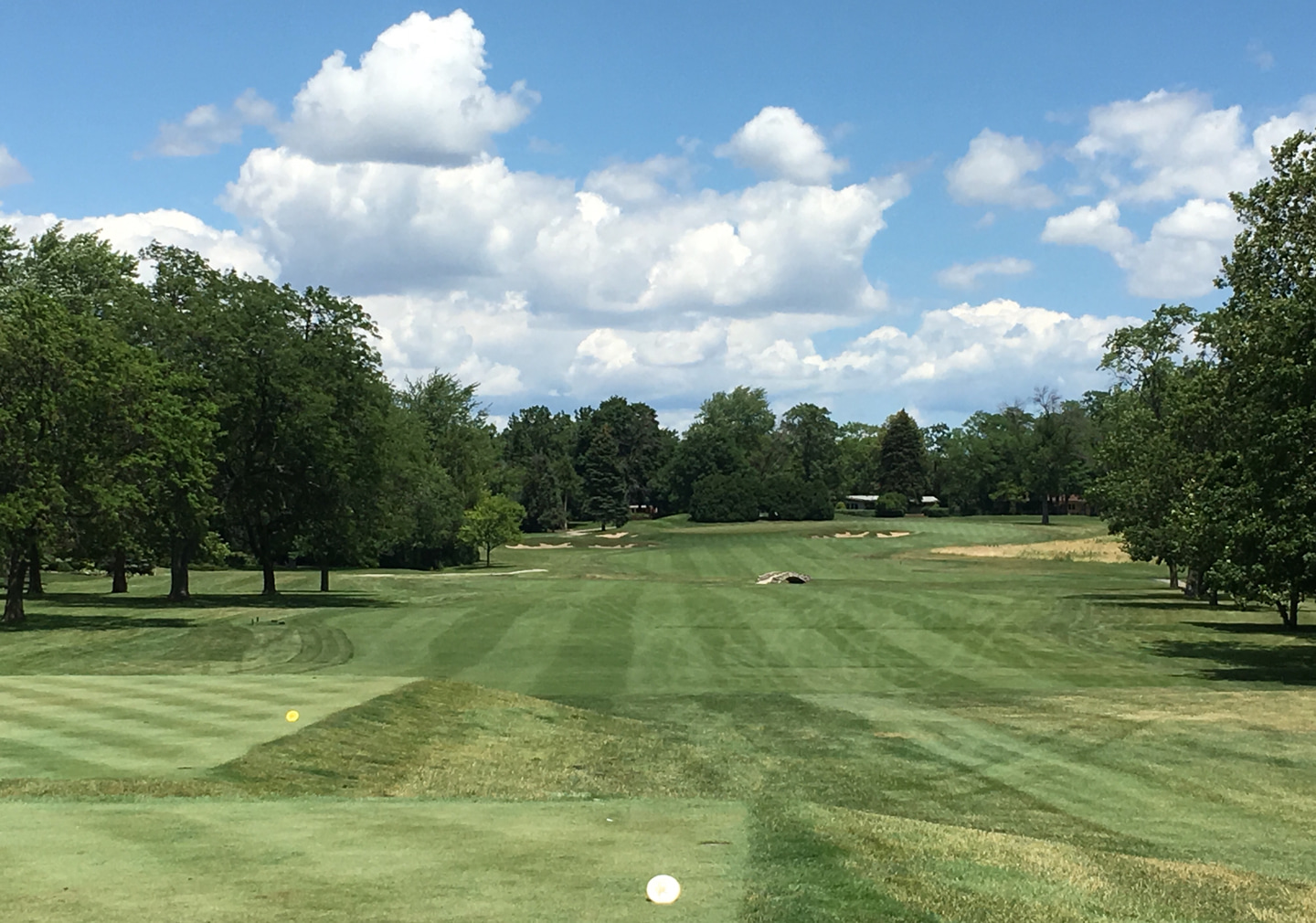
The tough tee shot at the 3rd
-
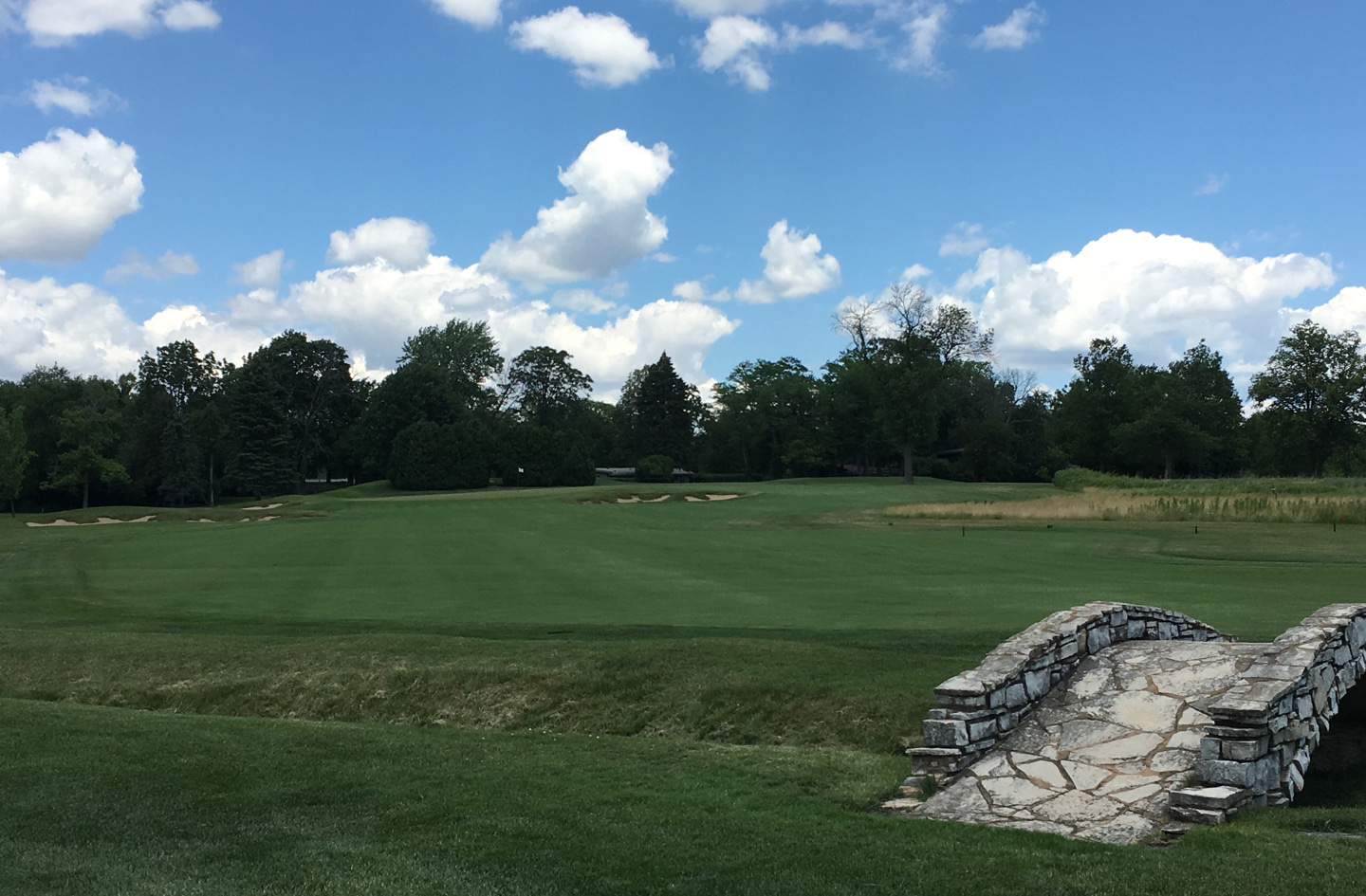
A creek cuts across the fairway
-
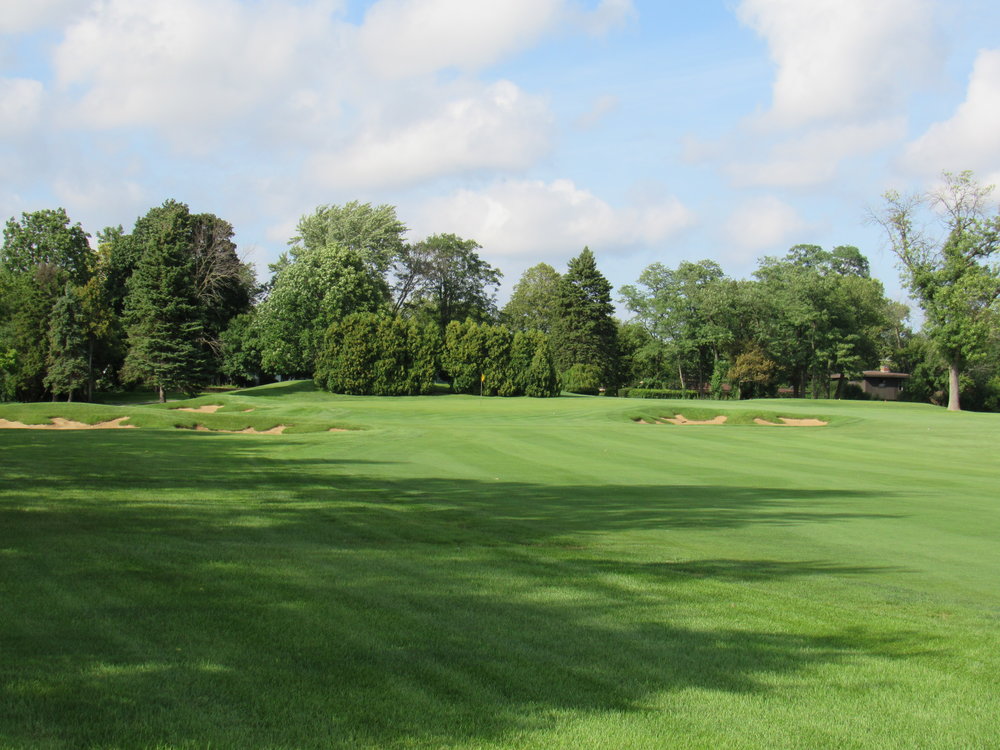
Approaching the green on the 3rd
-
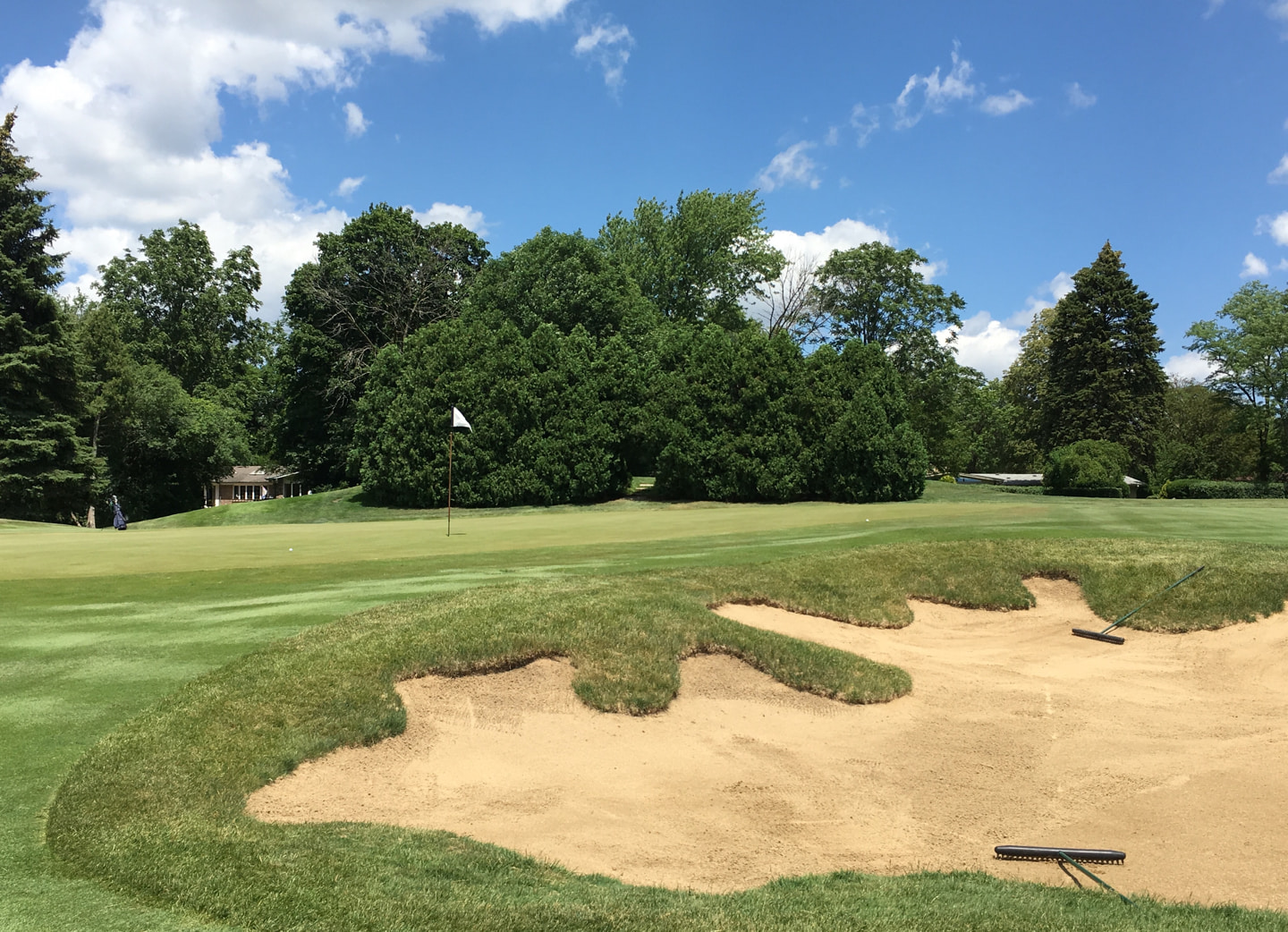
Missing right is not the play
-
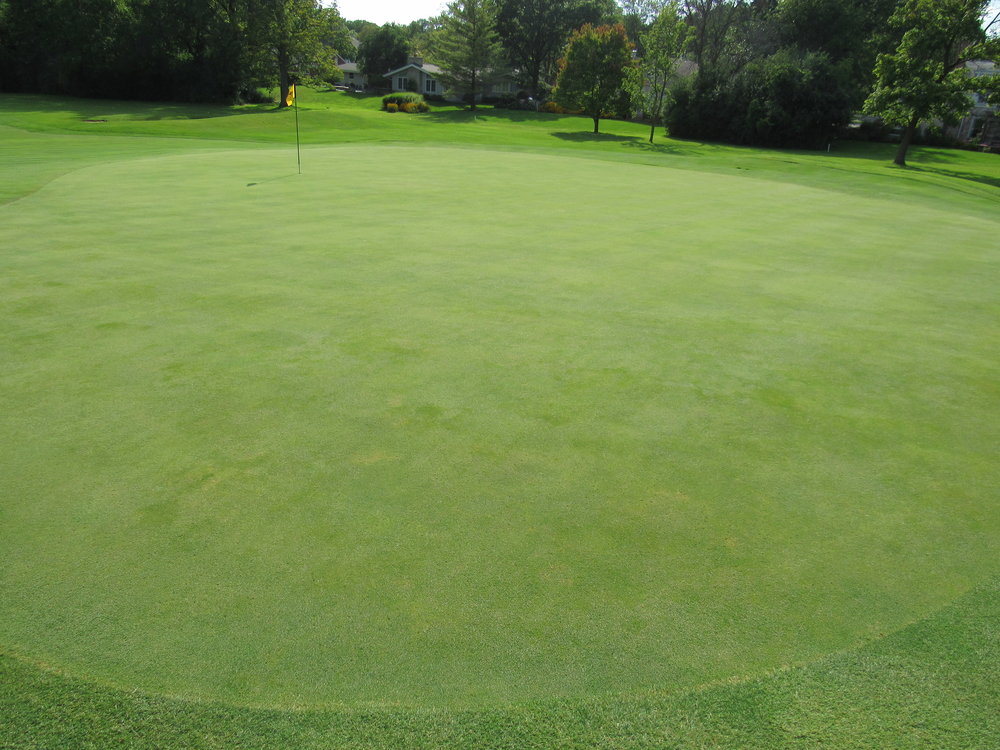
The 3rd's outstanding green
HOLE #4 – 331 yards – par 4
Few holes at Flossmoor present a player with more options than the short par-4 4th. While it only measures 331 yards, this hole ruined many rounds. A 260-yard tee shot seems to be the play here, but longer players will often give the green a run with their driver. If a player’s tee shot finds a fairway bunker, it will leave an awkward 40-70 yard sand shot to a difficult green, with out of bounds long and left. The green is very narrow and slopes hard from back-to-front and left-to-right, making any putt difficult except for one directly below the hole. If played well, the 4th presents a great birdie opportunity but a poor shot can lead to a double or worse.
-
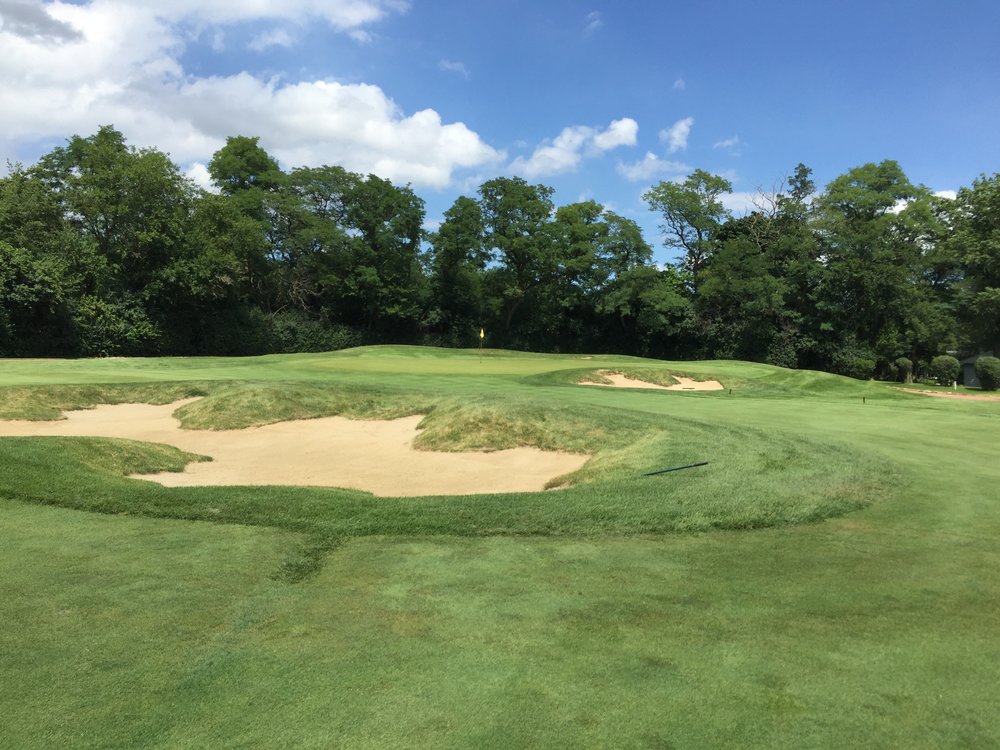
Approaches into the 4th must be exact - Photo Credit: Ian Gilley
-
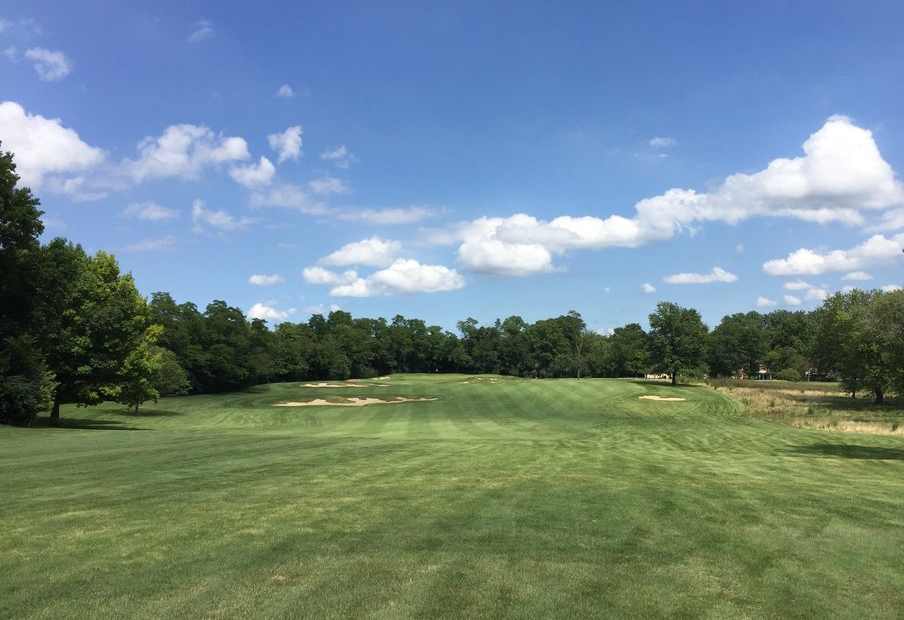
Options presented on the tee of Flossmoor's 4th - Photo Credit: Ian Gilley
-
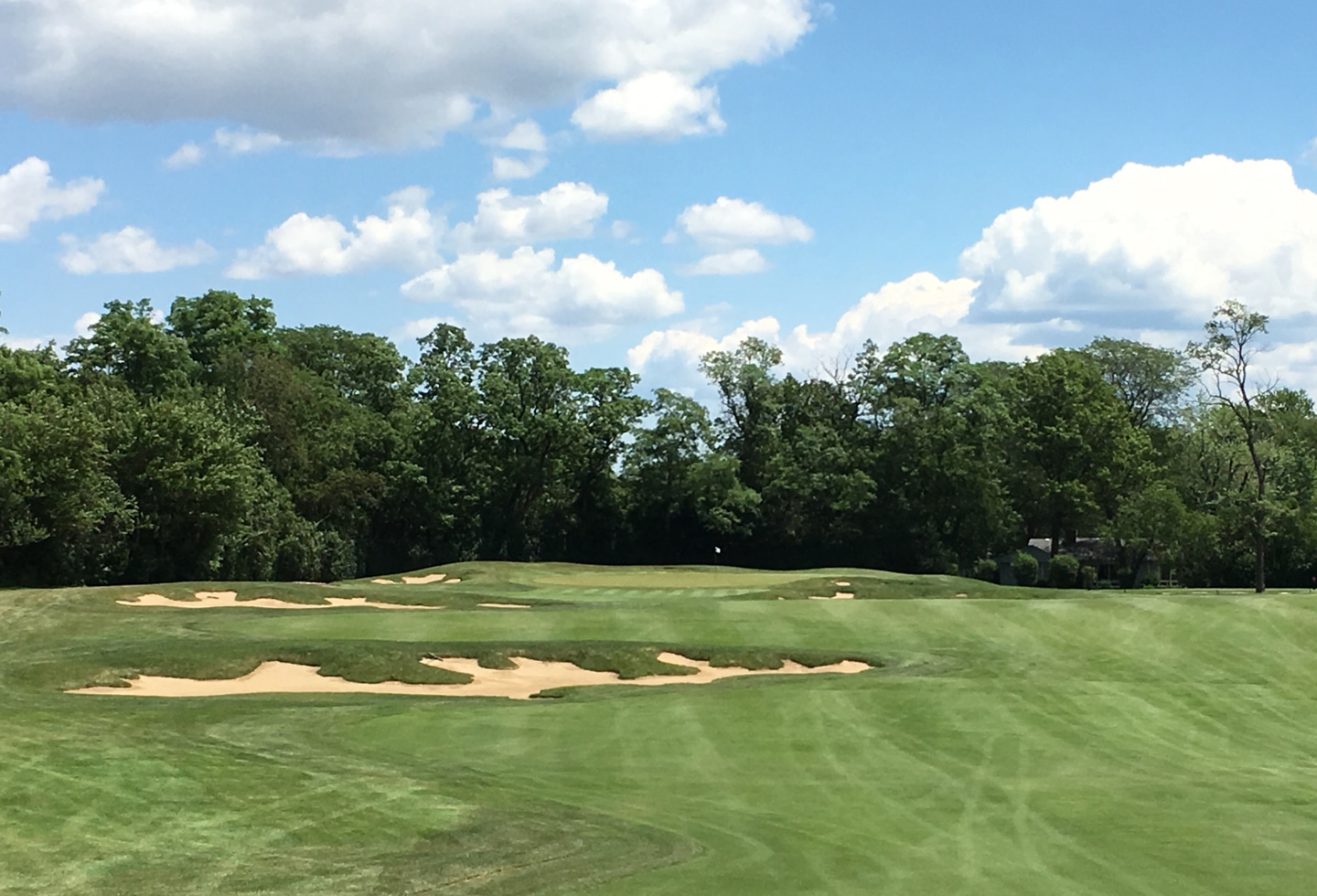
Bunkers strategically encroaching on the fairway
HOLE #5 – 445 yards – par 4
While the driving corridor at the dogleg left 5th is very wide, fairway bunkers on either side of the fairway pinch the landing area at 280 yards. The 5th has an extremely small green for a 400+ yard par-4, and to make matters tougher the putting surface has a spine that runs through the middle. The small green puts a premium on finding the fairway in order to control spin and distance for the approach.
-
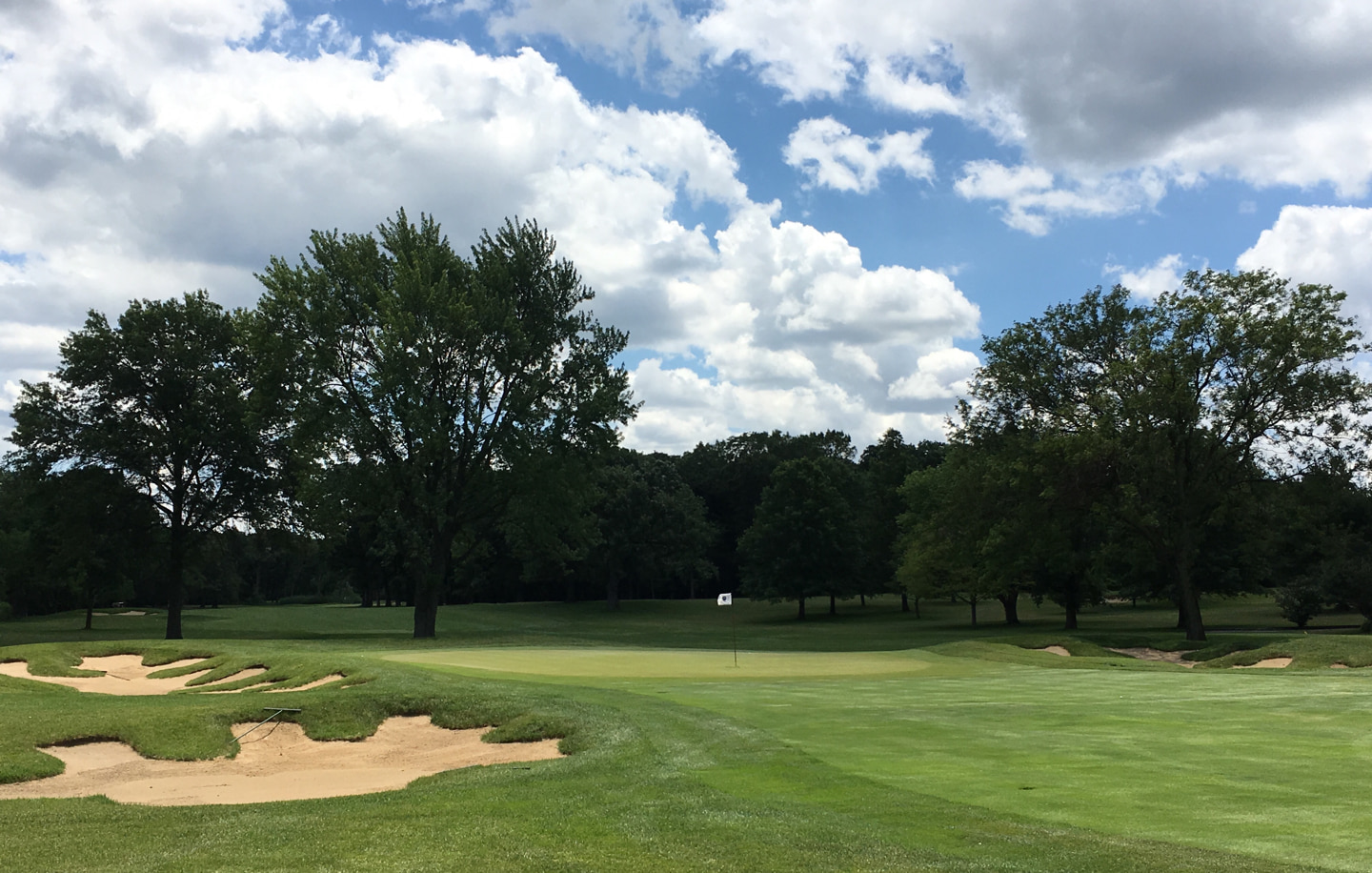
The tiny green at Flossmoor's 5th
-
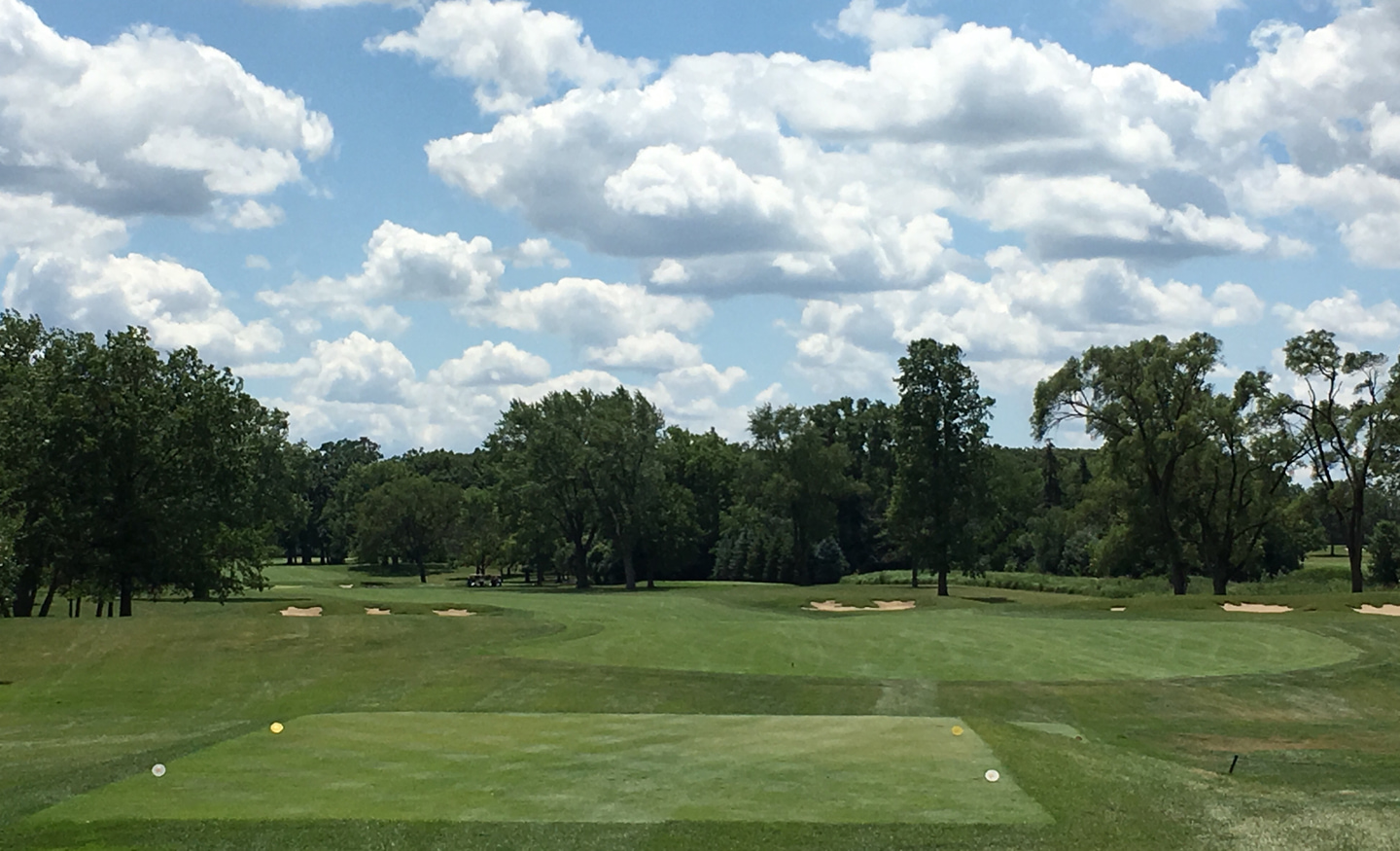
A right-to-left shot shape is preferable on this tee
HOLE #6 – 434 yards – par 4
The 6th hole has been known to give regular visitors to Flossmoor nightmares. As a player who likes to move the ball from right to left, its tee shot legitimately frightens me. Bobby Jones called it “The Difficult Sixth” after playing it in the 1923 U.S. Amateur. The hole doglegs hard to the right and has out of bounds running down the left side. A miss left can lead to a stroke and distance penalty, and right isn’t much better as there are an abundance of mature oak trees. Players hit everything from driver to 4-iron on this relatively long par-4. A tree overhangs the right side of the fairway, encouraging an approach the narrow, two-tiered green from the left.
-
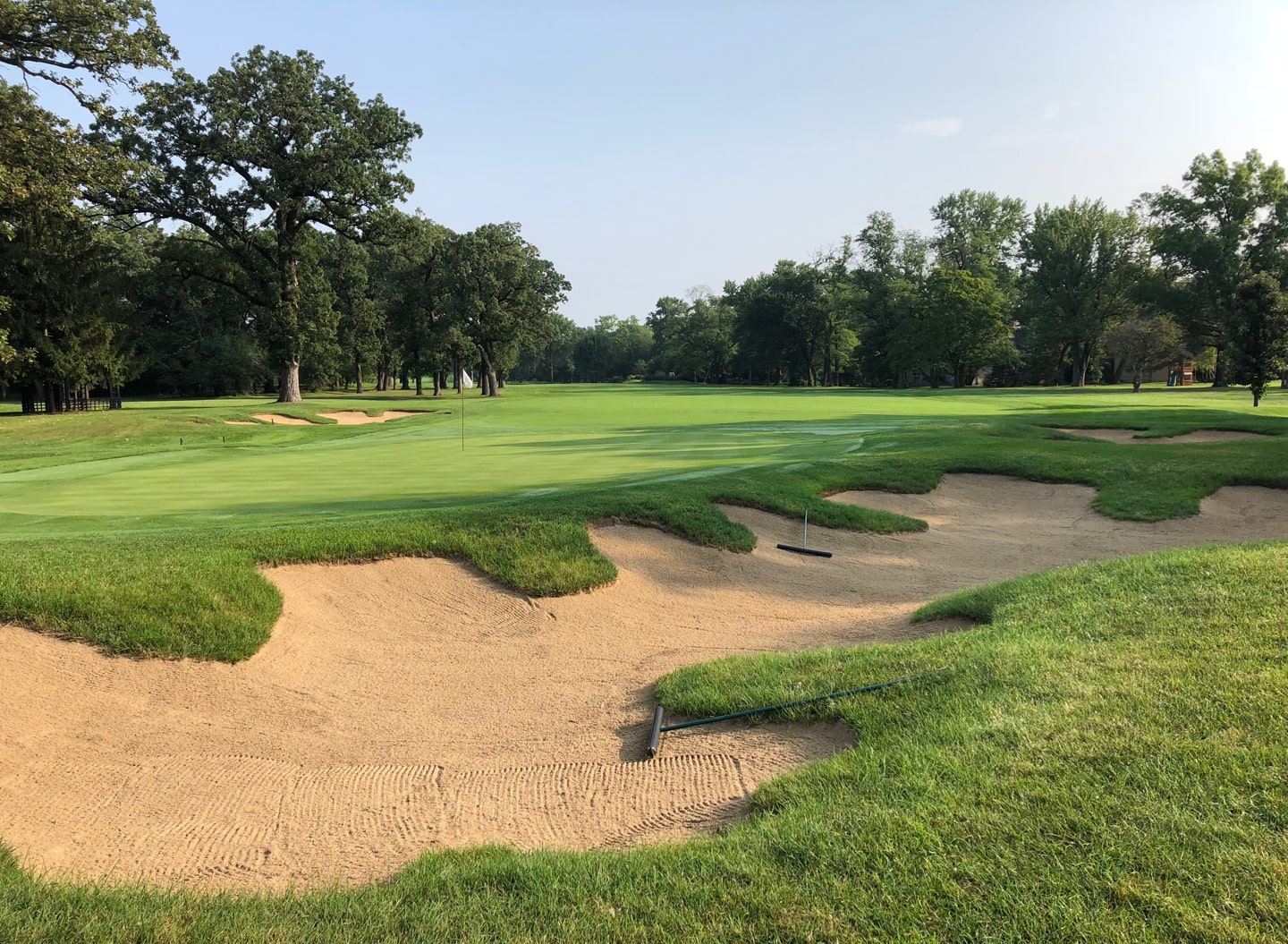
Looking back down the dogleg right 6th
-
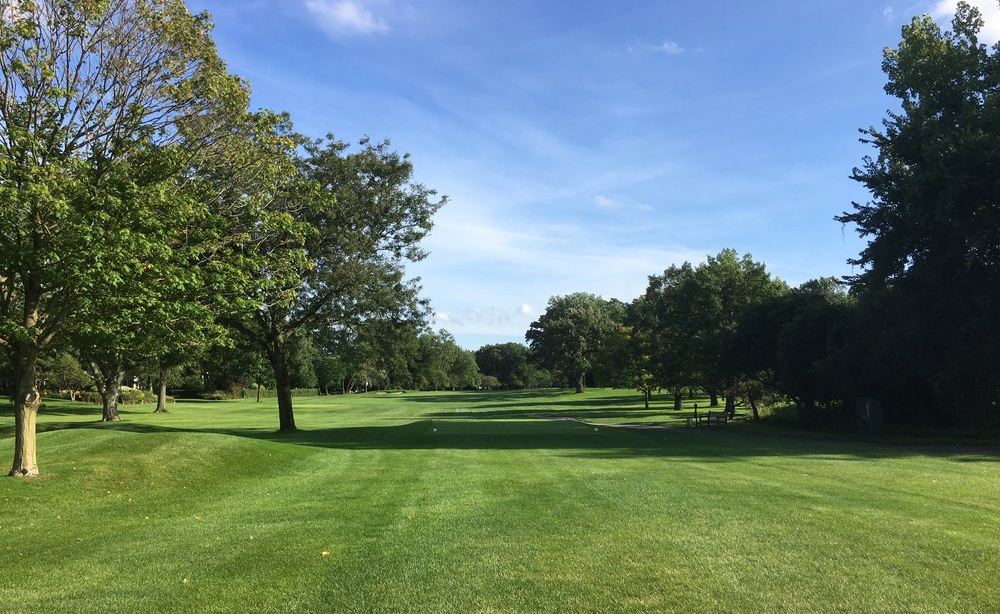
A truly terrifying tee shot
-
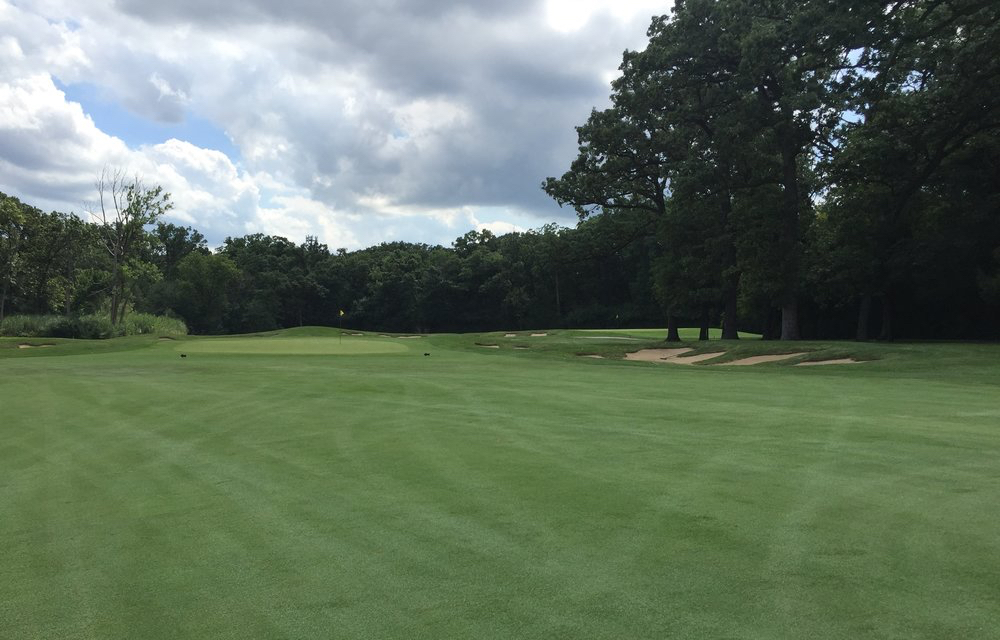
Approaching the green on the 6th from the preferred angle - Photo Credit: Ian Gilley
-
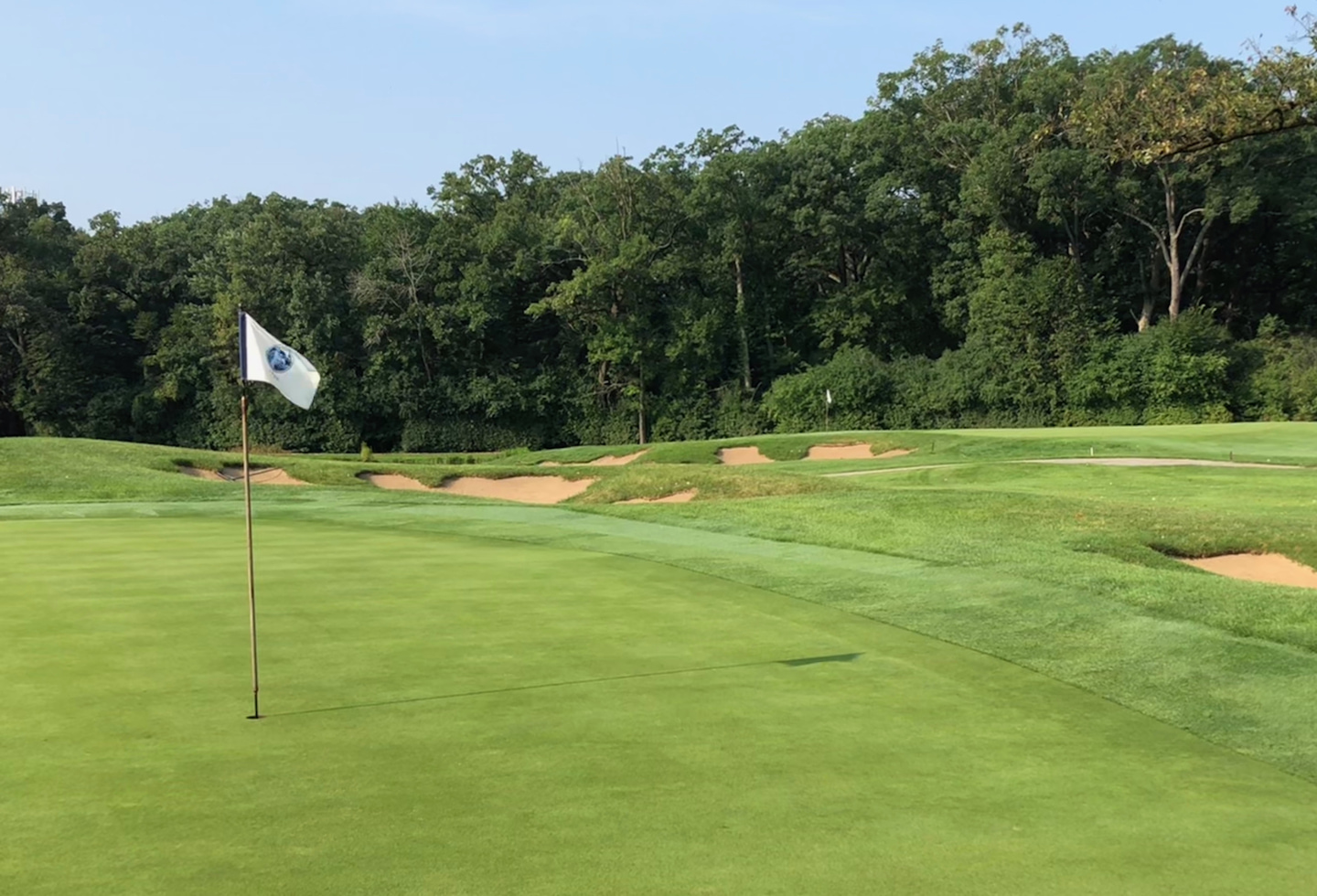
The green at the tough 6th, with the 7th beyond
HOLE #7 – 173 yards – par 3
The second par-3 is the beautiful 7th which plays over water to a plateau-style green. The tee box is set back in a heavily wooded area, making judging the wind extremely difficult. Misses left and long will find a runoff area leaving a delicate pitch shot to a green that slopes from front to back and left to right.
-
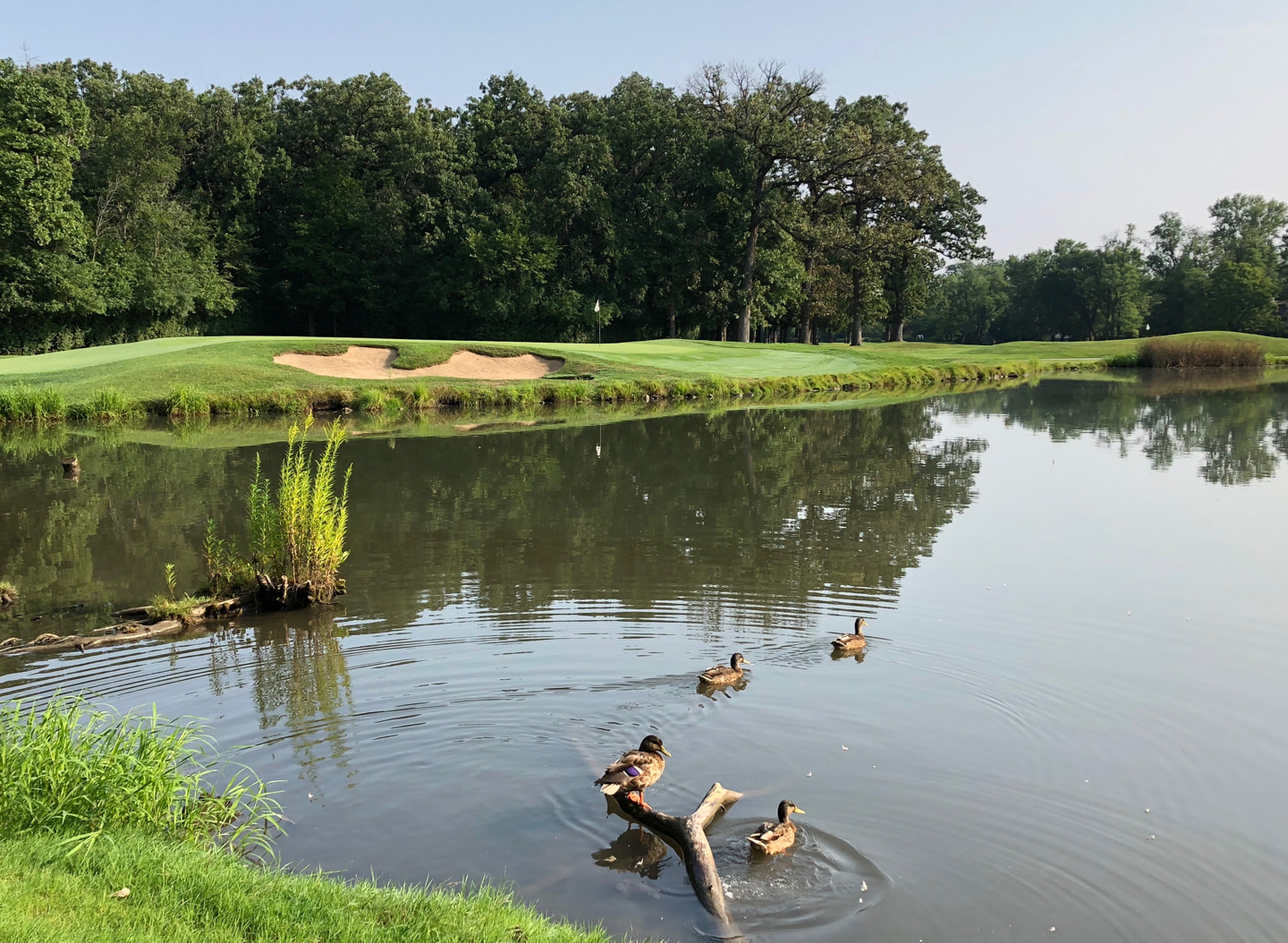
Approaching the beautiful 7th green from the left
-
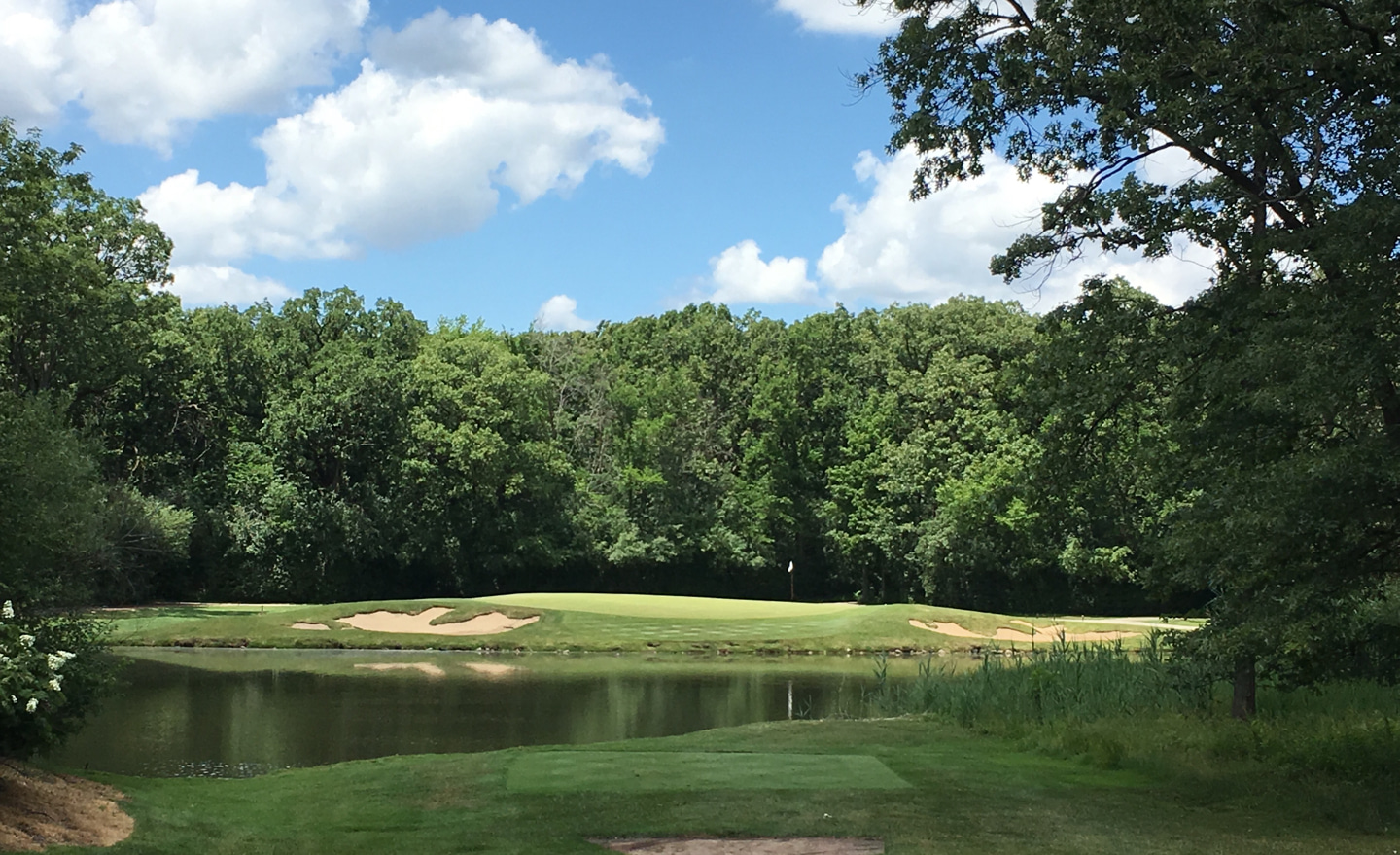
The tee shot on the 7th, set back in the chute
-
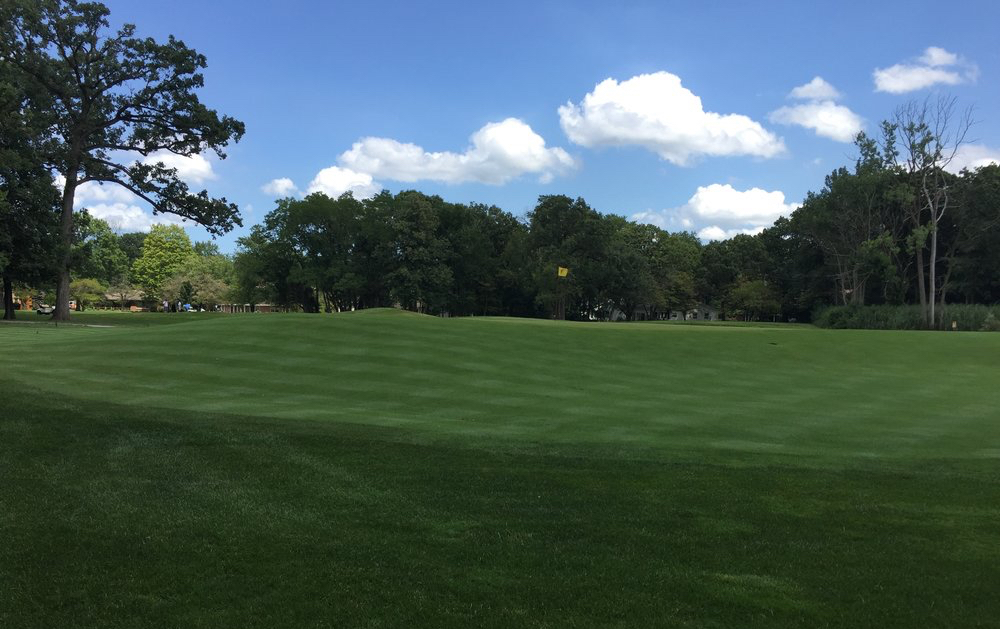
A short grass run-off leaves tricky recoveries - Photo Credit: Ian Gilley
HOLE #8 – 461 yards – par 4
When Ray Hearn remodeled Flossmoor in the mid-2000s, he made a drastic change to the par-4 8th, and the resultant hole feels out of place and awkward. Membership refused to allow him to take out mature trees on the right which led to an incredibly awkward tee shot. Because of the trees, the ideal tee shot is a giant slice. Fail to slice it and the ball will end up in fairway bunkers down the left side or in deep rough, creating a difficult long-iron approach to a green protected by a lake. A good drive will leave a mid-iron approach to a wide but shallow green that slopes from back-to-front and left to right.
-
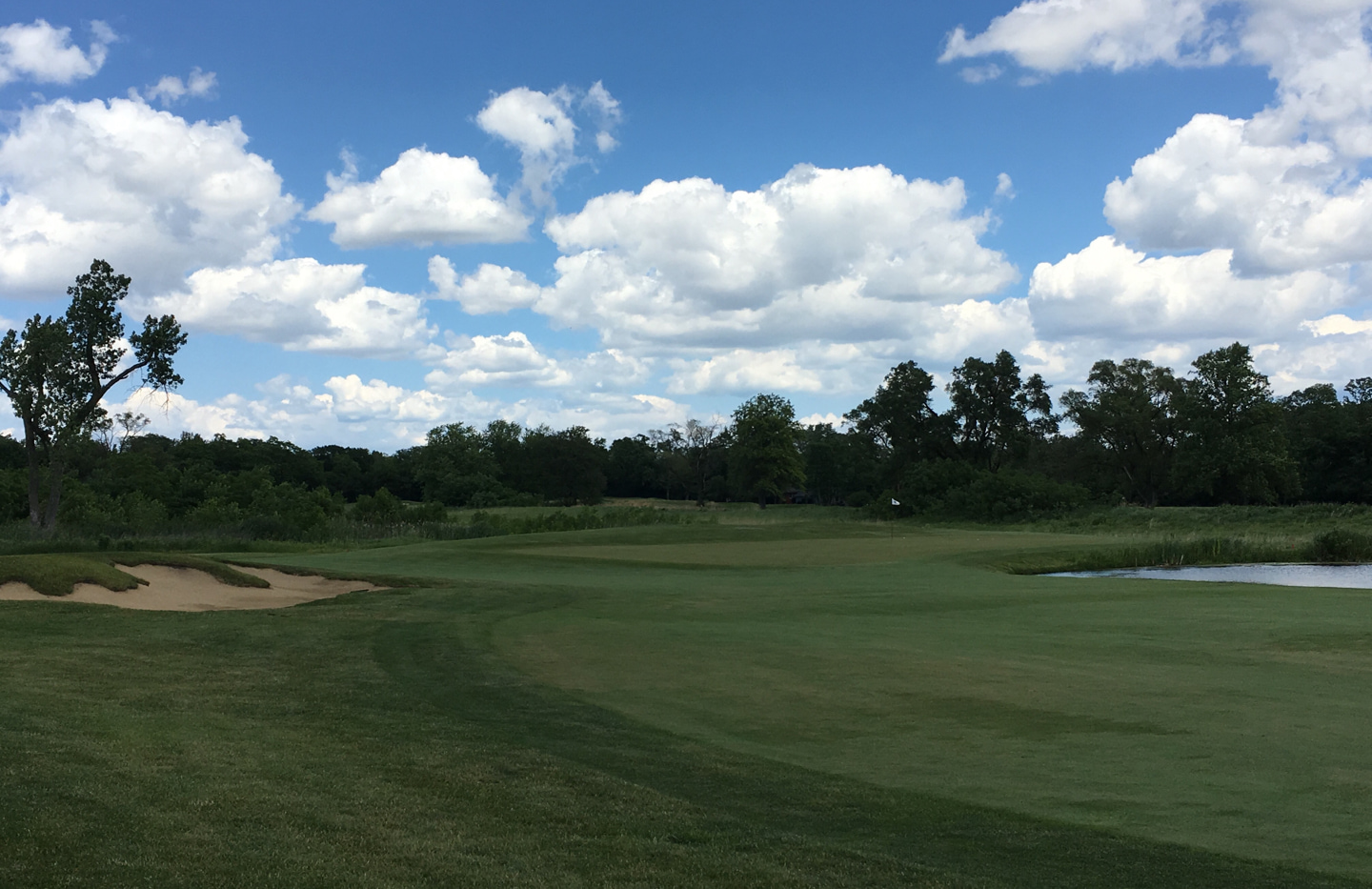
Approaching the 8th from the left side
-
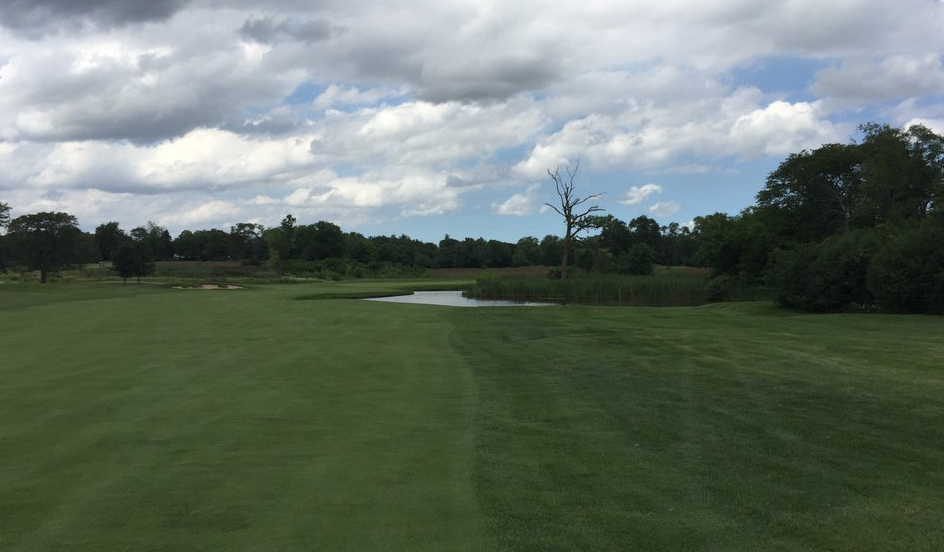
Short of the lake on the right - Photo Credit: Ian Gilley
-
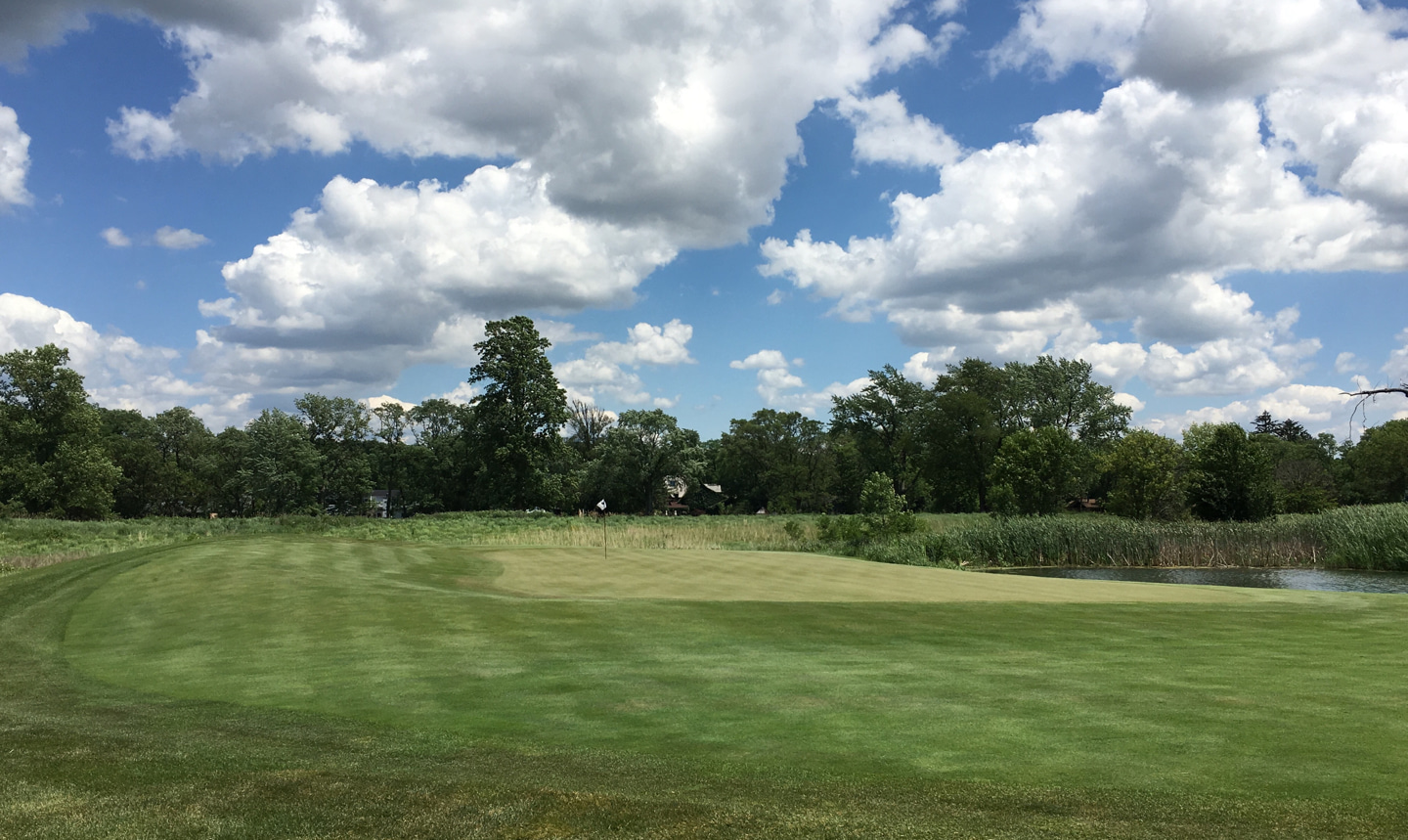
Left of the angled, narrow 8th green
HOLE #9 – 626/560 yards – par 5
The back tee at the 9th makes this a stout three-shot par-5. In almost all tournament settings, this hole is played from a forward tee which makes it reachable in two for a long hitter. The tee shot is relatively wide open, but hitting the fairway is key to getting the second shot over the hill which obstructs the view of the green. The putting surface at the 9th is one of the most deceptive to be found anywhere. From the fairway, it looks as though the green has considerable back-to-front slope, but in actuality it is very flat. It takes players multiple rounds to understand this green.
-
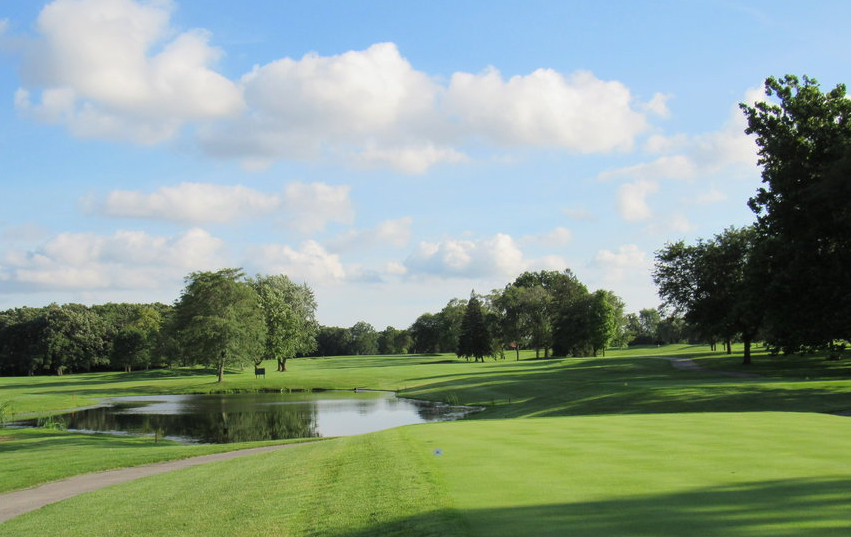
The 9th demands a great tee shot to score
-
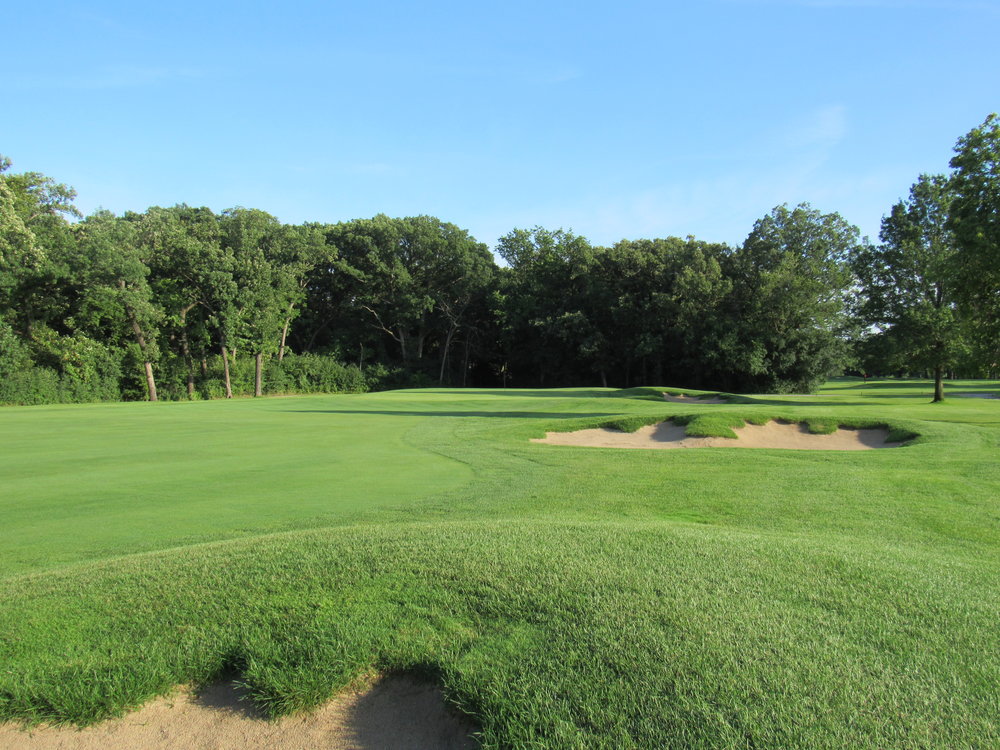
Approaching Flossmoor's 9th from the right
-
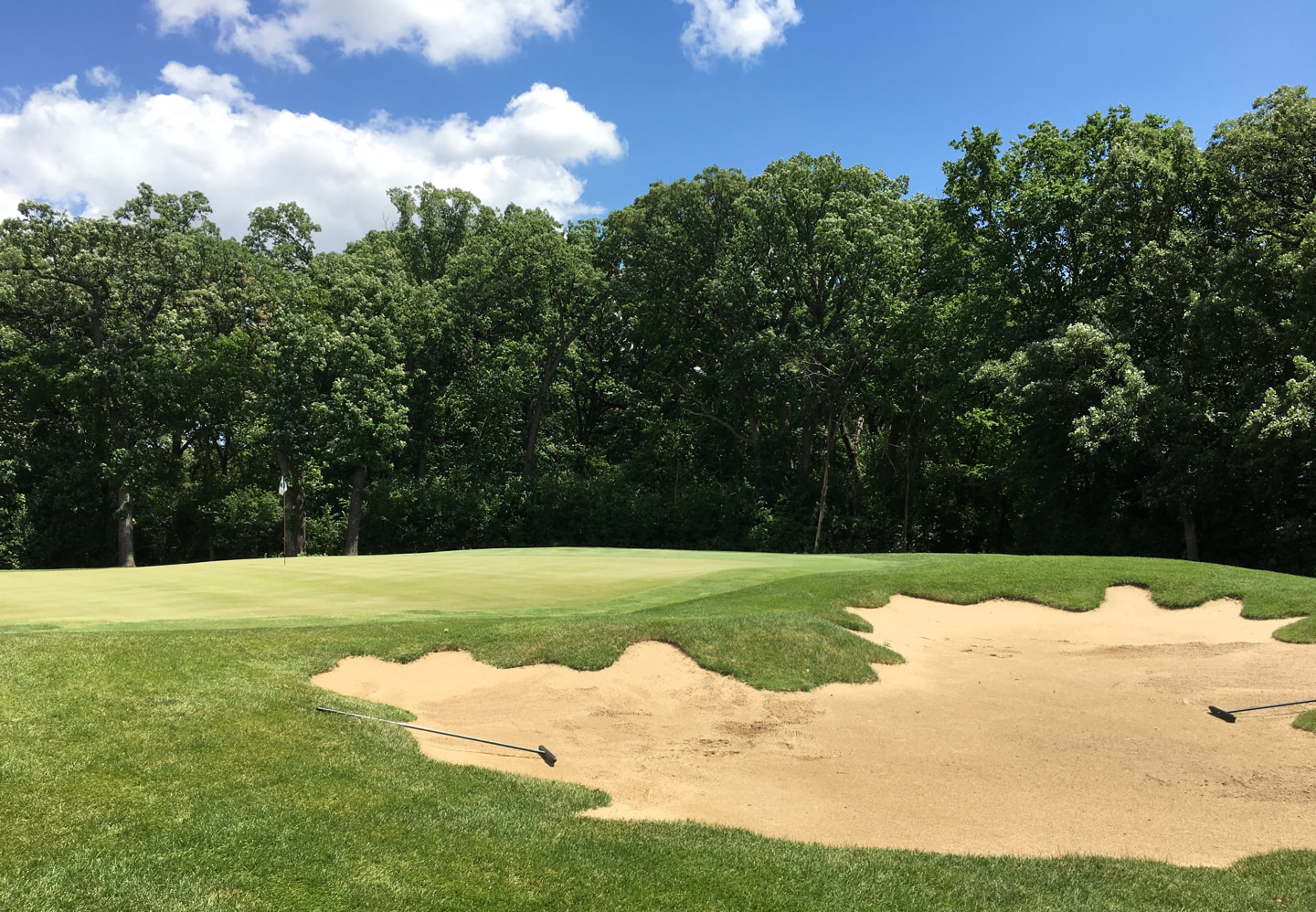
The tricky green at the 9th
HOLE #10 – 553 yards – par 5
The 10th is the second of consecutive par-5s and can yield disaster with out of bounds running down the entire left side. A good drive that finds the fairway and avoids the bunker on the right side will give a player a chance at getting home in two. This hole is where players begin to experience Flossmoor’s great topography. The green is situated in a valley and is extremely sloped from back to front. When the course is playing firm and fast, anything long is almost impossible to keep on the green.
-
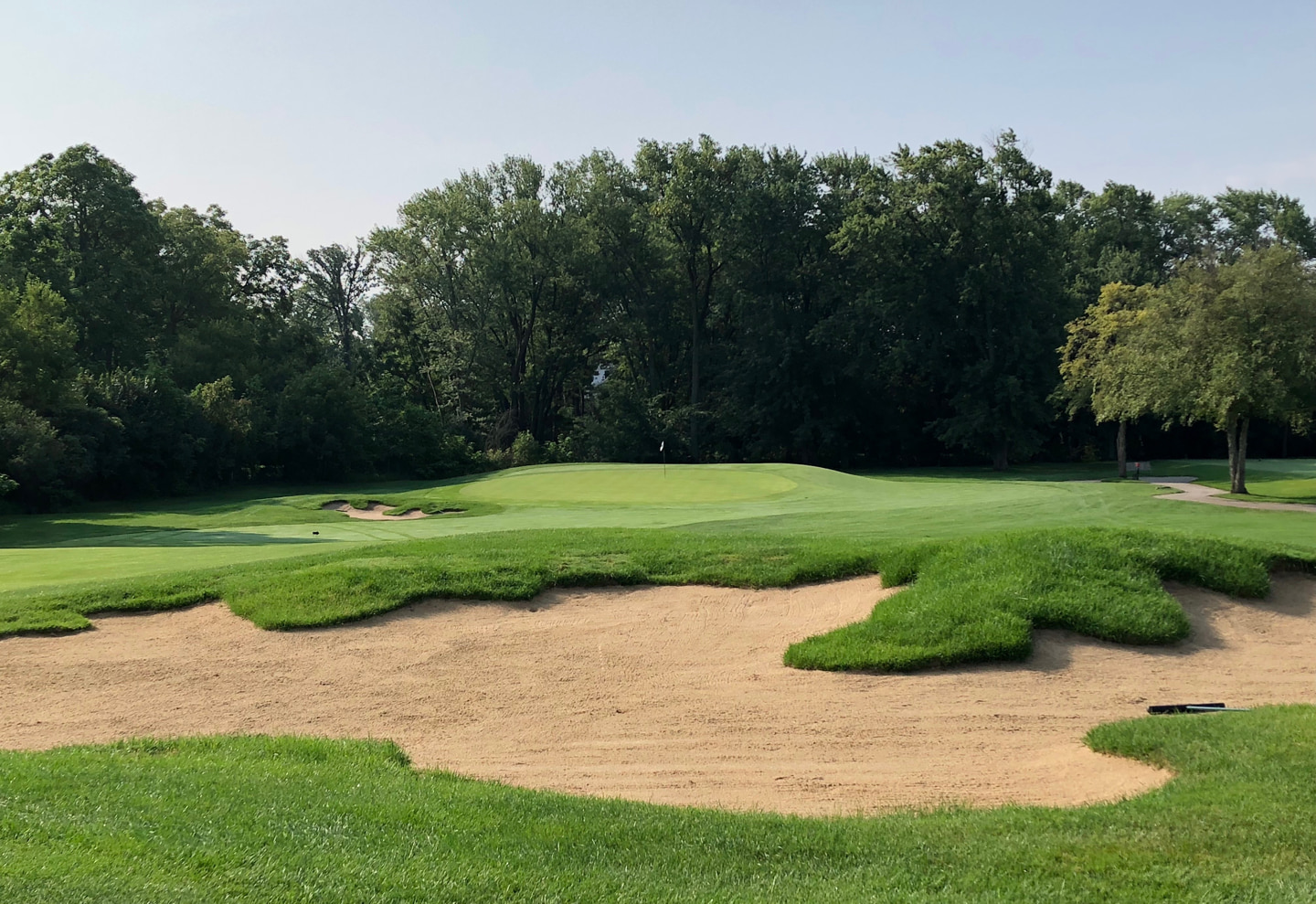
The 10th is heavily canted from back to front
-
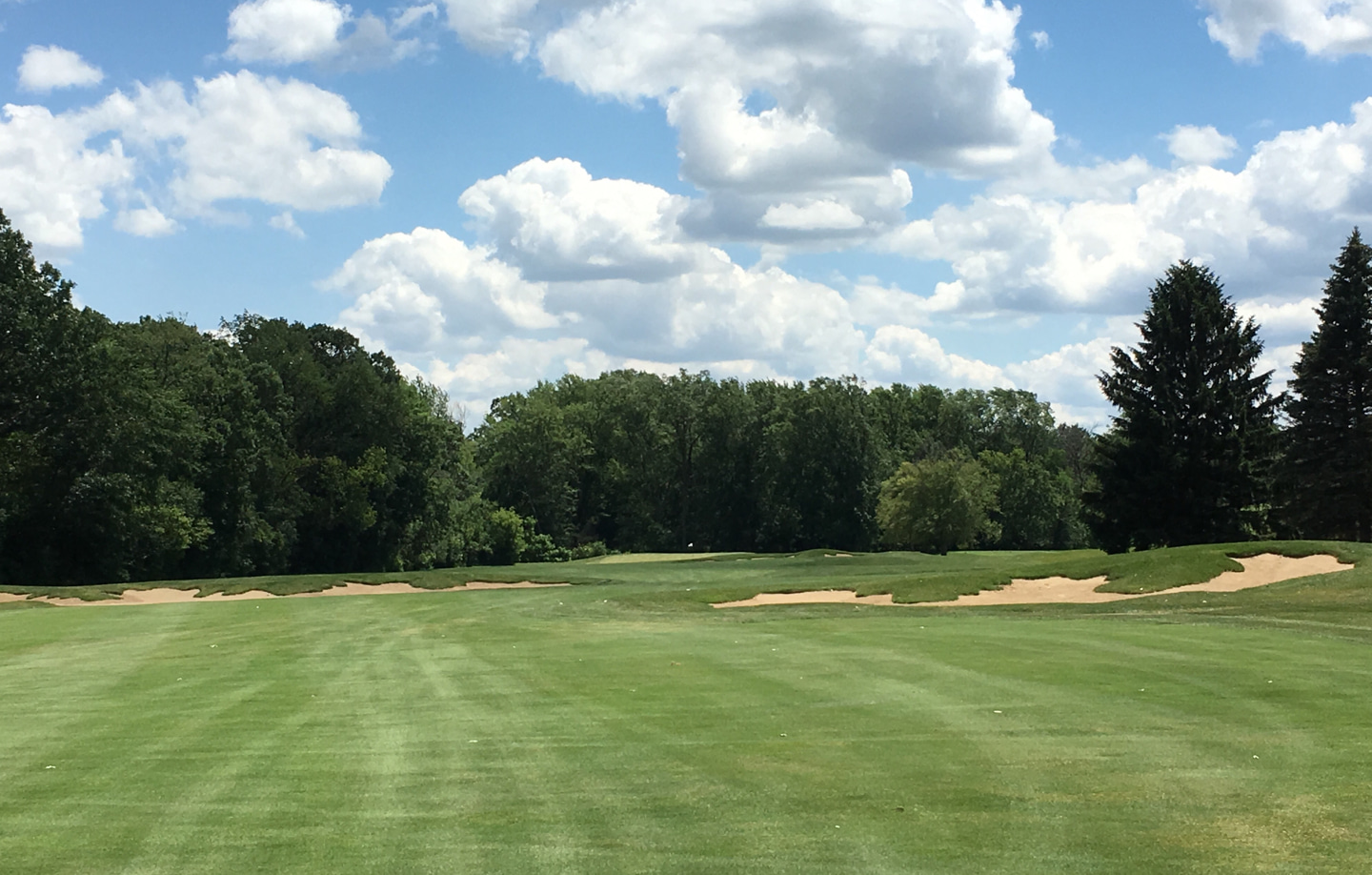
The downhill approach into Flossmoor's 10th
-
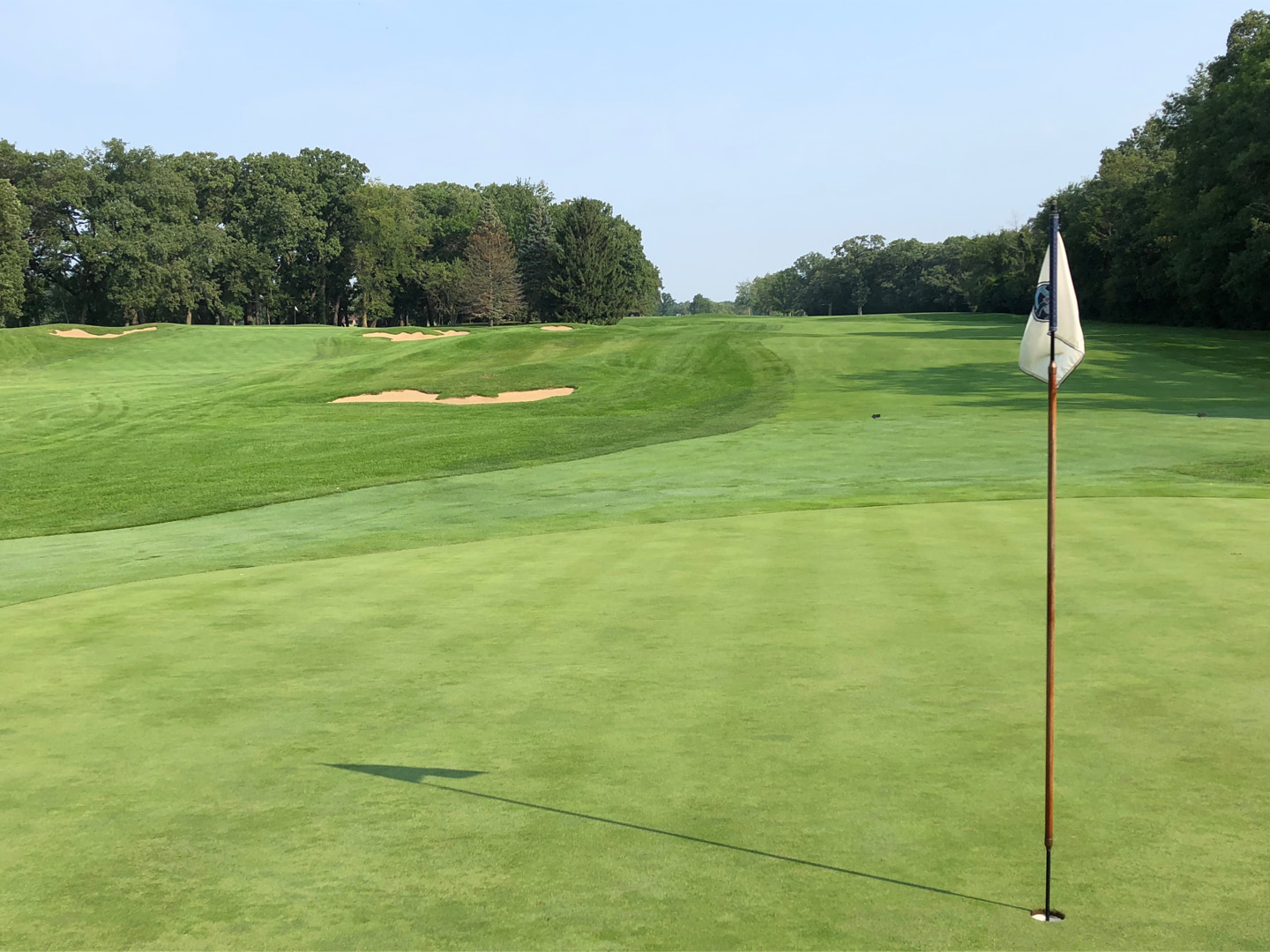
Looking back up the fairway with the 11th at left
HOLE #11 – 187 yards – par 3
The 11th is a beautiful but befuddling uphill par-3. The tee shot is semi-blind and plays about a club longer than usual because of the big hill. The real challenge is the green which slopes hard from front-to-back, making it difficult to get a mid-iron shot to stop. Any miss short will leave a delicate downhill chip shot, making a miss long preferred.
-
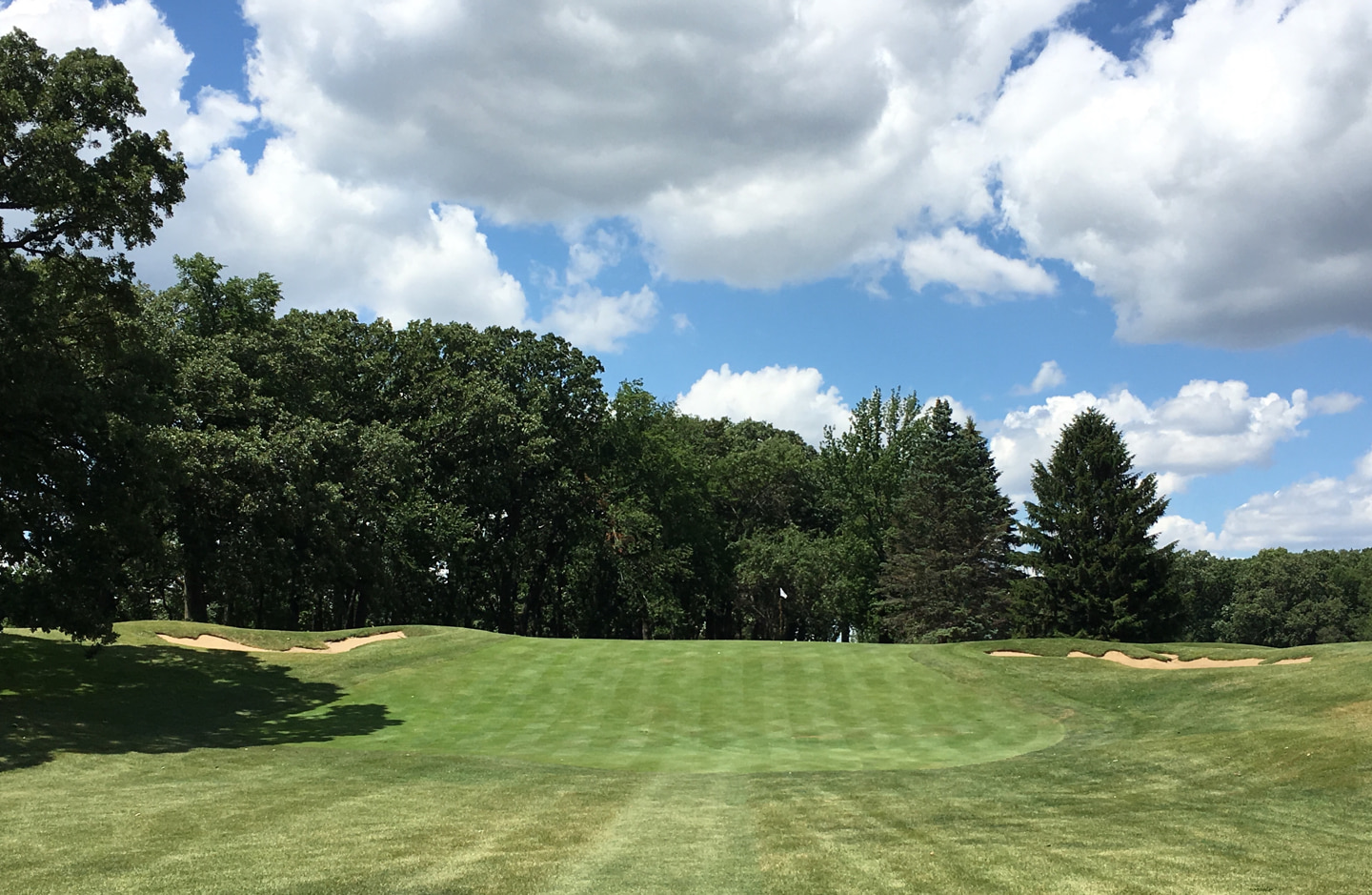
The uphill tee shot at the 11th
-
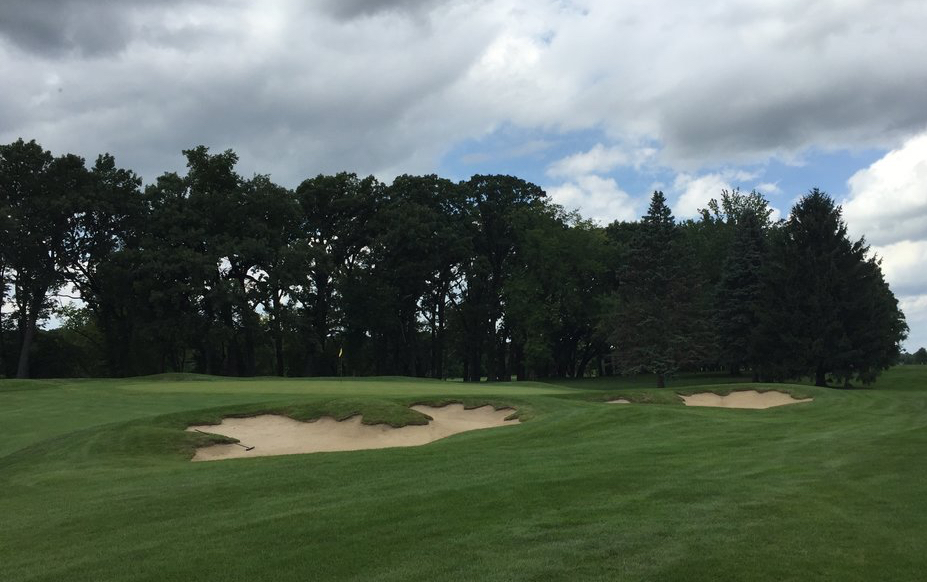
From right of the 11th green
-
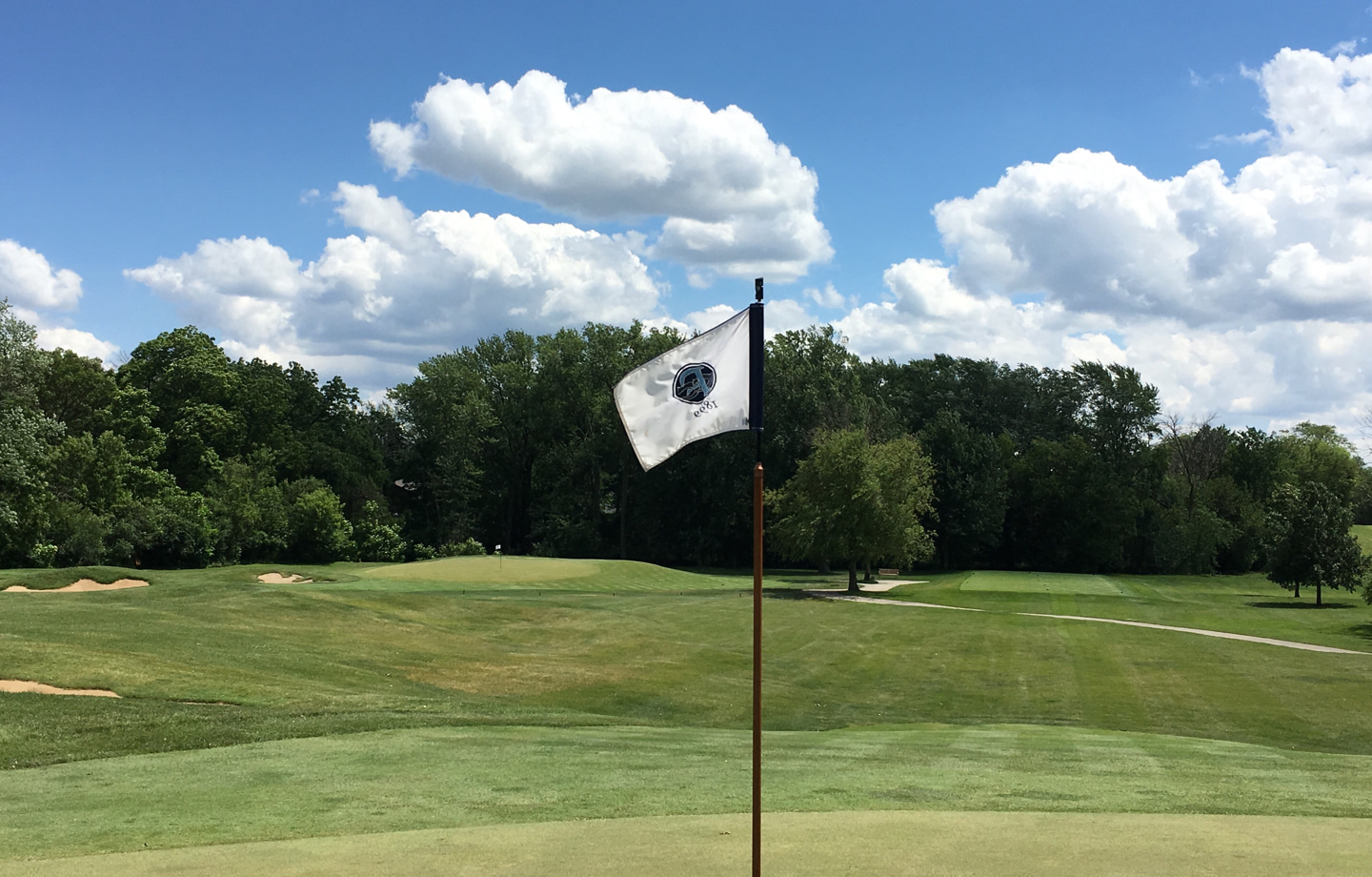
Looking back from the green downhill to the 10th
HOLE #12 – 417 yards – par 4
The 12th hole is one of our favorite par-4s in Chicago, and is a rendition of C.B. Macdonald’s “Alps” template. The tee shot comes from the same plateau that the 11th green is situated on, and plays right into the bank of another hill. Only the longest hitters can carry the hill and get a clear look at the green for their second shots. Most players are left with a blind second shot to a punchbowl green that once again slopes away. The significant front to back slope makes distance control very difficult, especially from the rough.
-
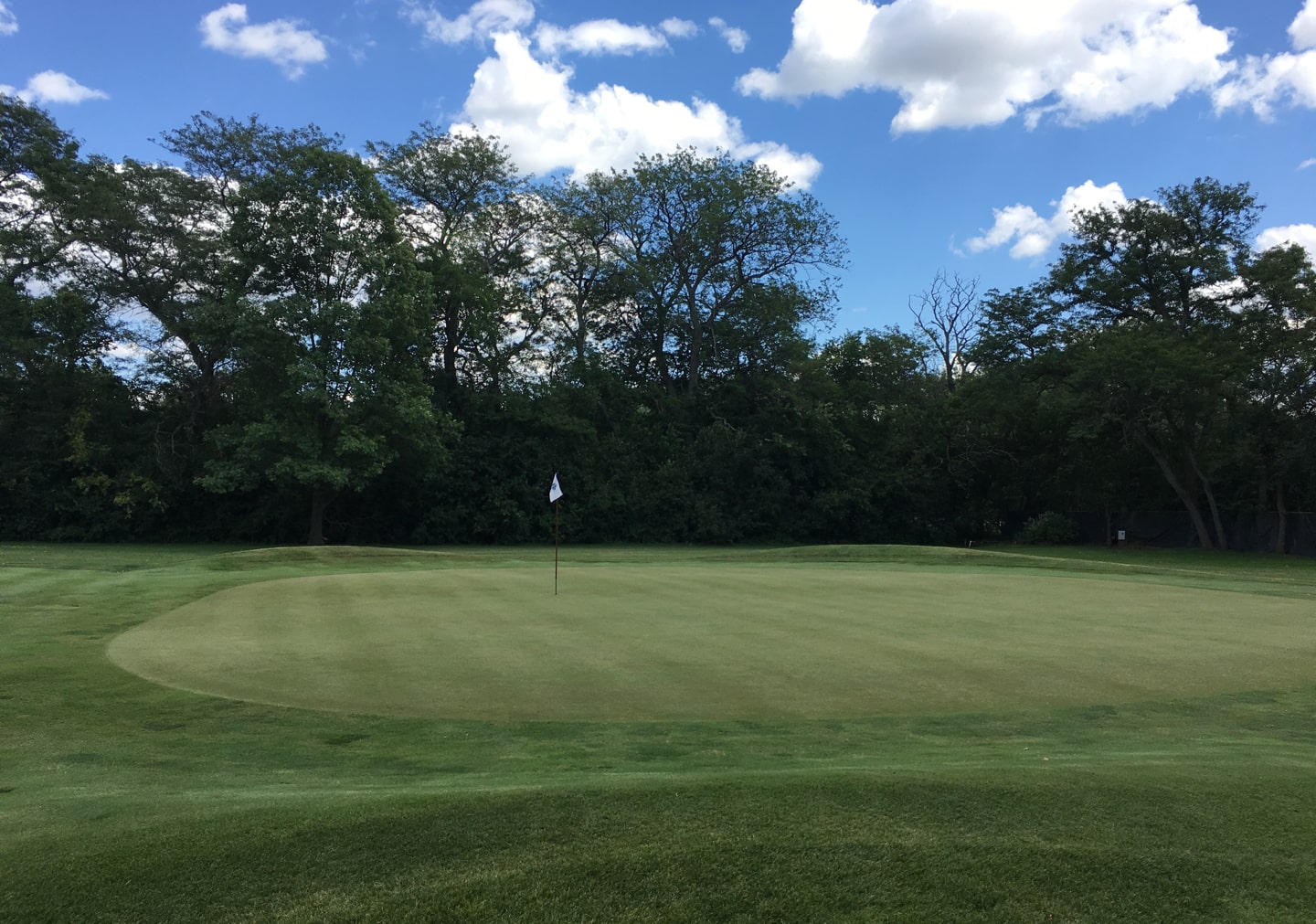
The old school punchbowl green at the 12th
-
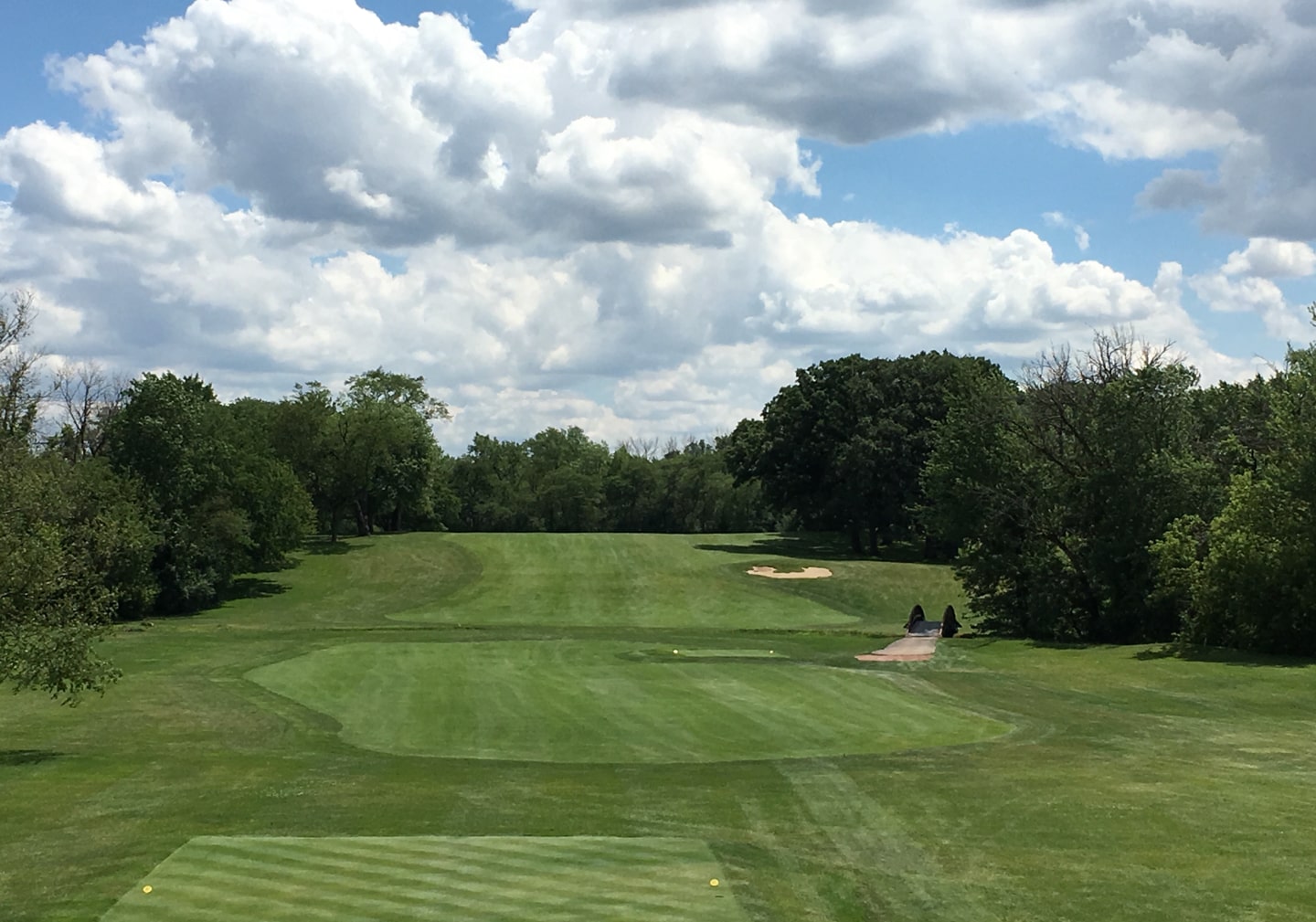
The thrilling tee shot from peak to peak
-
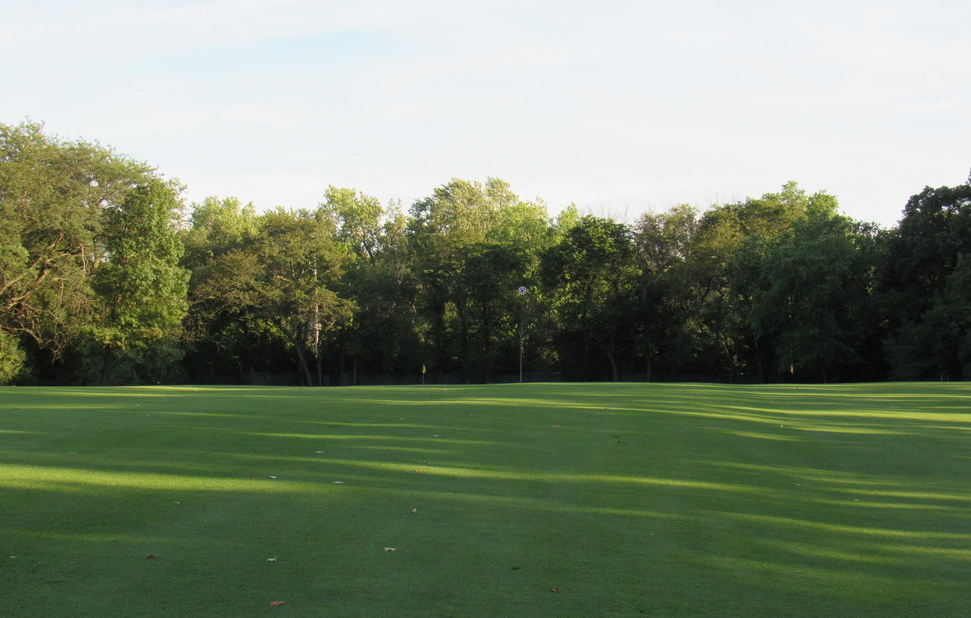
A blind approach awaits
-
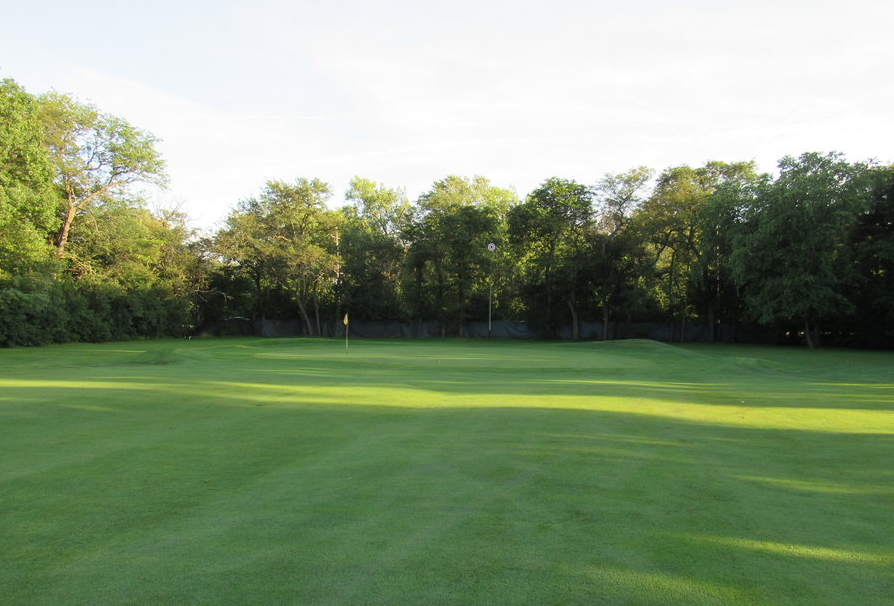
The fairway runs down into the punchbowl and away
-
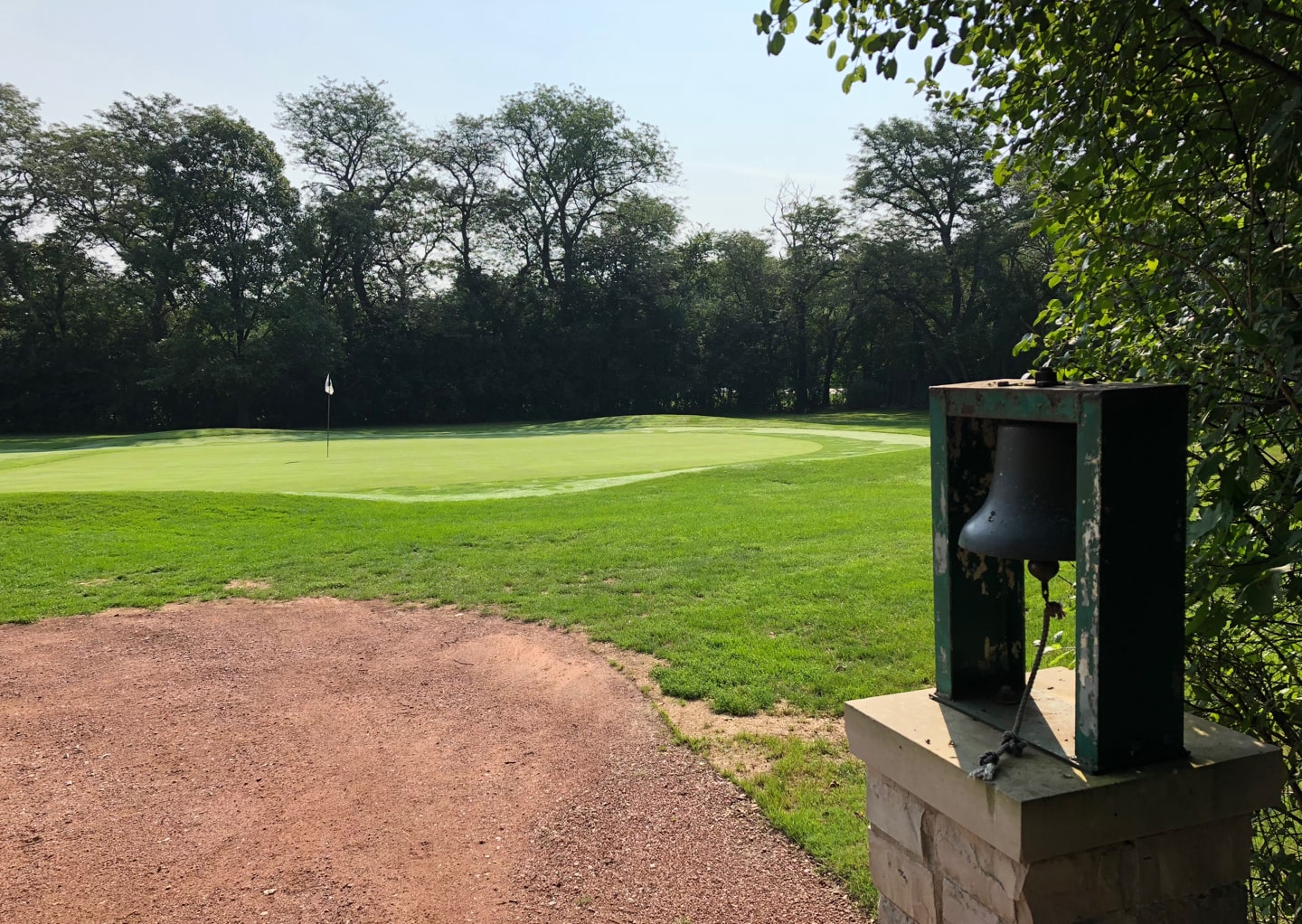
Ring the bell to let the next group know all's clear
HOLE #13 – 135 yards – par 3
Another hole significantly altered by Hearn who moved both the tee box and green to have the hole play in a different direction. While short, the 13th isn’t a gimme par, as the green has significant slope making distance-control a must.
-
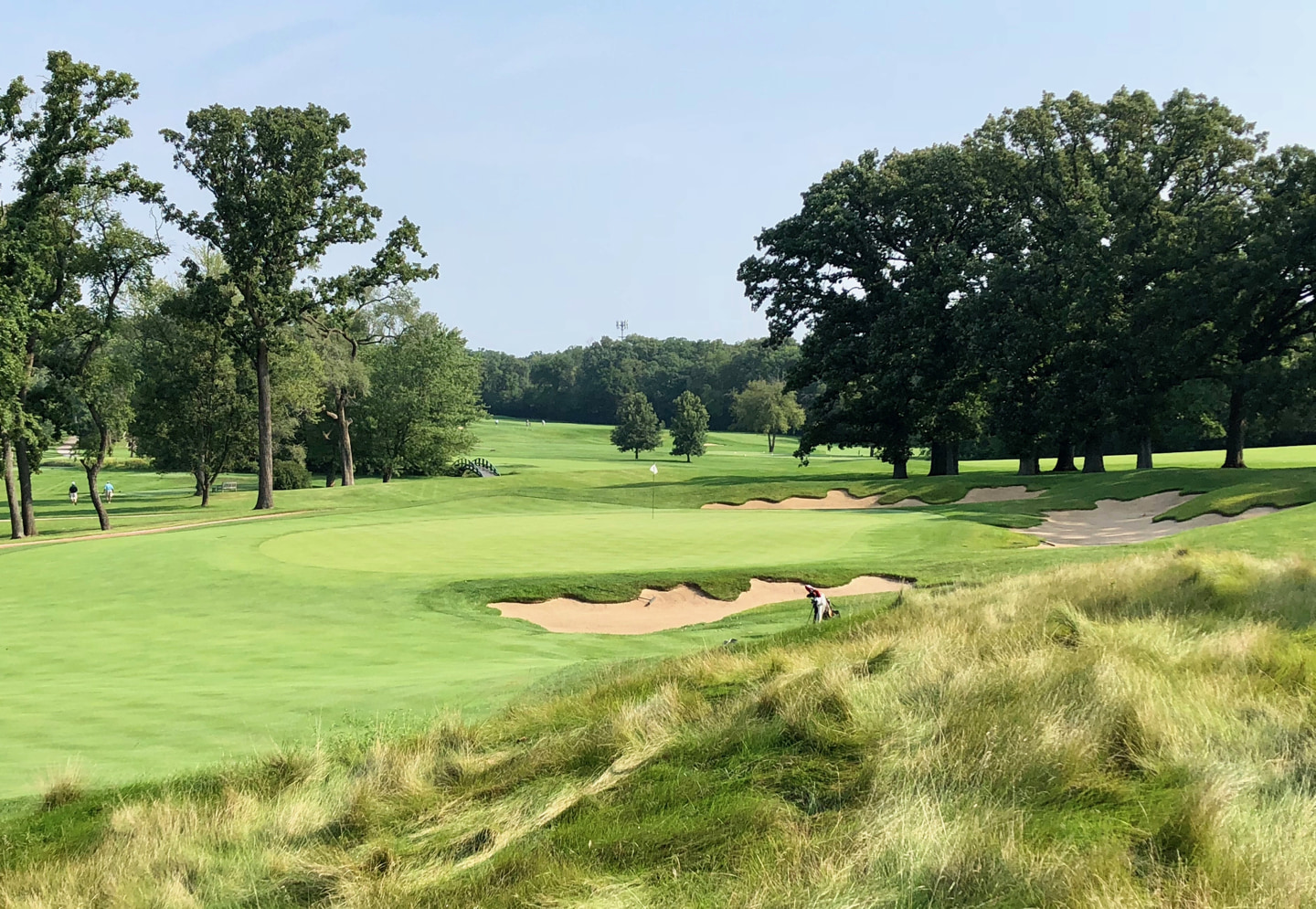
A fescue covered hill runs along the right
-
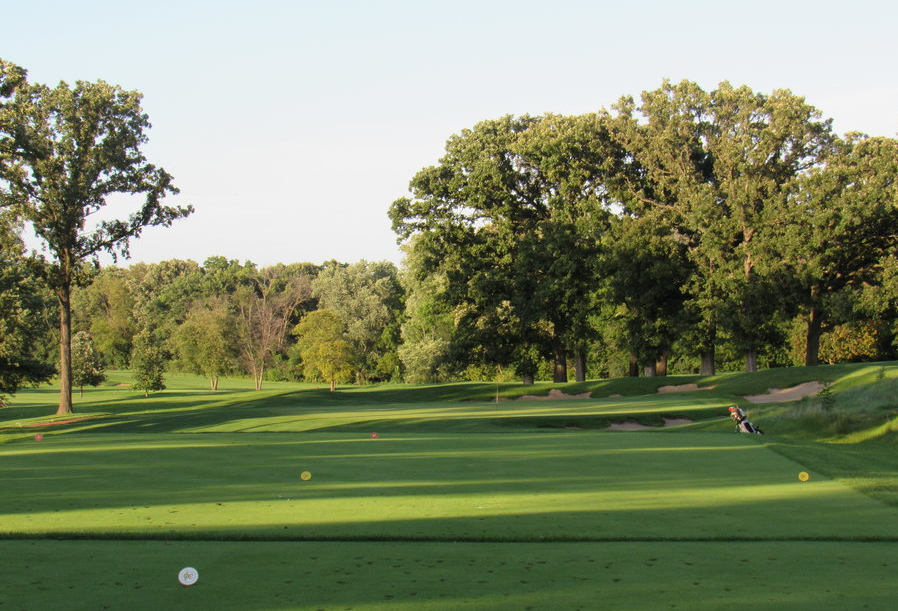
The tee shot to partially obscured green
-
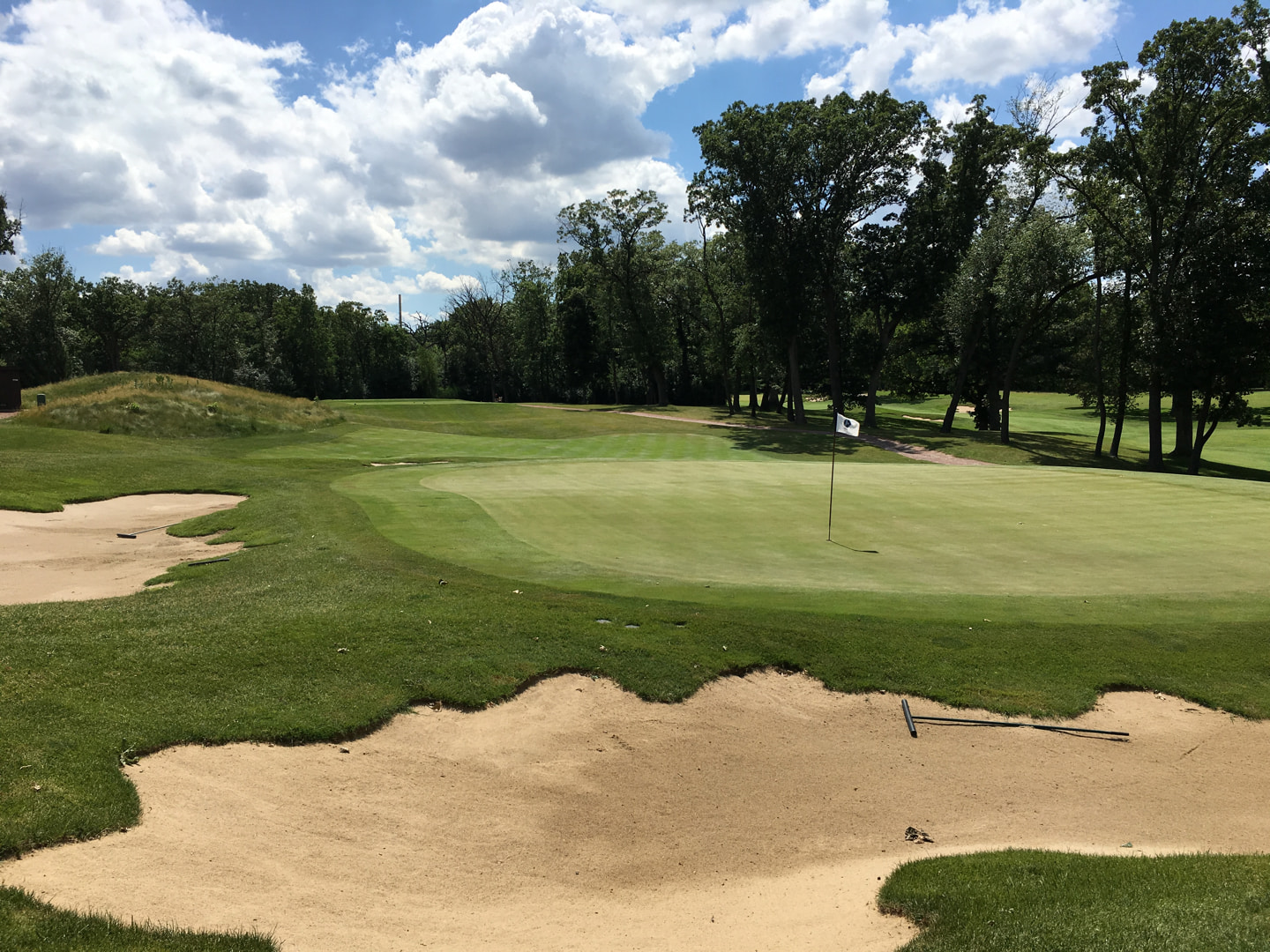
Putting is challenging on the 13th
HOLE #14 – 366 yards – par 4
The tee on this short par-4 is made both awkward and memorable by a large oak tree in the middle of the fairway. While the tree is only 175 yards from the tee, it forces a player to decide whether to thread the needle on the right or left side, or hit it over. A subtle challenge to the 14th is the considerable fairway undulation that yields uneven lies. The green is also very difficult; it slopes hard from back-to-front, and a wedge shot with too much juice can spin right off the front.
-
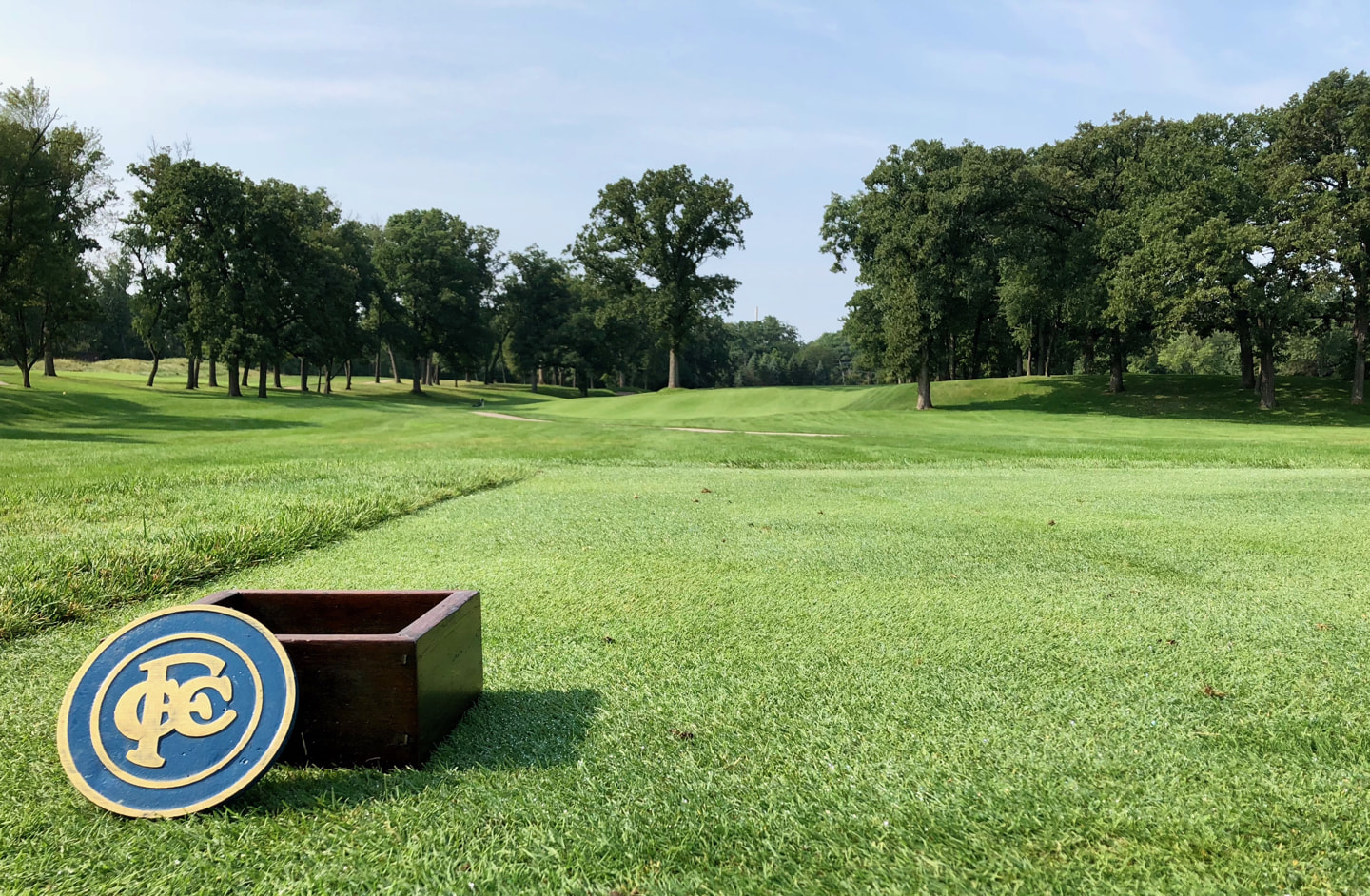
Stepping to the tee, confronted with a tree
-
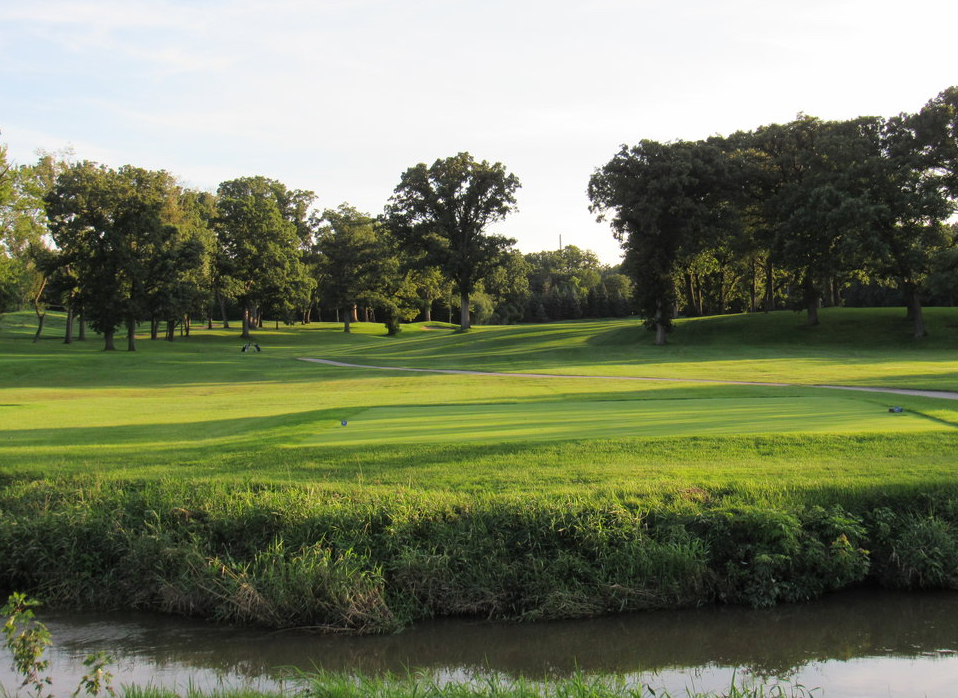
Players must commit fully to a line on the 14th
-
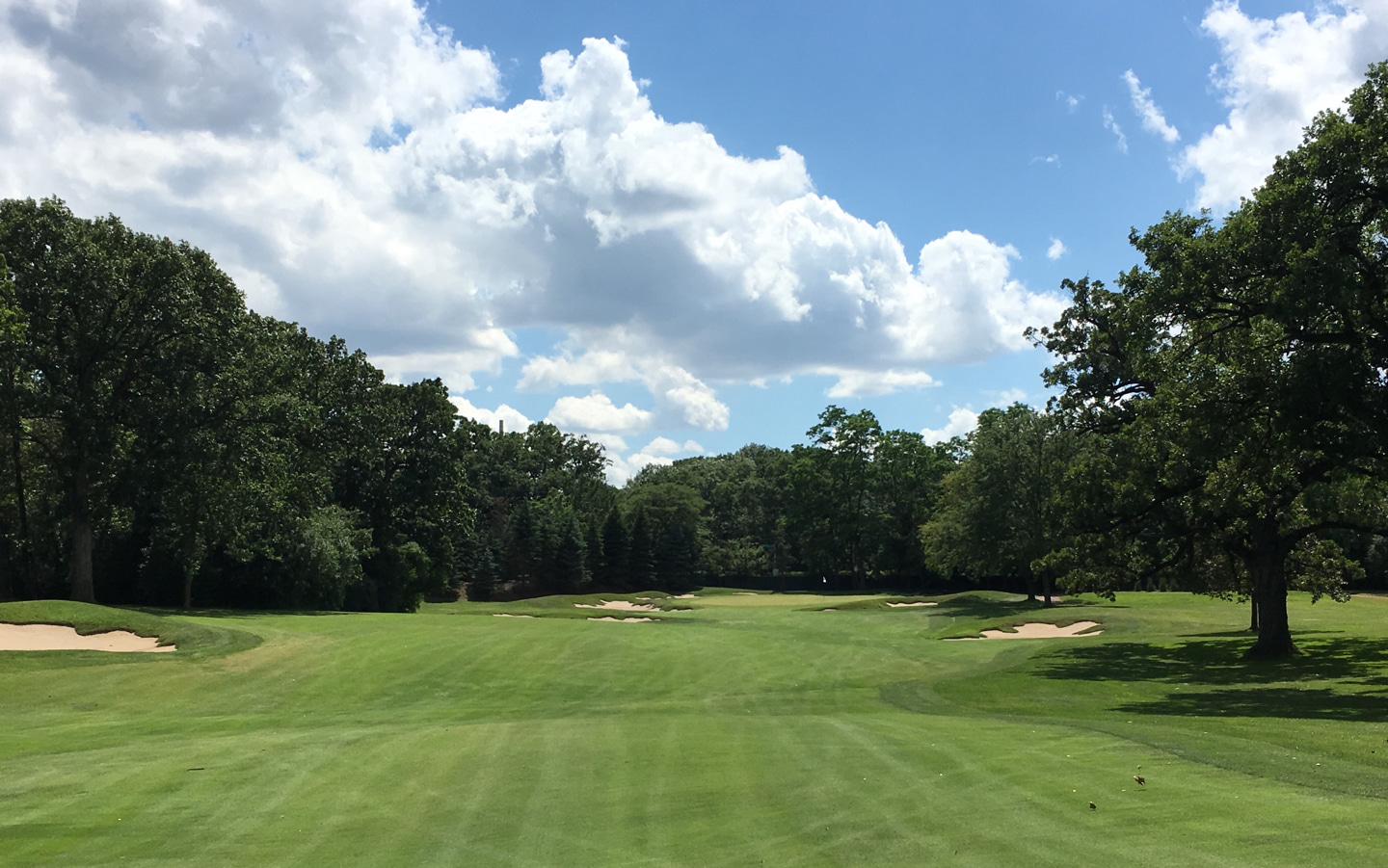
Finding the fairway leaves a scorable approach
-
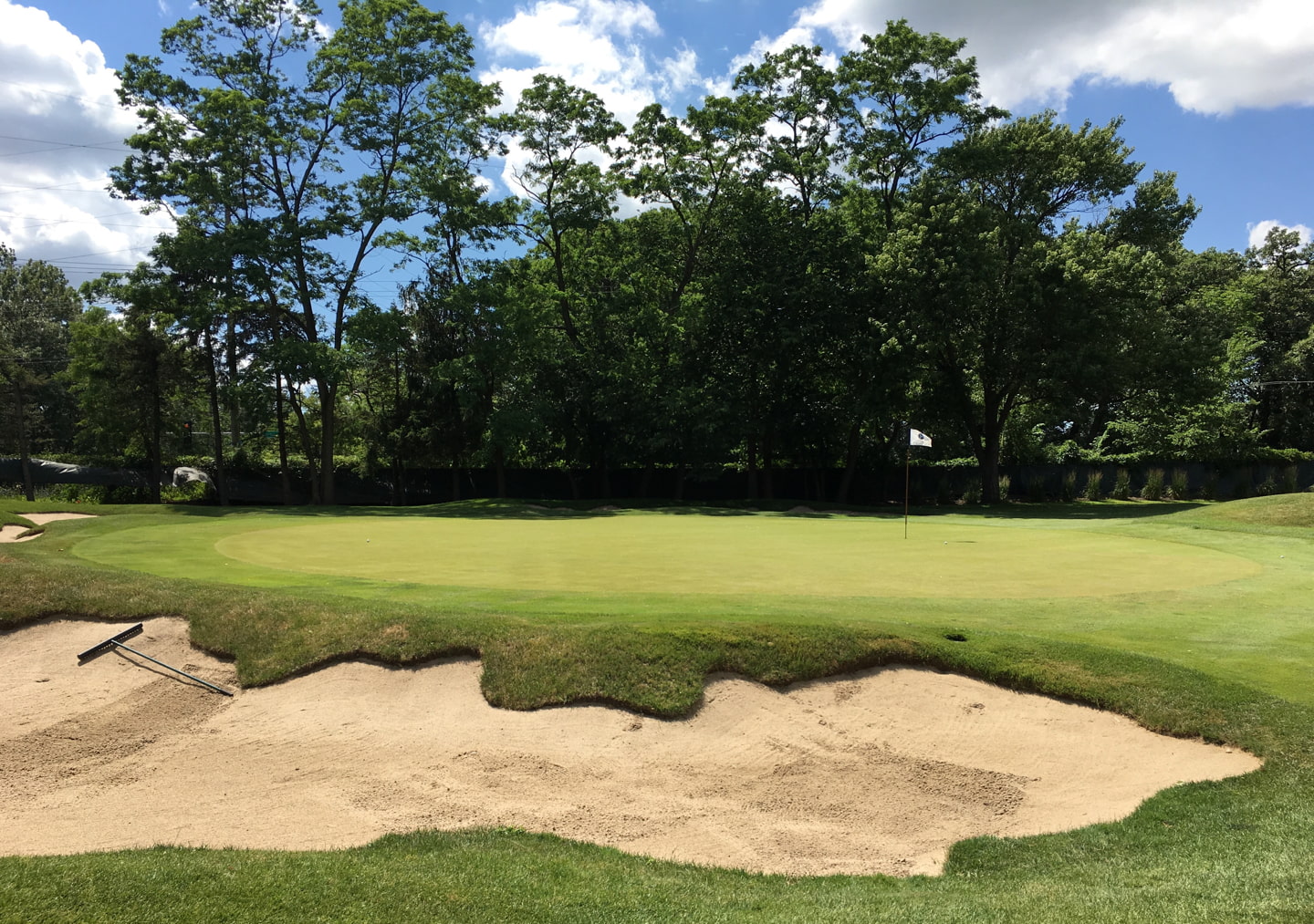
The 14th green has its subtle challenges
-
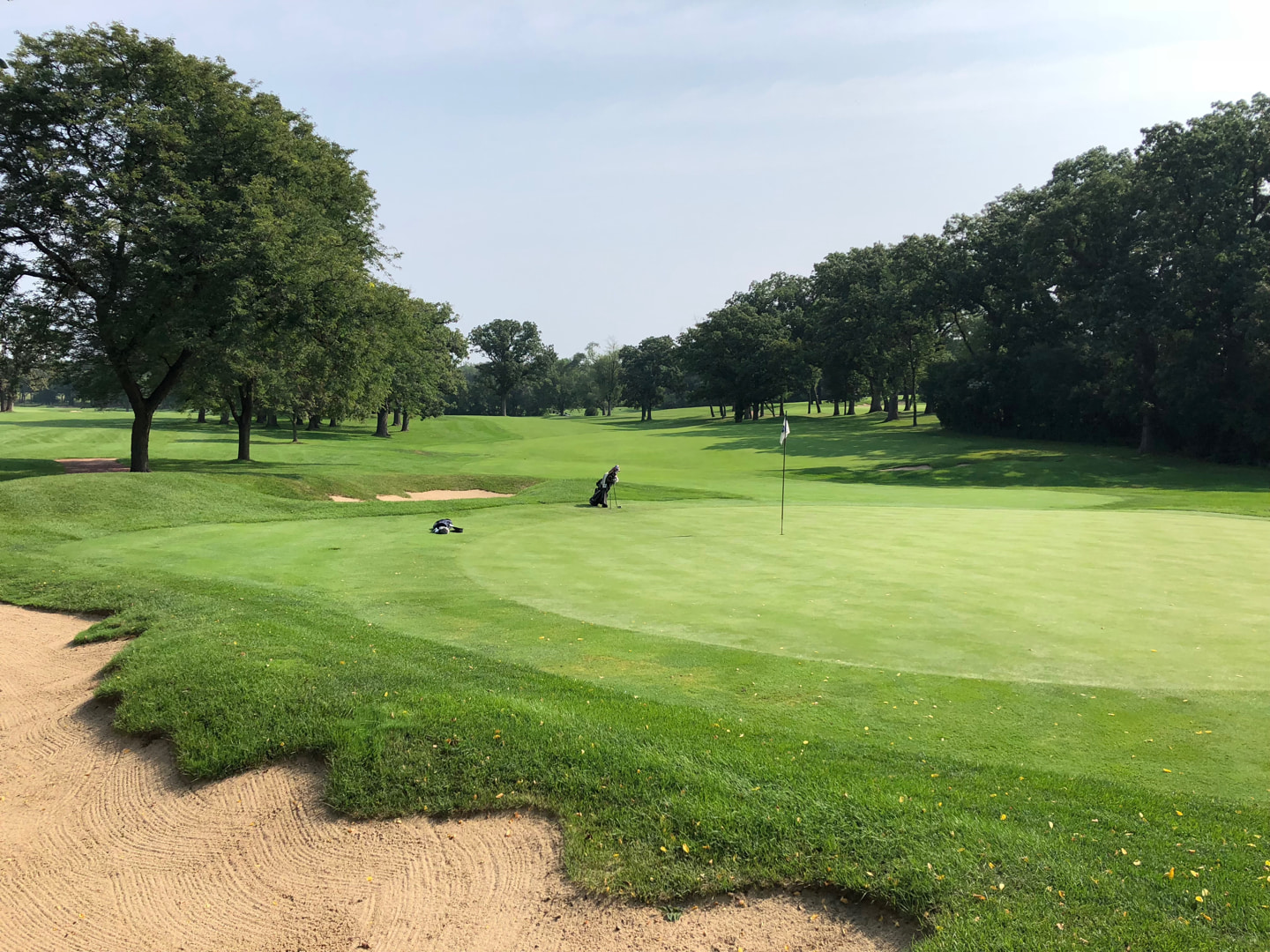
A unique and fun golf hole
HOLE #15 – 431 yards – par 4
The course begins a dramatic close one of its best tee shots at the 15th. The ideal tee ball moves right-to-left but avoids the large oak tree on the left side. A long drive will leave a short-iron approach over a creek which bisects the fairway to a small, well-guarded green. When it’s windy, this approach is particularly difficult as the green seemingly shrinks to a miniscule size. As is the case with many of Flossmoor’s putting surfaces, being in the right spot on the 15th green is key as it slopes from back-to-front, and long putts are very difficult.
-
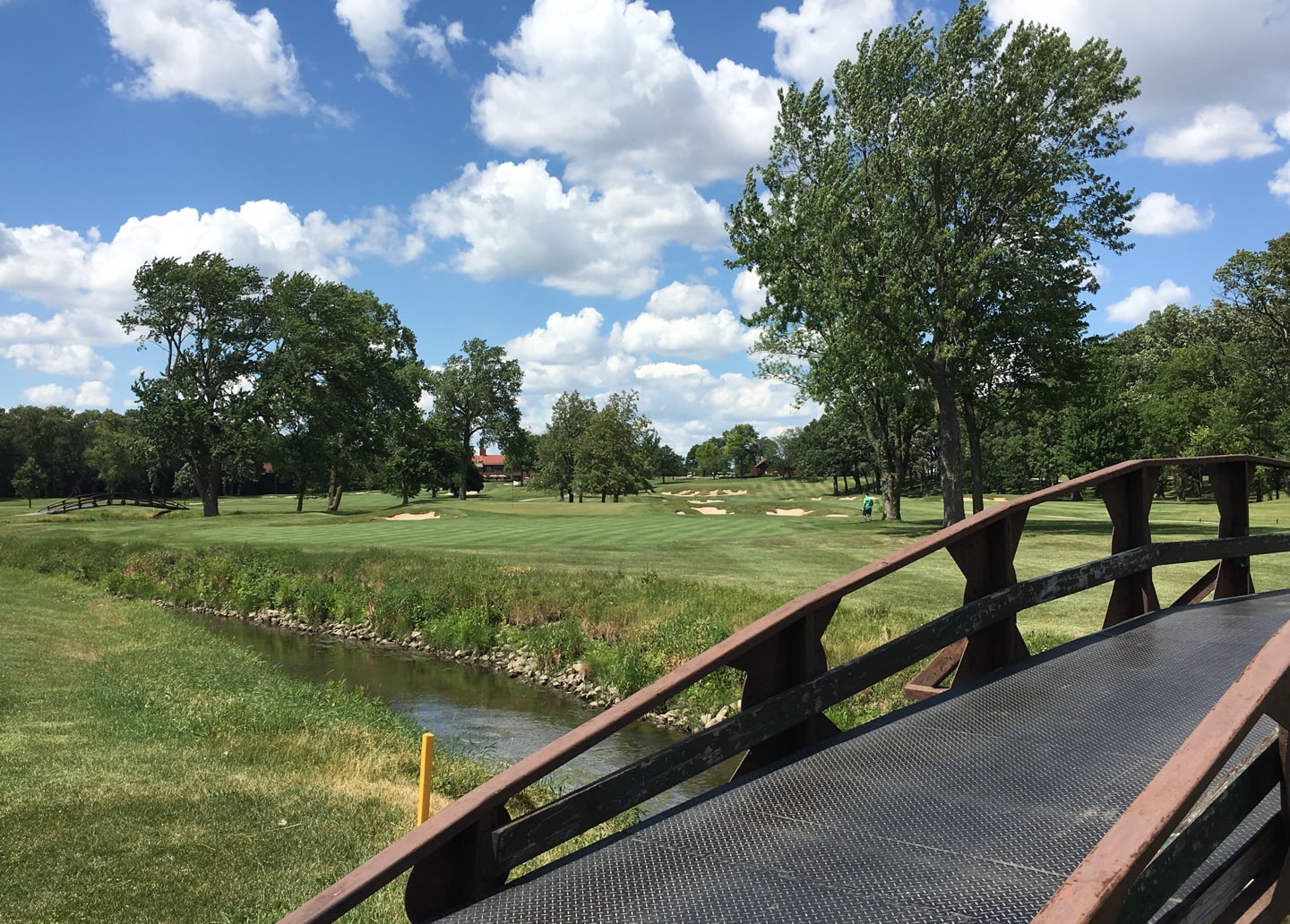
The approach on the 15th plays over the creek
-
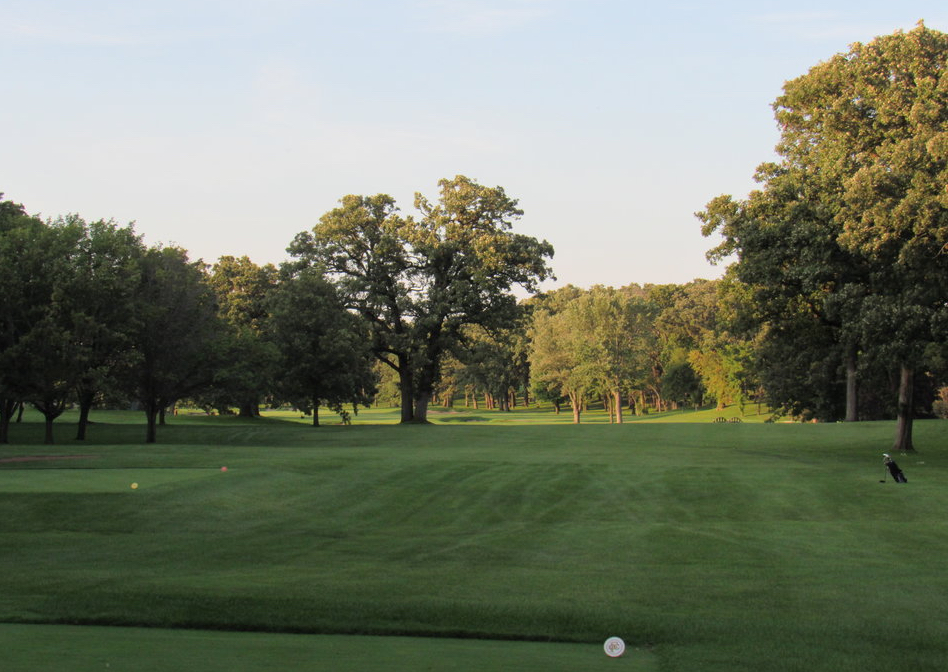
Another demanding tee shot
-
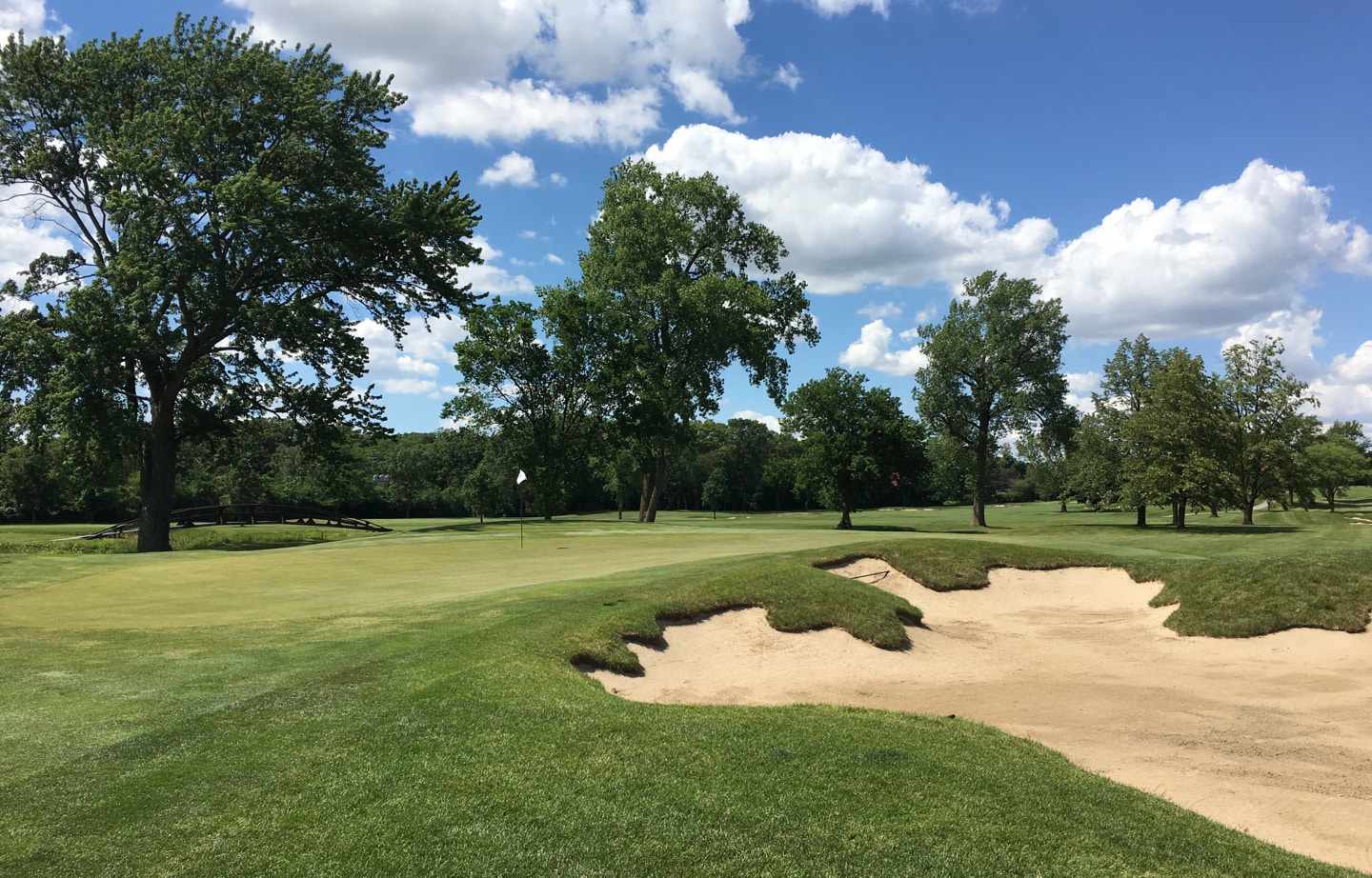
Bunkering guards the tiny green
-
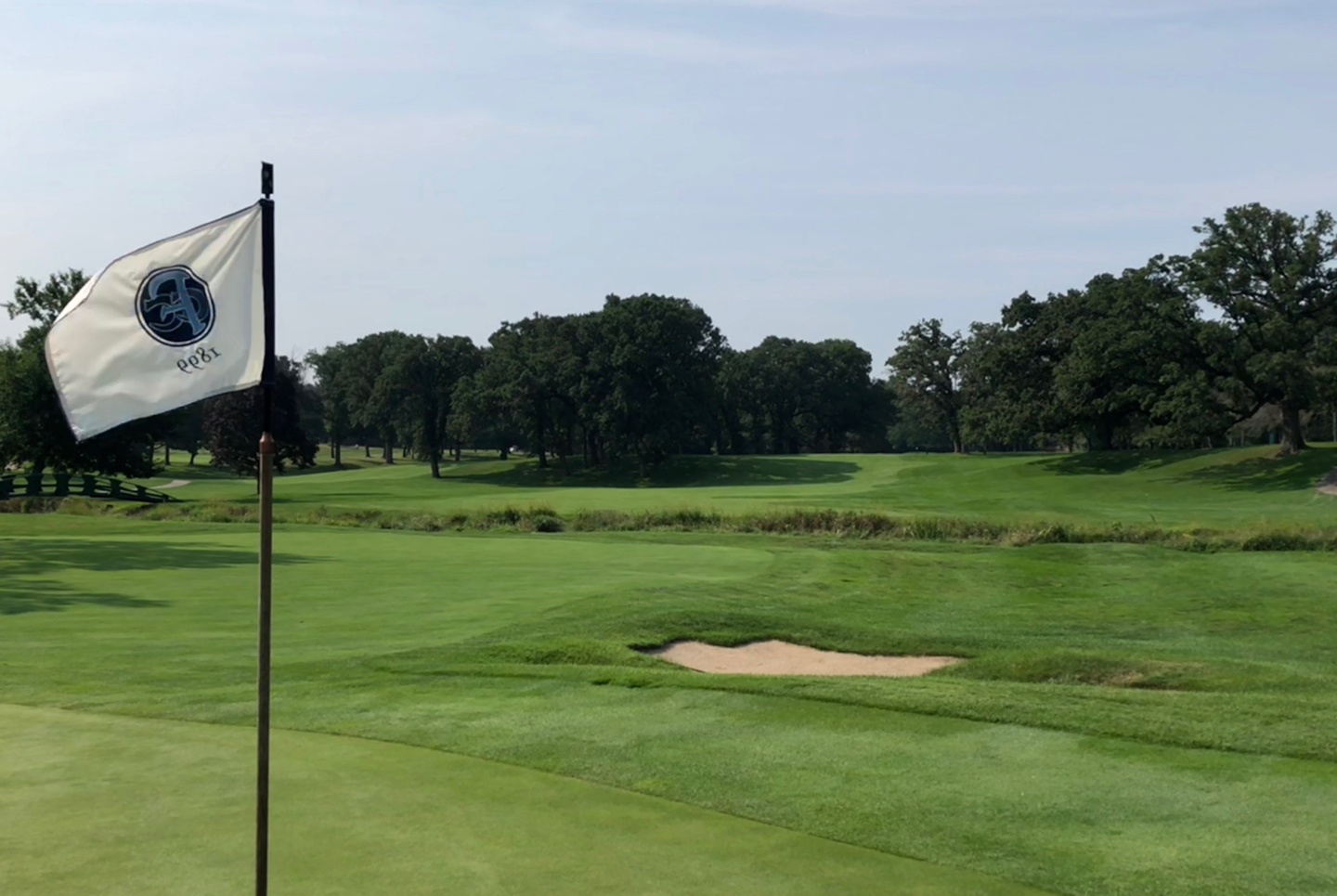
A look back up the beautifully tumbling fairway
HOLE #16 – 425 yards – par 4
While extremely wide off the tee, the 16th’s second shot presents quite the challenge. The double fairway it shares with the 17th gives players plenty of room to the left and no reason to go anywhere near the fairway bunker on the right side. A tee shot into good position sets up an uphill approach to the plateau green guarded by a memorable fingered bunker. The green is very shallow and has a false front that rejects any shots slightly short or that have too much spin. A miss long is dead as the green slopes hard from the back-to-front.
-
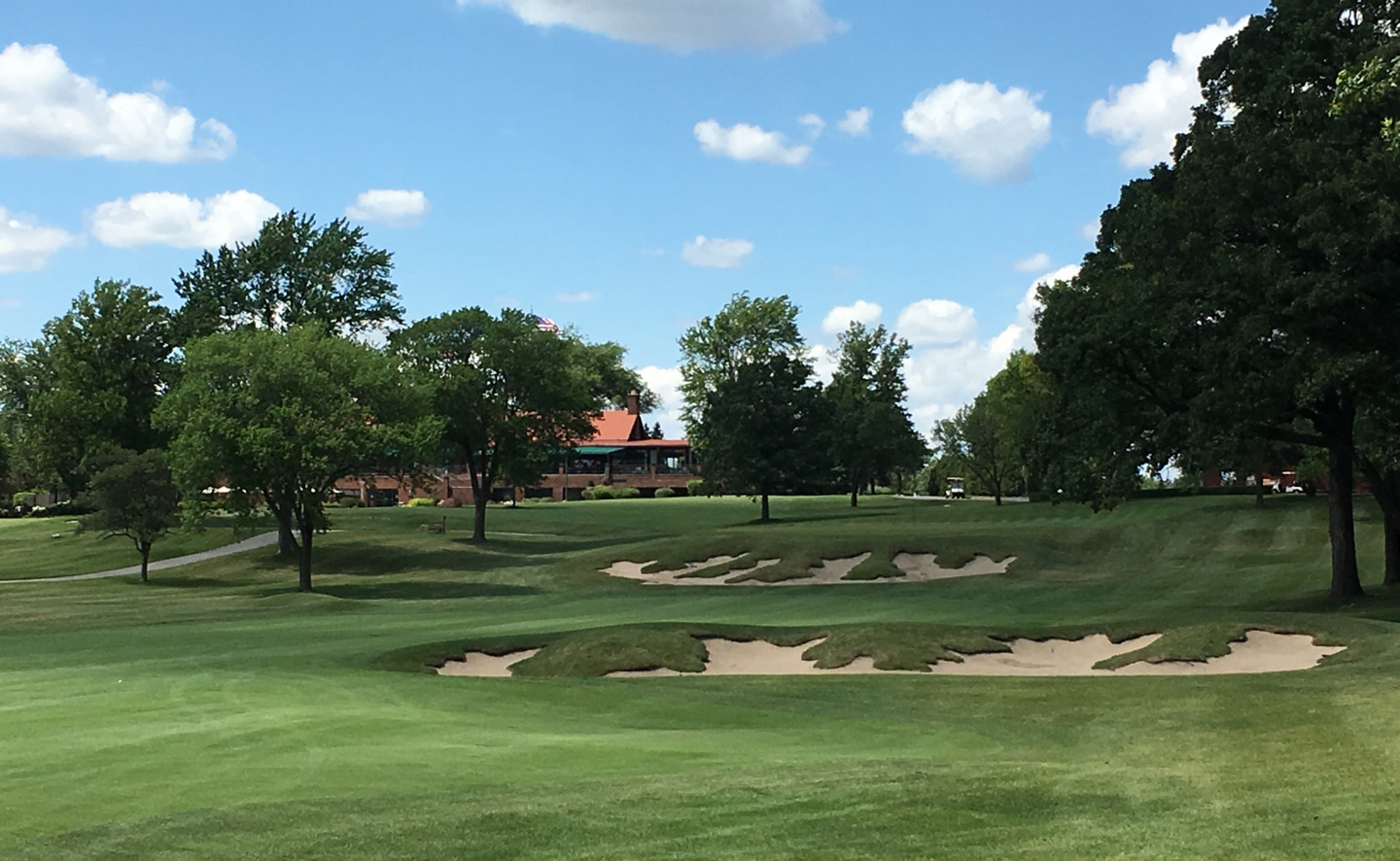
Bunkers on Flossmoor's 16th challenge the tee shot and approach
-
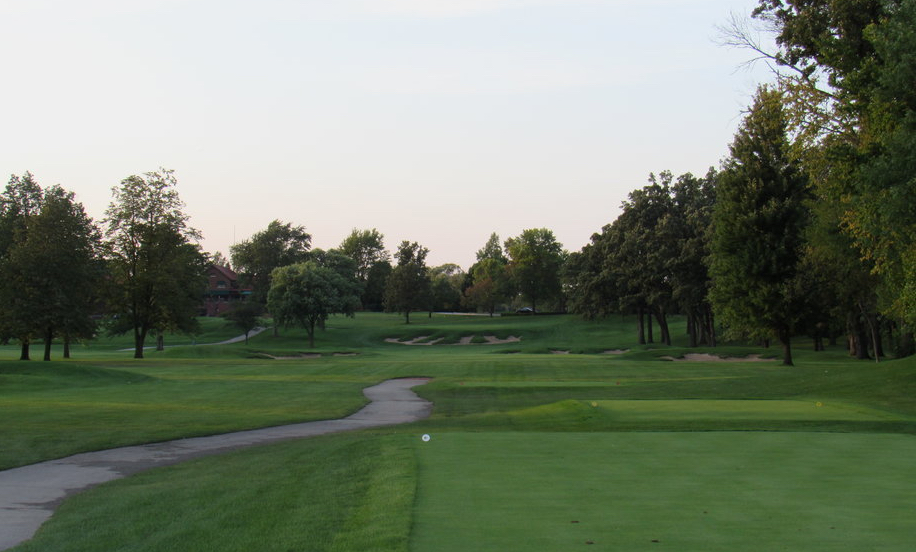
Plenty of room off this tee
-
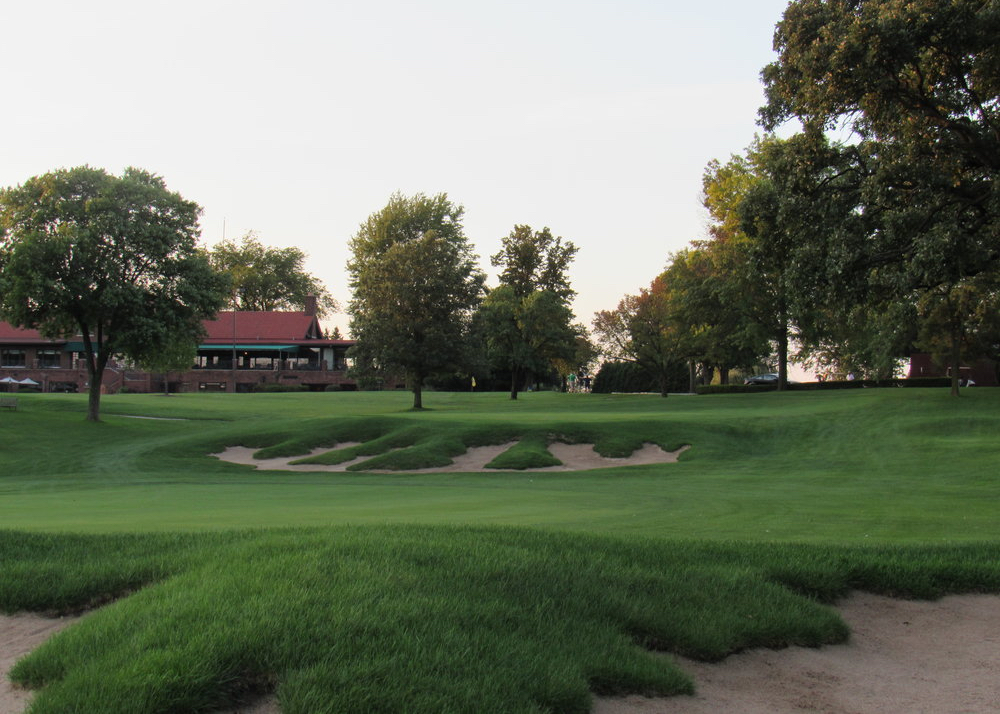
The fronting bunker spells JAIL for a reason
-
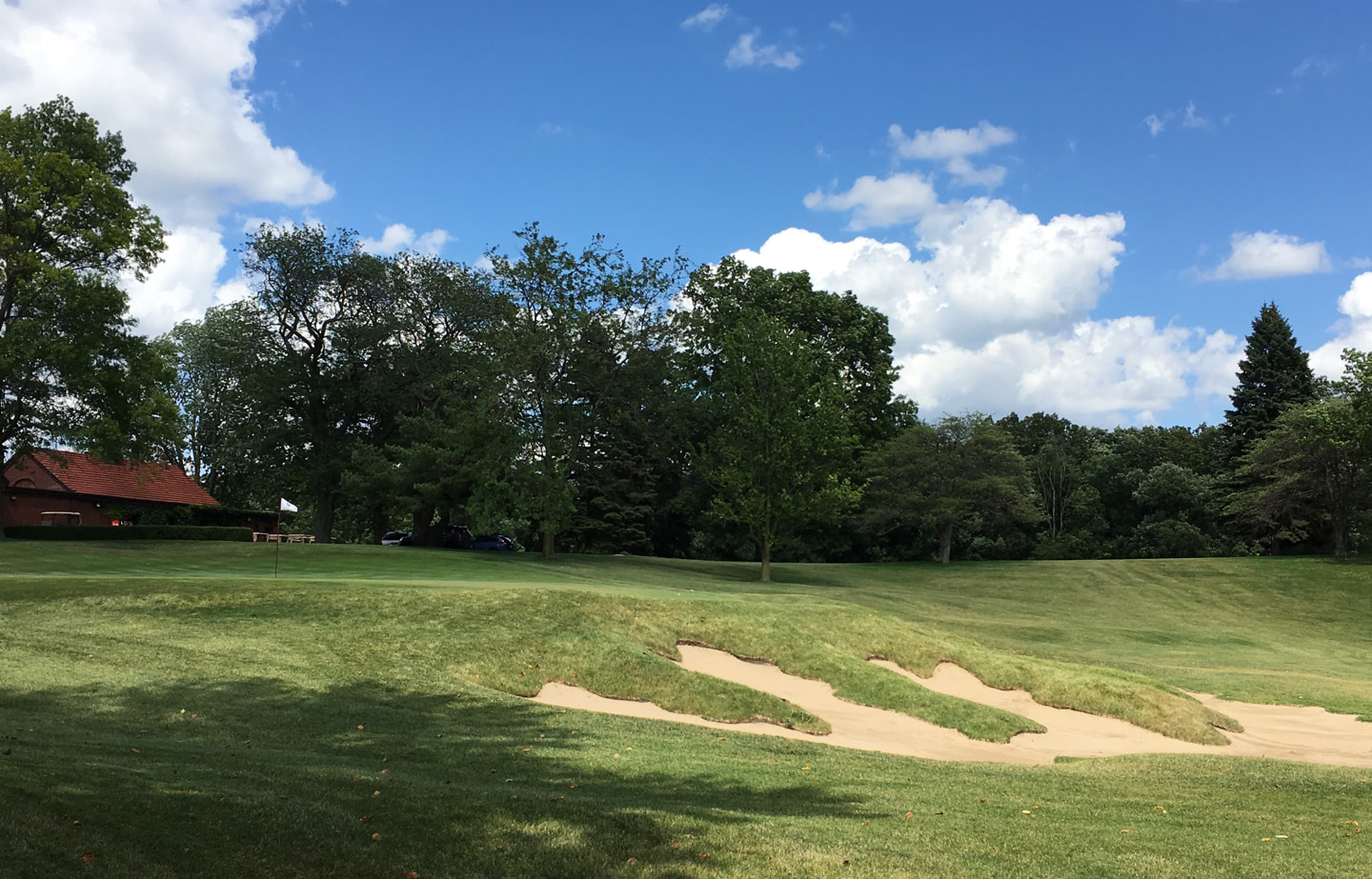
A look at the elevated green from the left
-
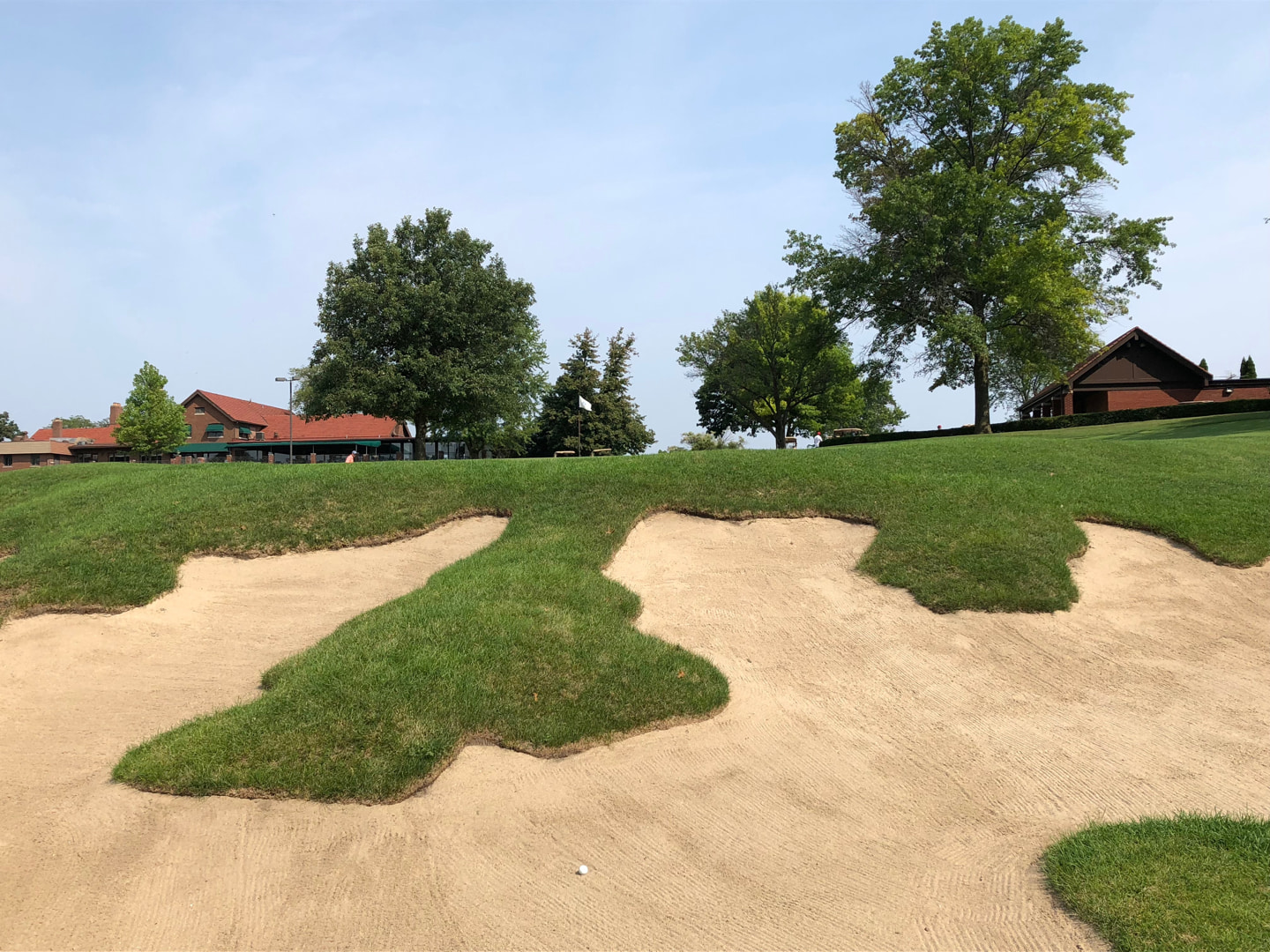
Not the place to be on the 16th
-
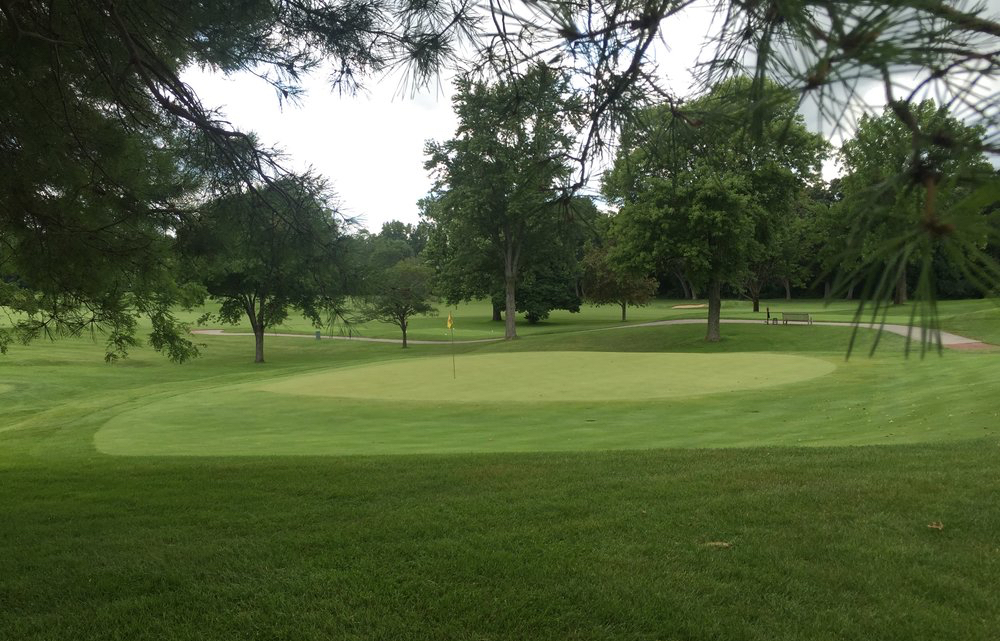
The green is lightning from back to front
HOLE #17 – 473 yards – par 4
One of the toughest par-4s in Chicago, or any other town. The uphill approach makes finding the fairway from the tee a must. A creek bisects the fairway at 290 yards, taking driver out of some players’ hands. The approach shot, about a club longer than the yardage suggests, is played to a green perched on a ridgeline. The green slopes from the right-to-left, and it isn’t very receptive. It forces most players to scramble for par. Much like the 8th hole, the 17th is a birdie four/bogey six two-shotter.
-
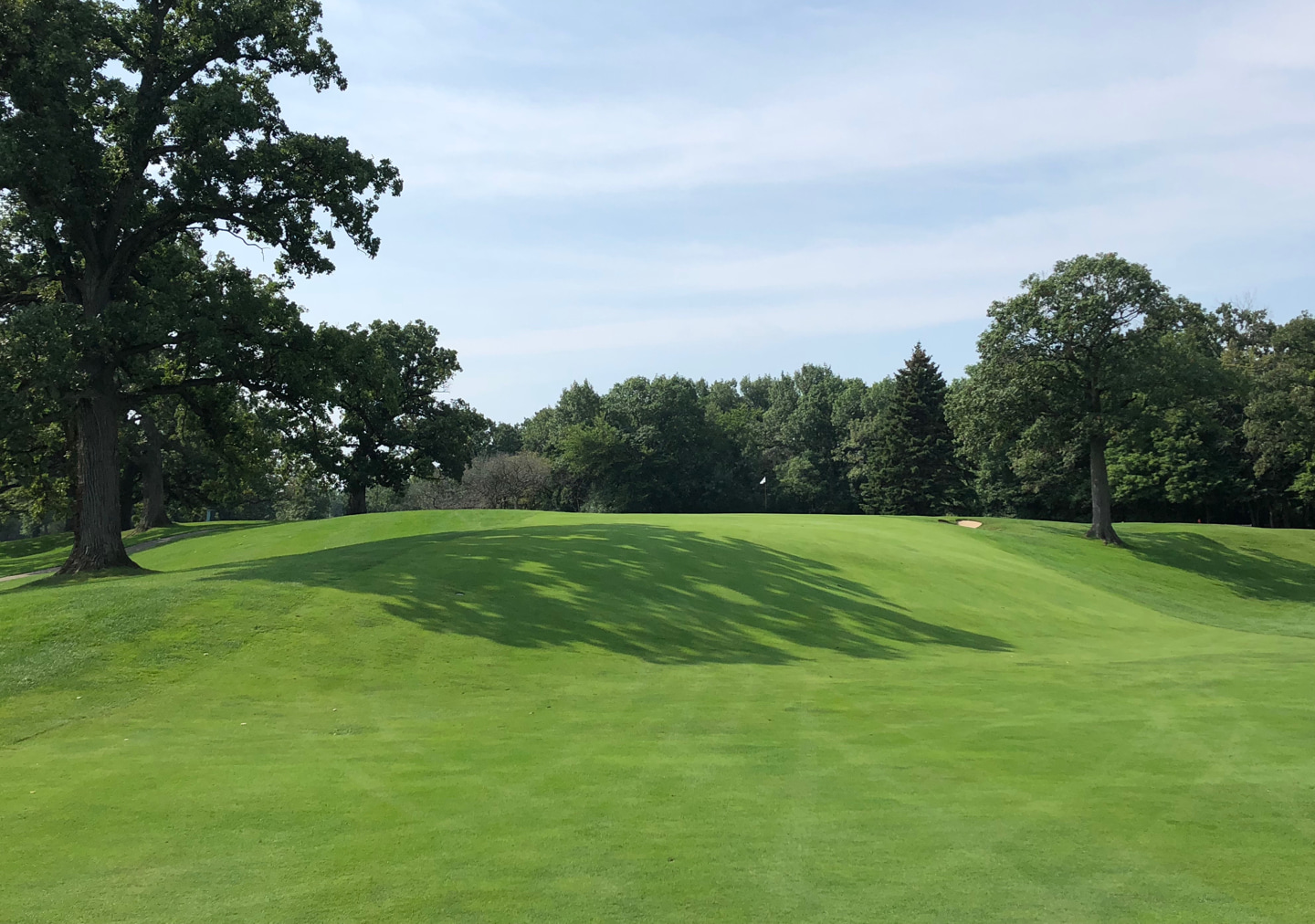
The 17th green sits perched atop a ridgeline
-
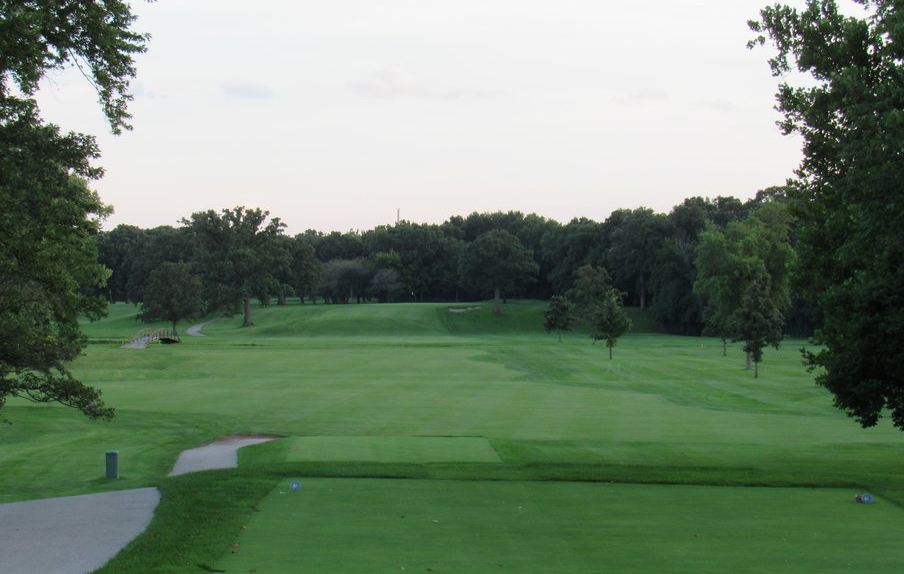
An accurate drive is a must
-
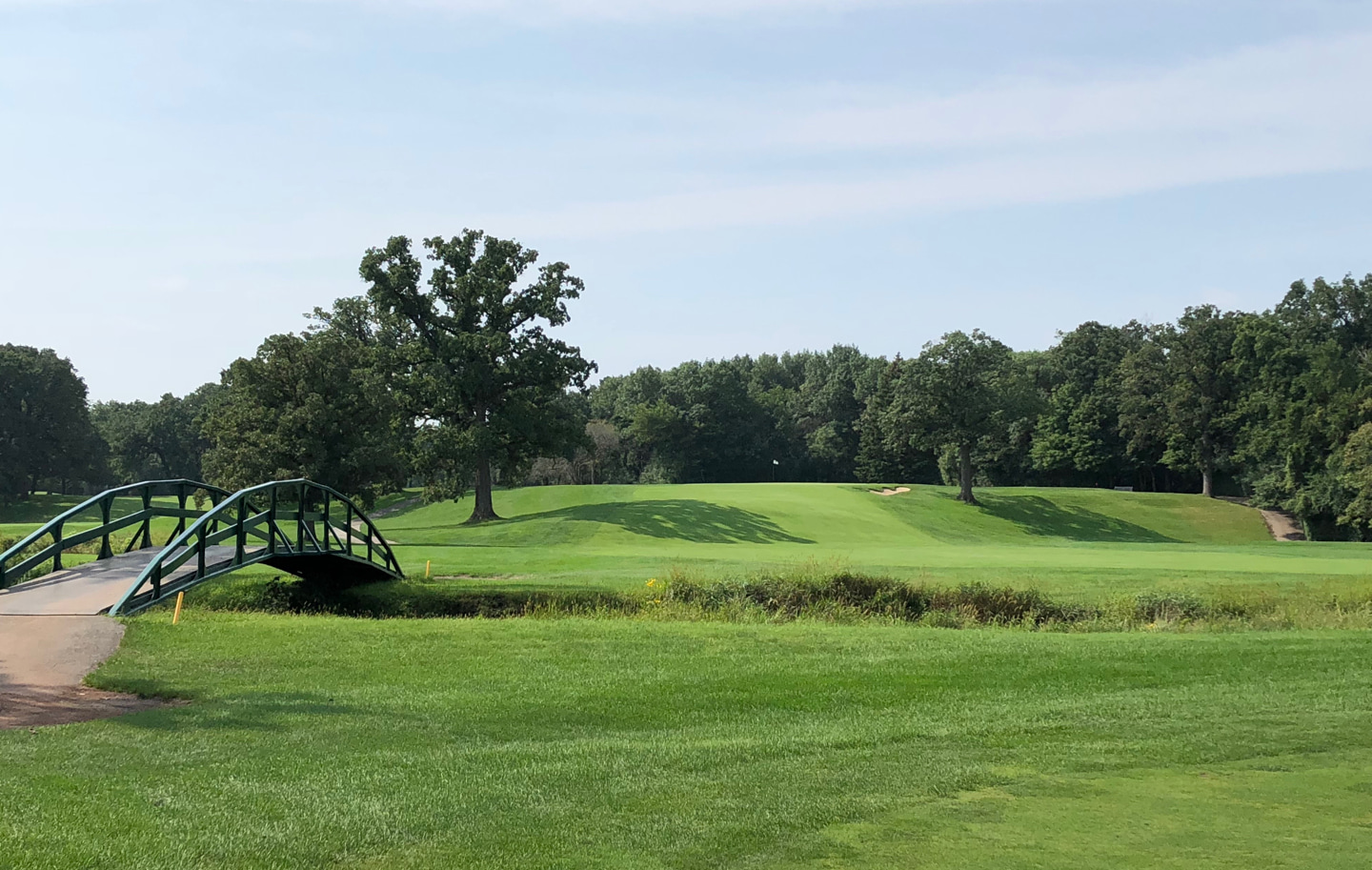
Holding this green from the rough is next to impossible
-
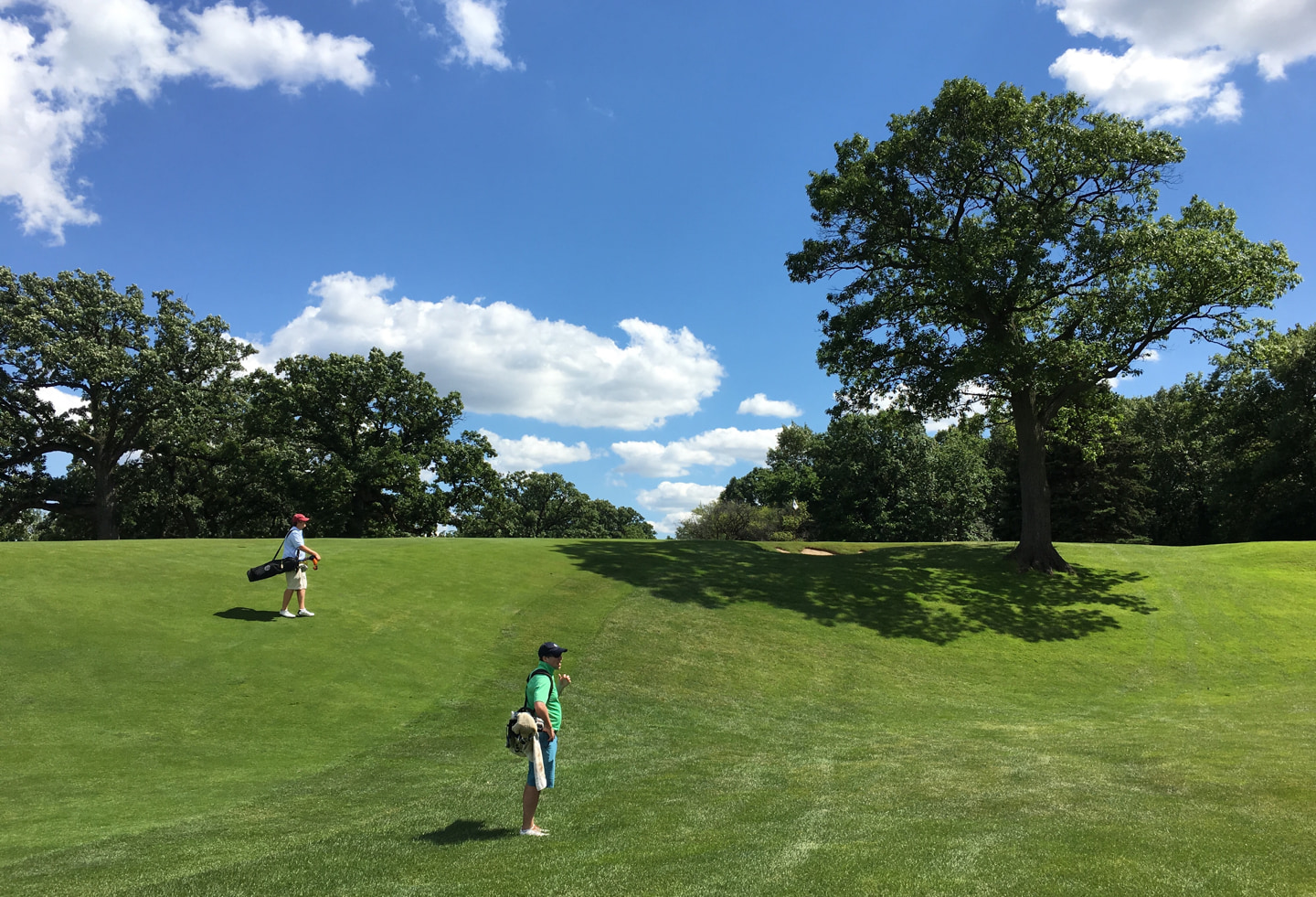
Yes, the hill is that high
-
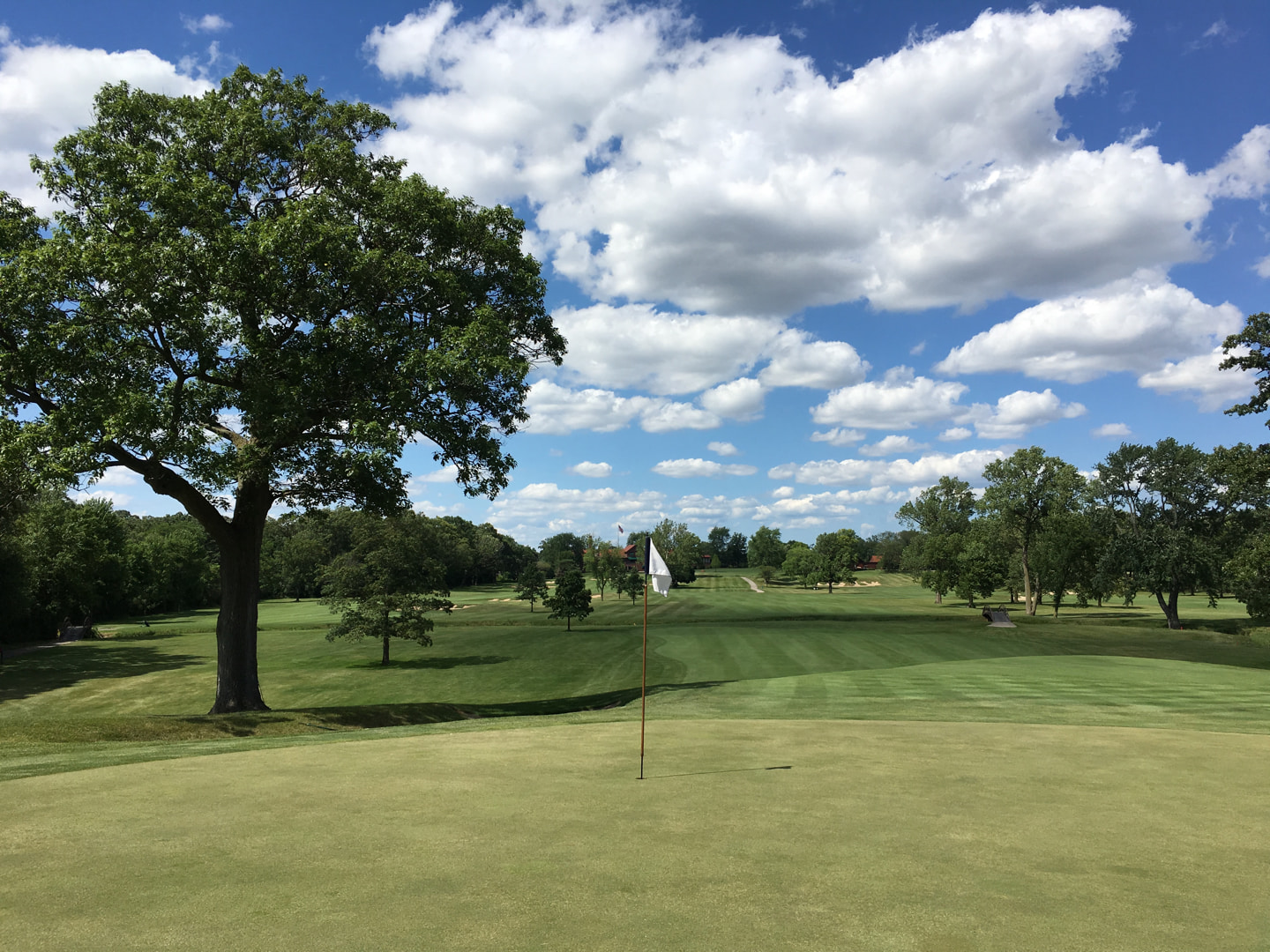
From the 17th green back toward the clubhouse
HOLE #18 – 533 yards – par 5
A round at Flossmoor comes to a close with a gettable par-5 that runs back uphill to the massive clubhouse. A long hitter’s line is over the fairway bunkers on the right side, leaving a fairway wood or long-iron approach to the perched green. A poor drive will force a layup which isn’t easy because of fairway bunkers on the left and right. The approach is deceptive as it looks like the slope of the green will funnel shots from right to left, but that never seems to happen. The green is actually full of subtle breaks, leaving most players confounded walking off.
-
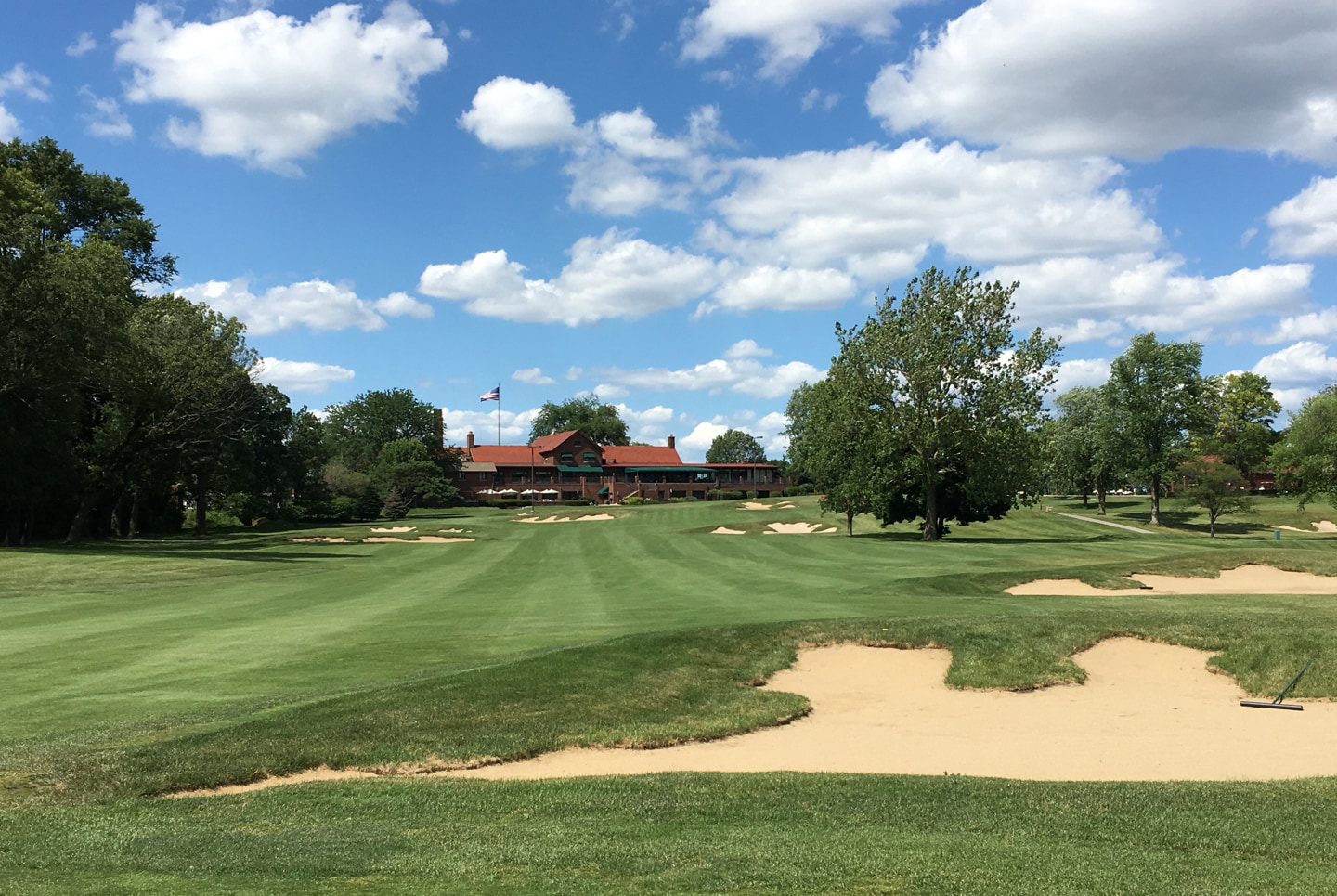
A final birdie chance on the home hole
-
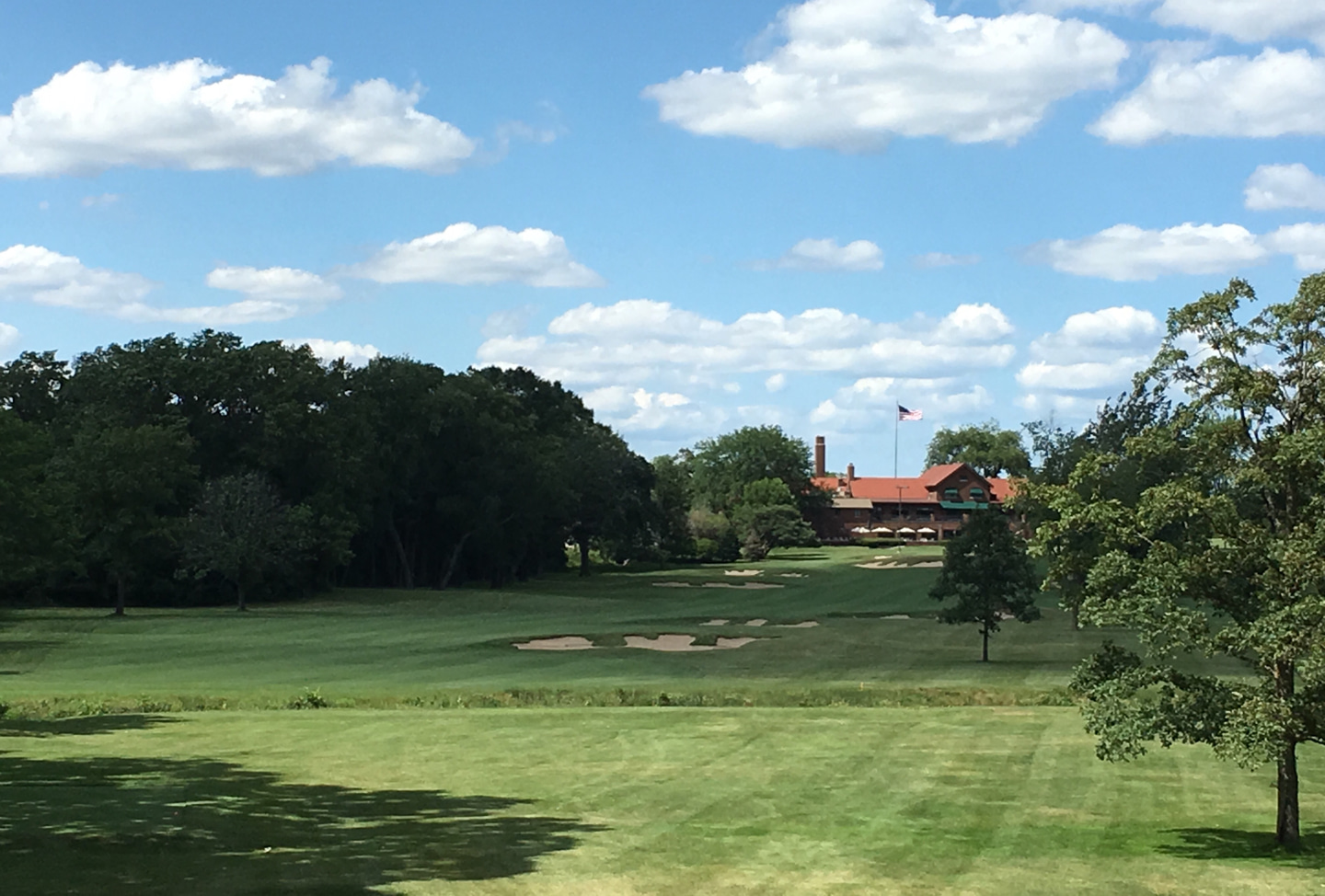
Longer players can cut the corner on the 18th
-
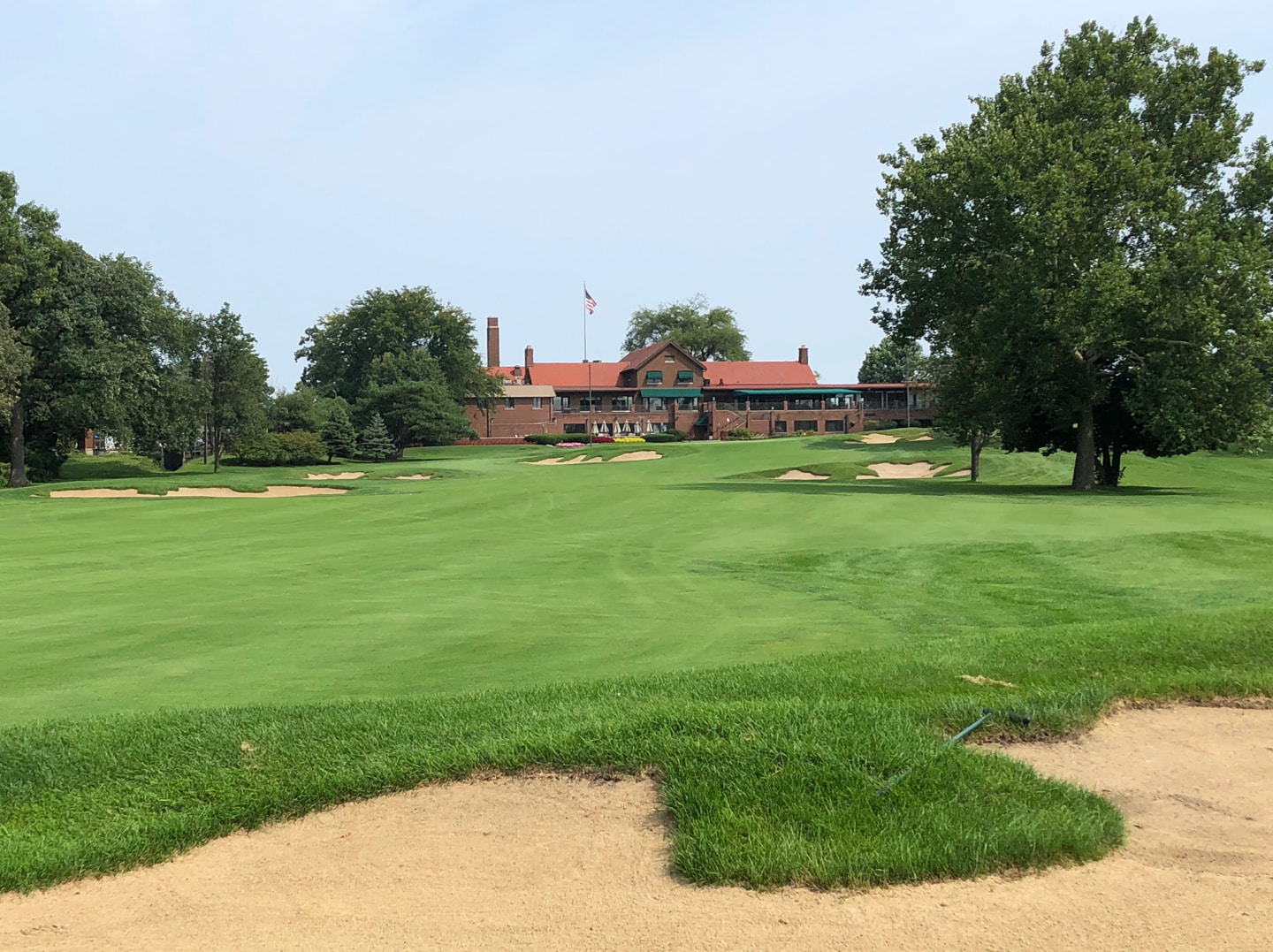
Finding the fairway bunkering forces a tough layup
-
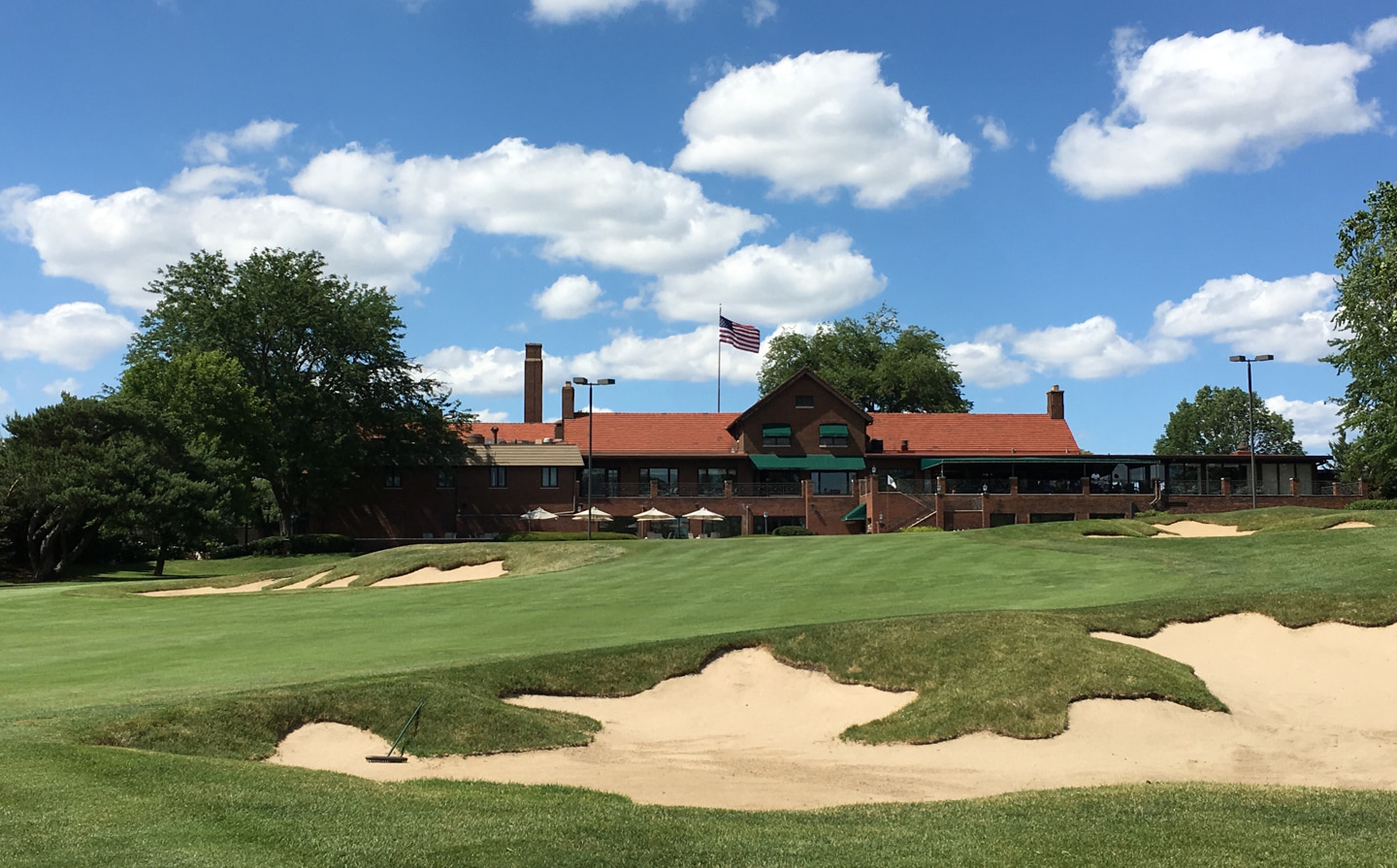
Approach the elevated 18th green in the shadow of the clubhouse
-
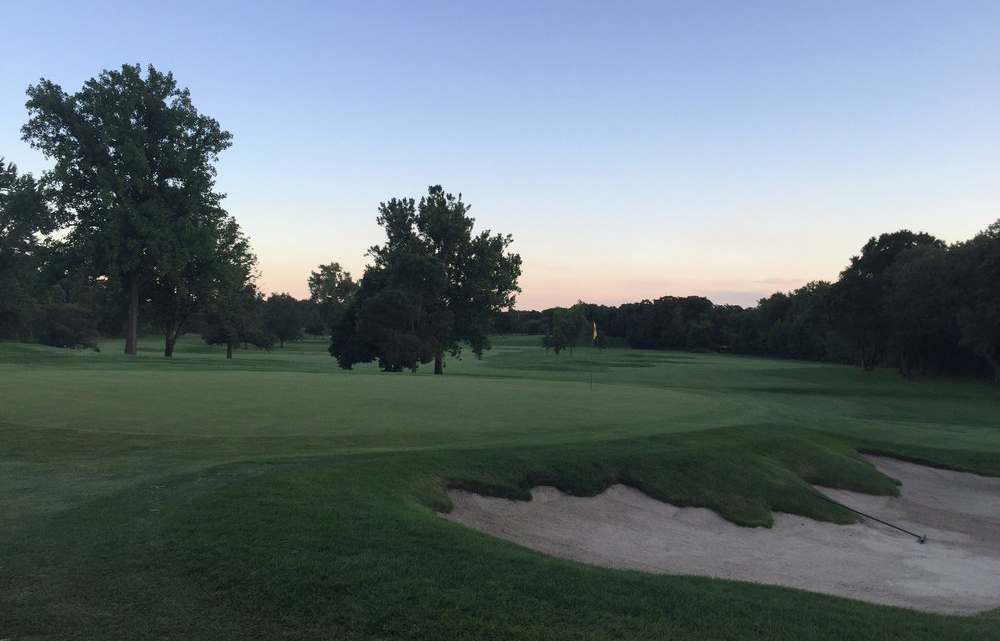
The subtly difficult green often leaves players scratching their heads
Reflecting on Flossmoor
I see something new at Flossmoor every round I play. The course has a spectacular blend of playability and challenge – it’s a quintessential “hard par, easy bogey” course. The majority of its driving corridors are extremely wide, but scoring well requires smart and strategic play. Unlike many brawny championship designs, Flossmoor has a nice variety of differing length par-3s and short and long par-4s that test all of the clubs in a player’s bag.
Unfortunately, the club is a victim of the economic downturn and a changing neighborhood demographic. These factors have turned what was once one of Chicago’s most prestigious clubs into one that’s offering discounted memberships in order to stay afloat. We think it the perfect candidate to fully adopt to U.K. model, allowing guest play for those who politely ask and comport themselves appropriately.
While Flossmoor might get lost among the many great private golf courses in Chicagoland, it’s certainly one of the best. Our hope is that the club finds a way to thrive and continue to fine tune the presentation. It is a joy to play repeatedly, revealing more with each loop around.
Sign Up for The Fried Egg Newsletter
The Fried Egg Newsletter is the best way to stay up to date on all things golf. Delivered every Monday, Wednesday, and Friday for free!


 by
by 
